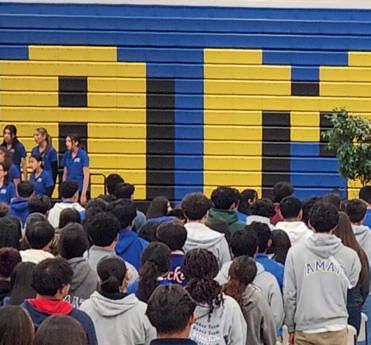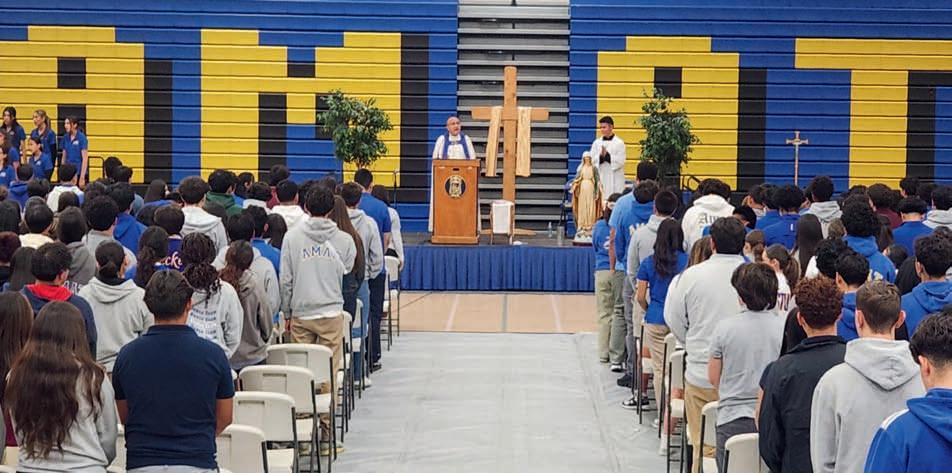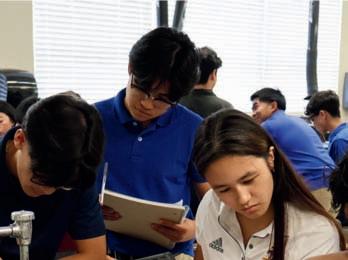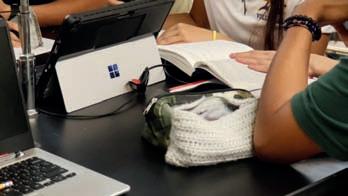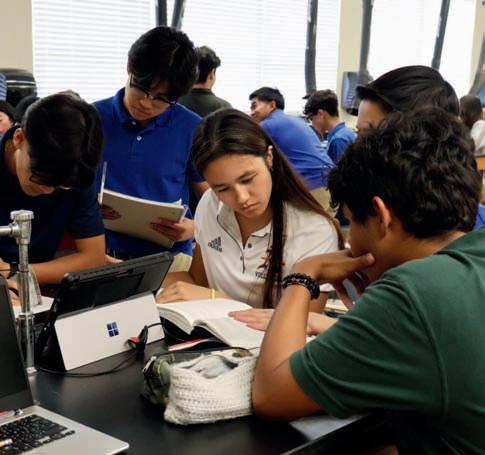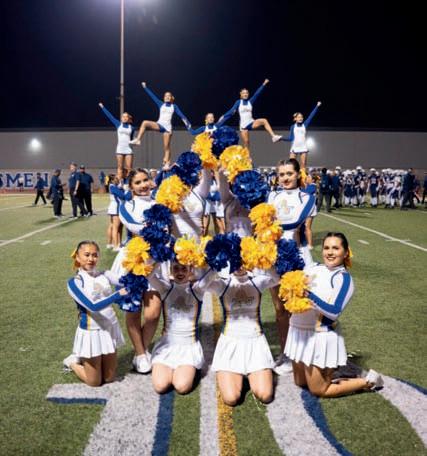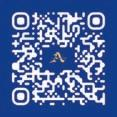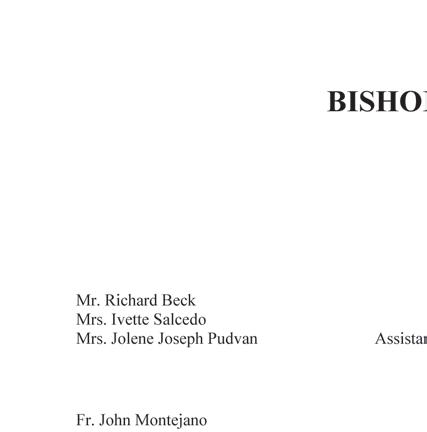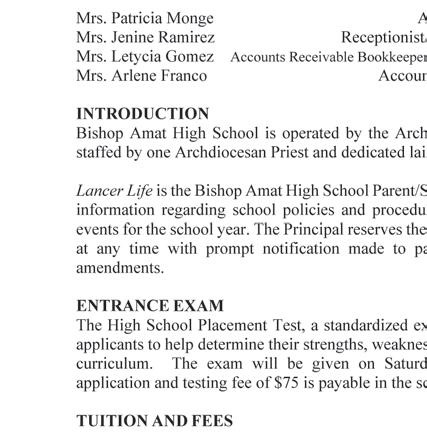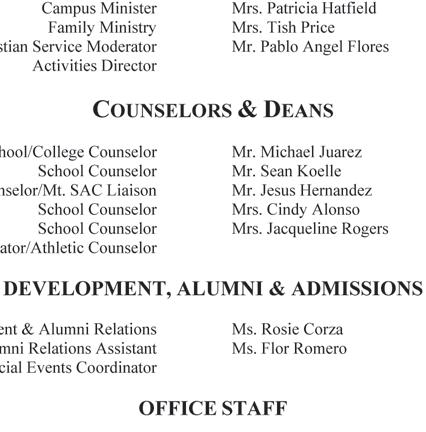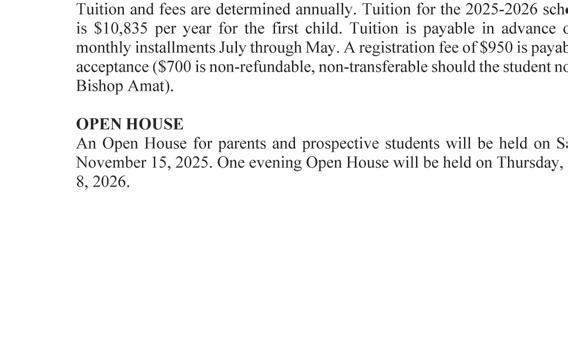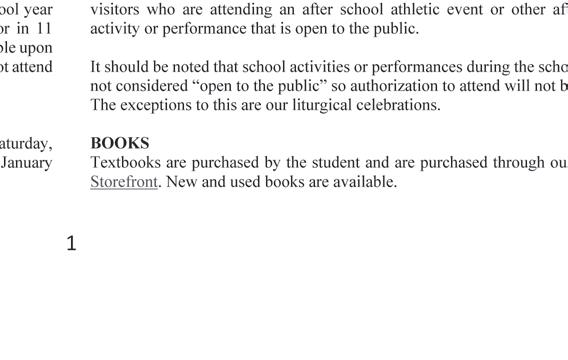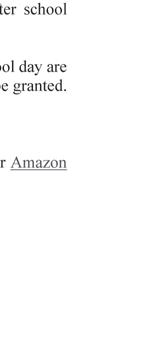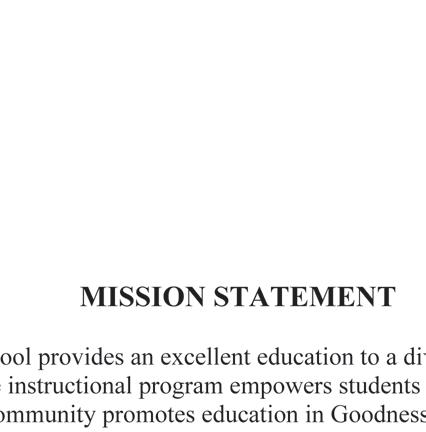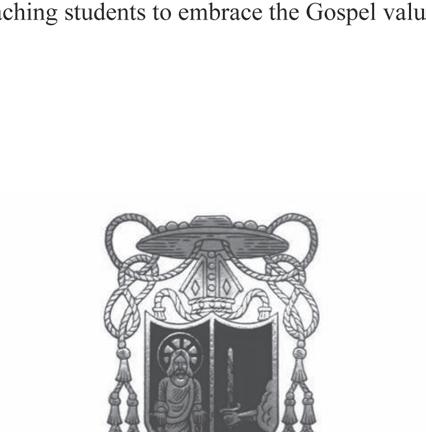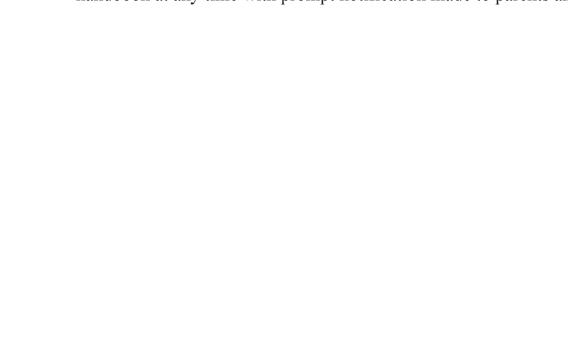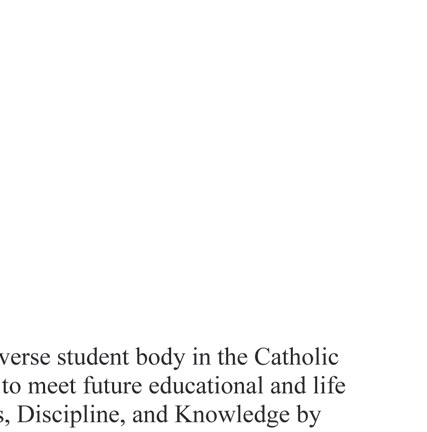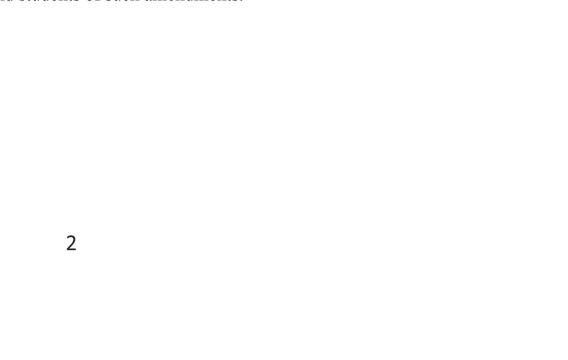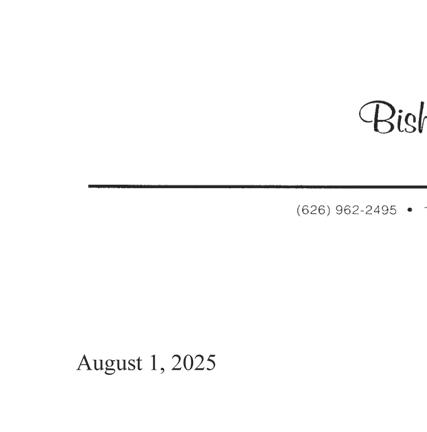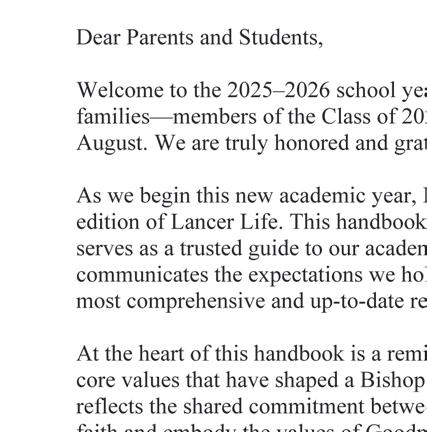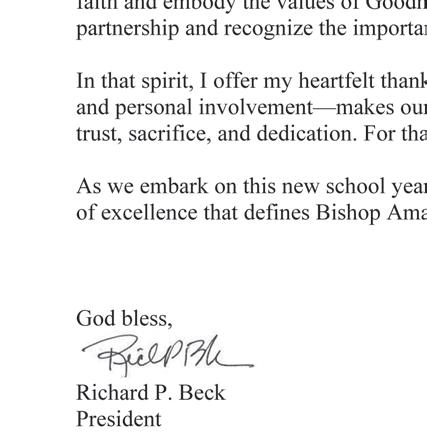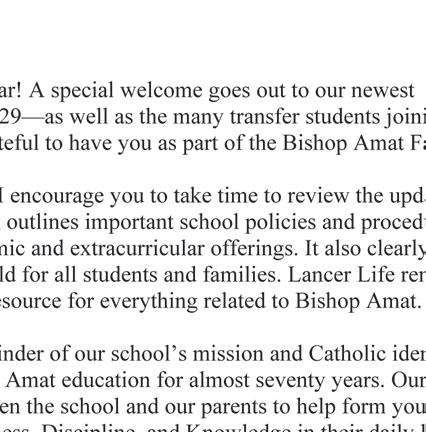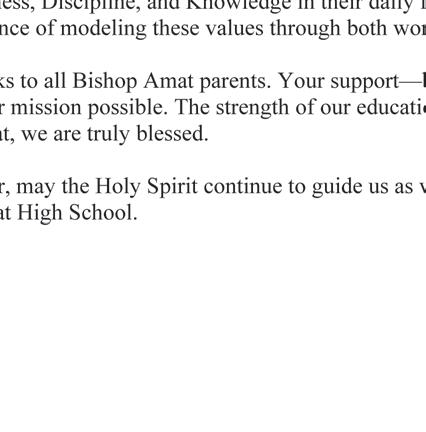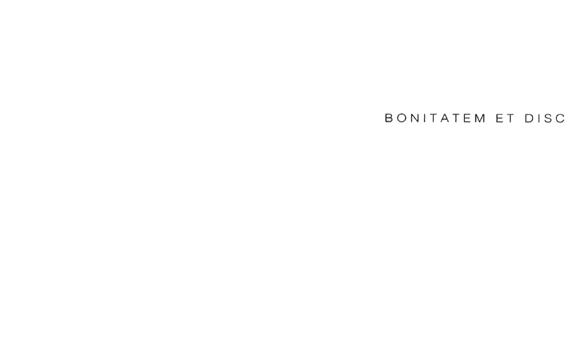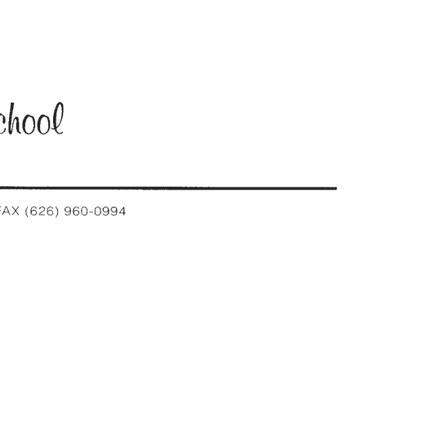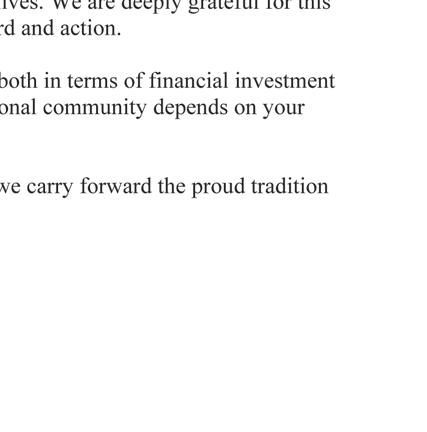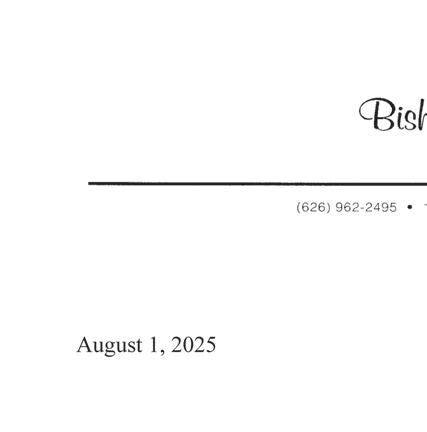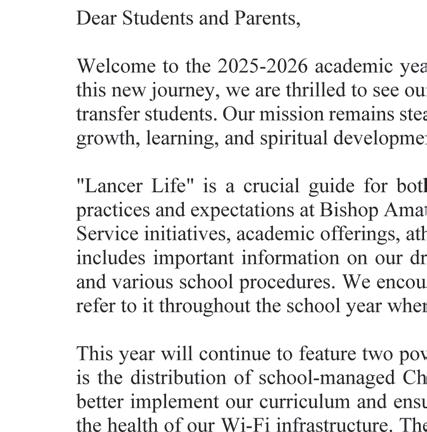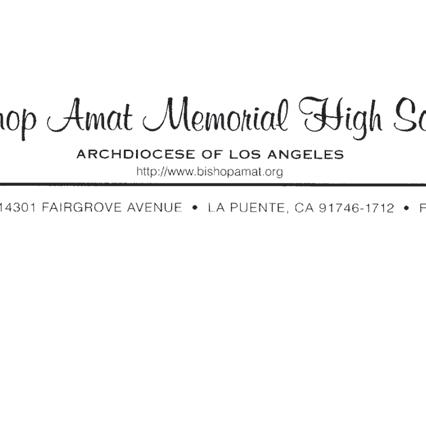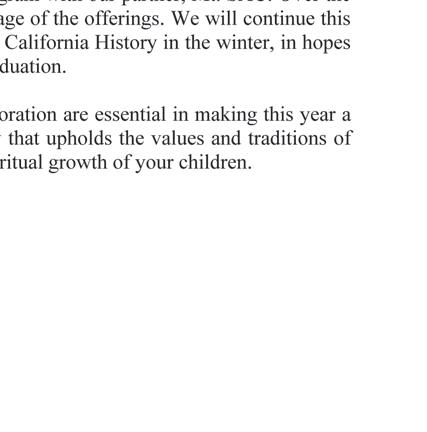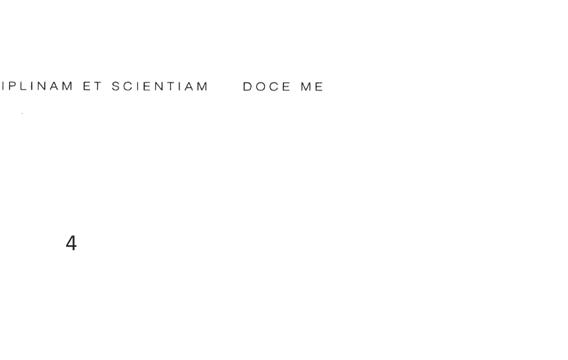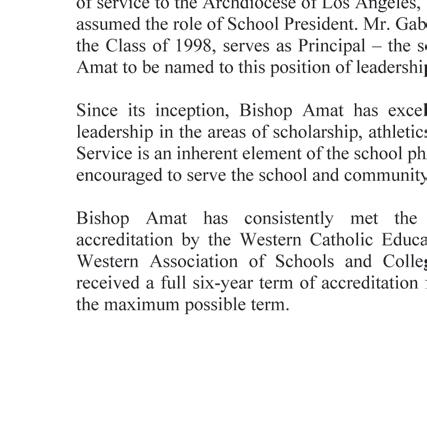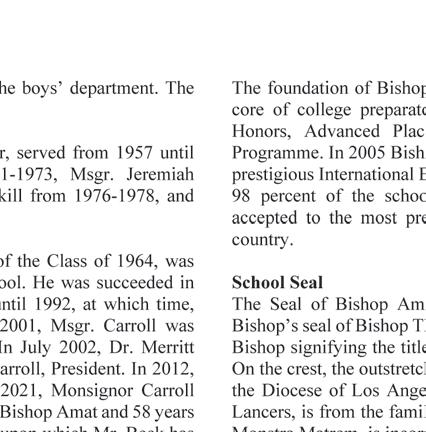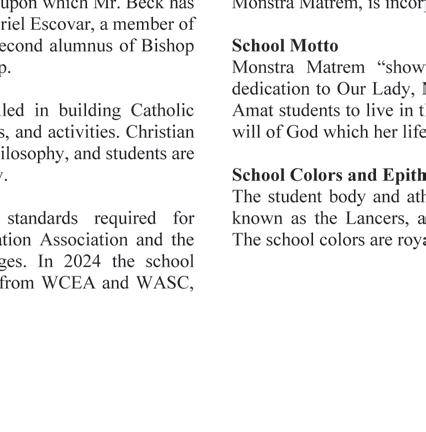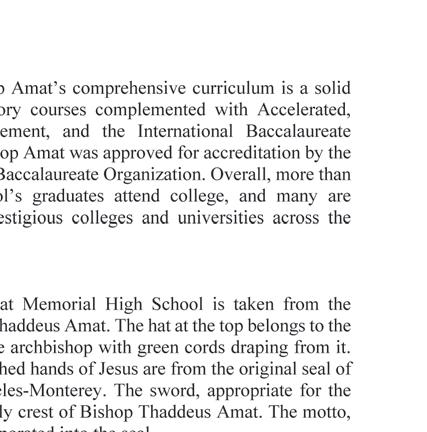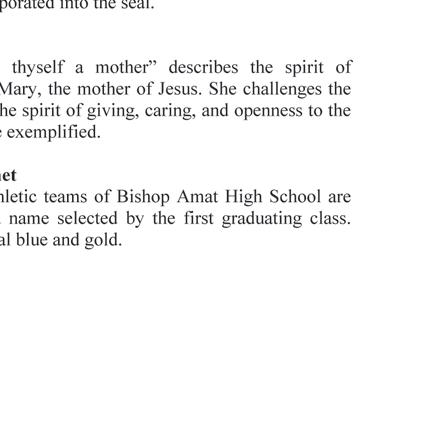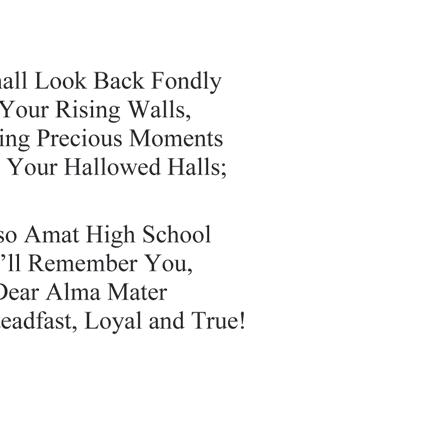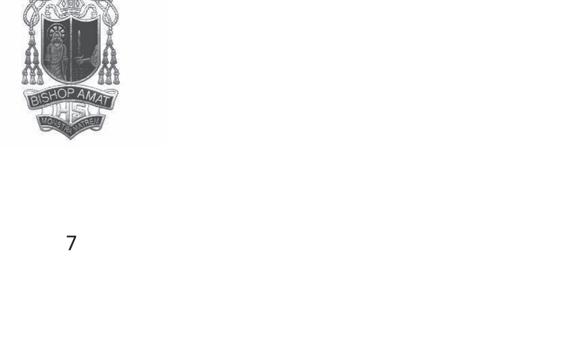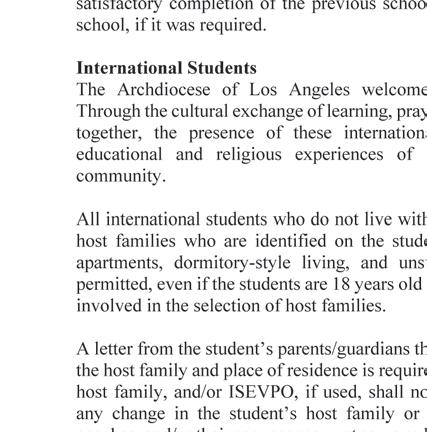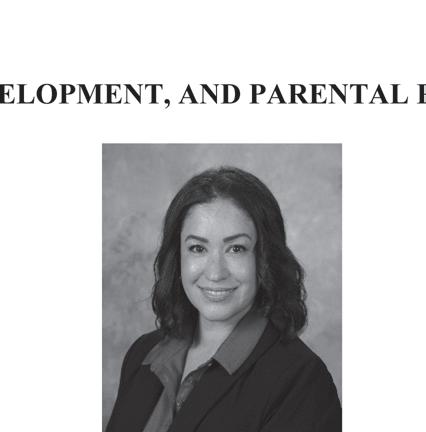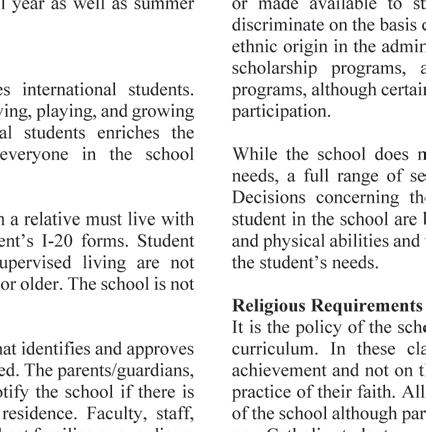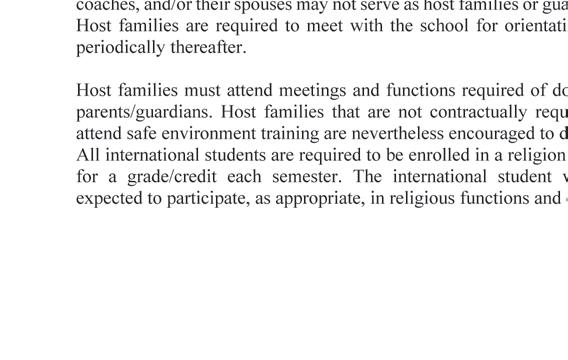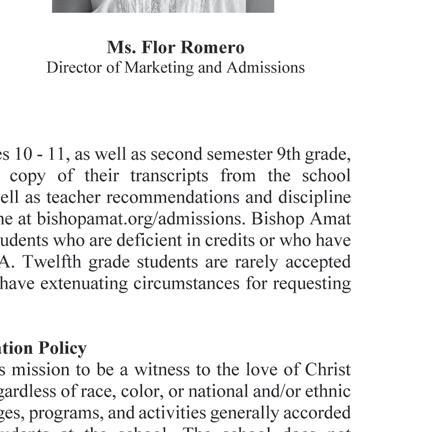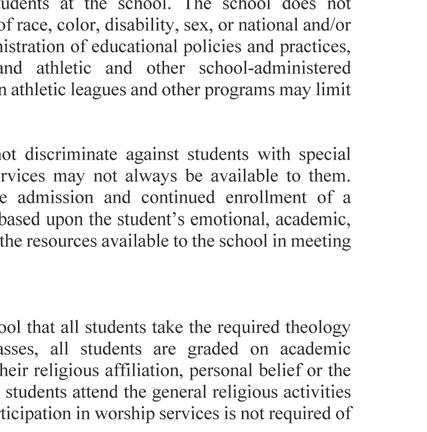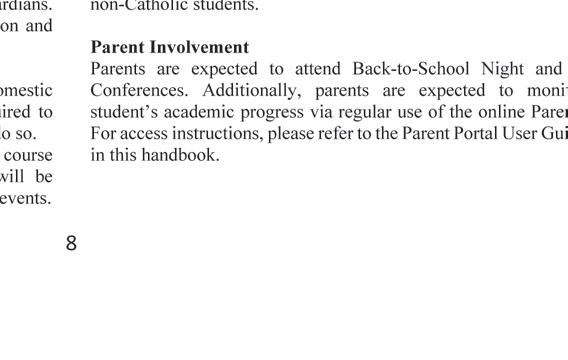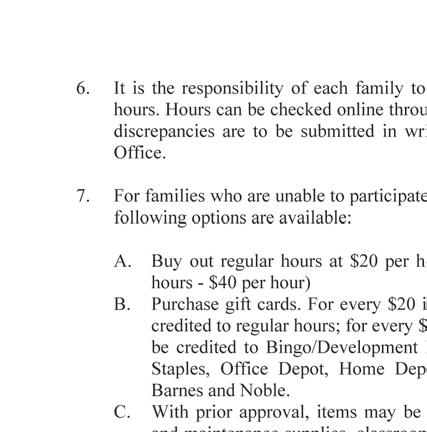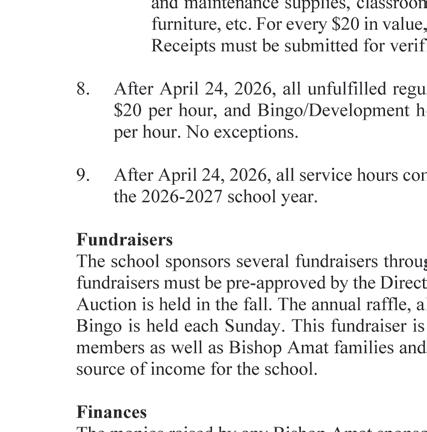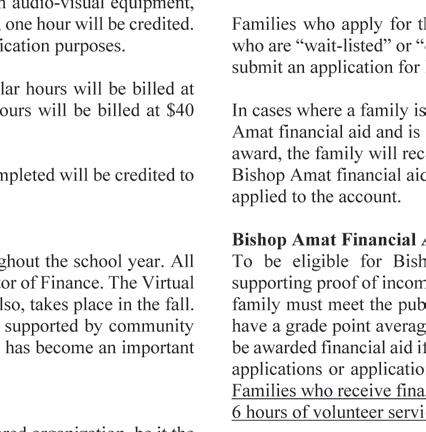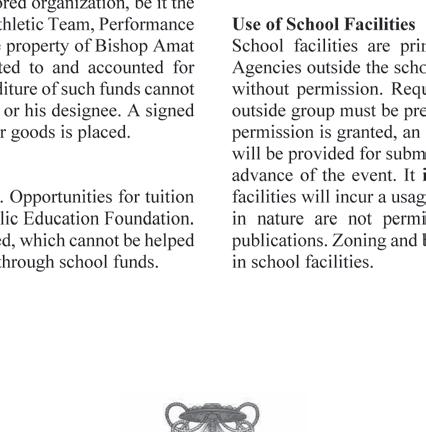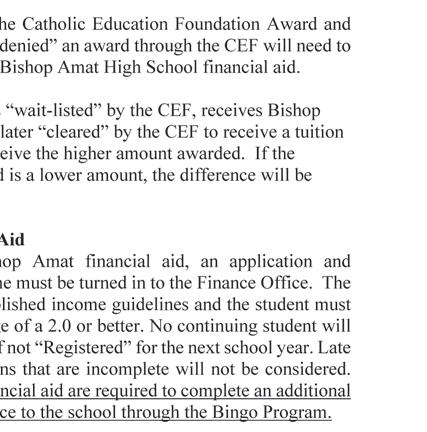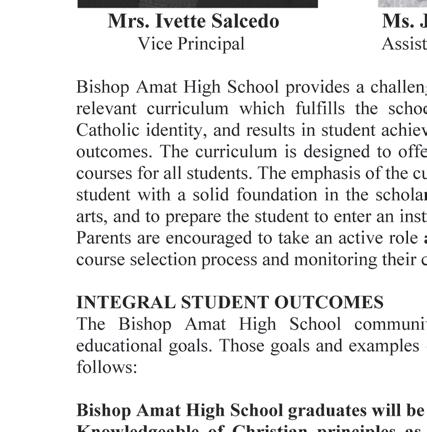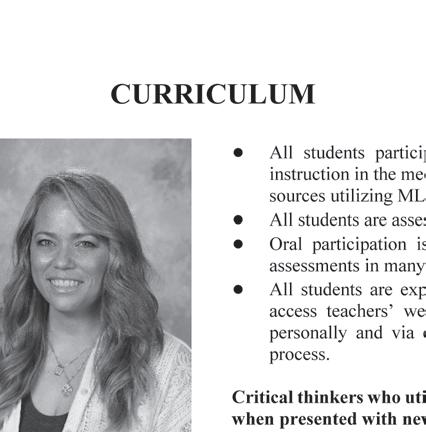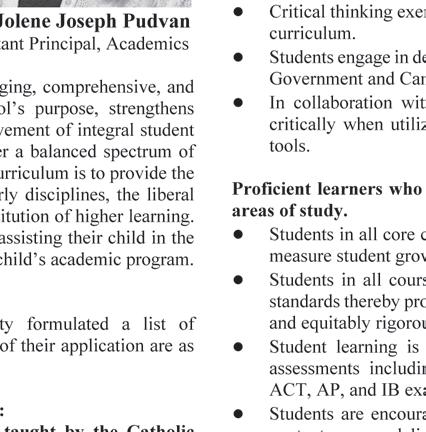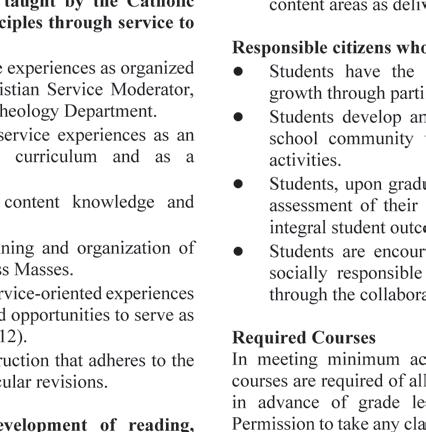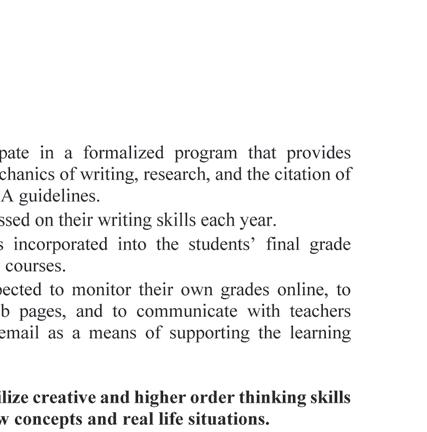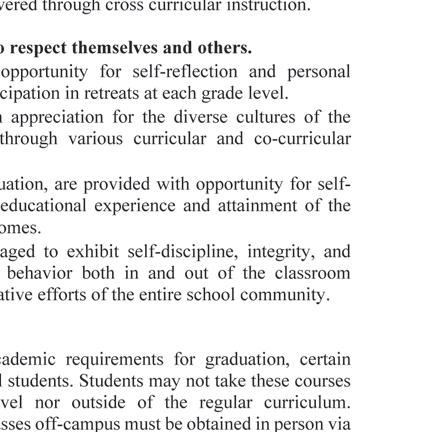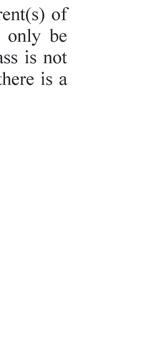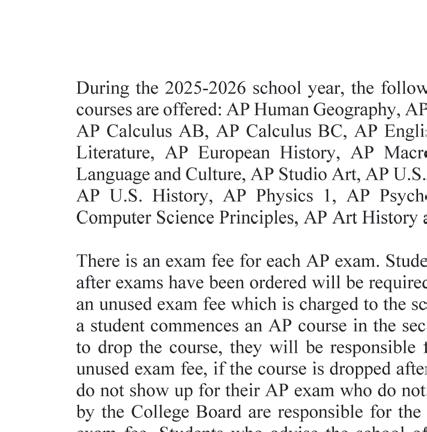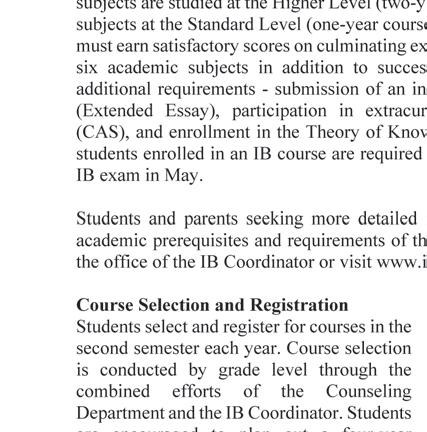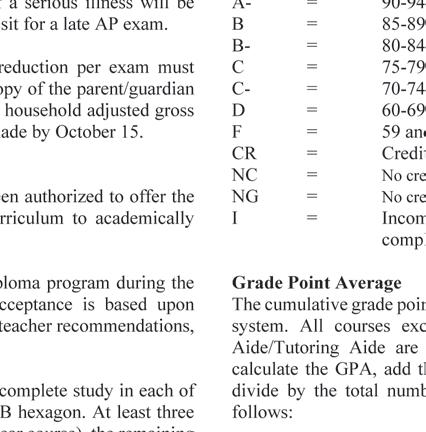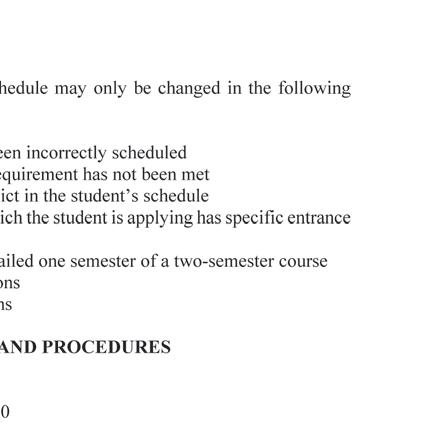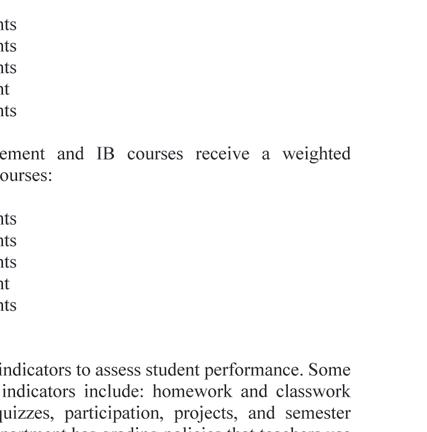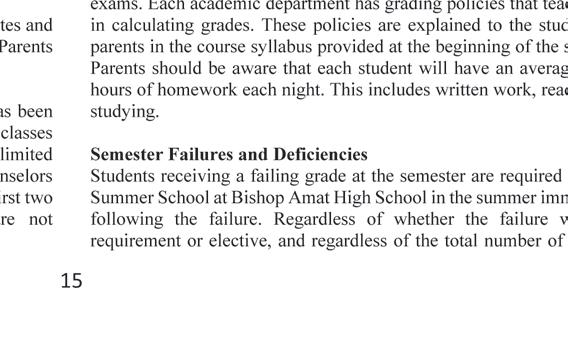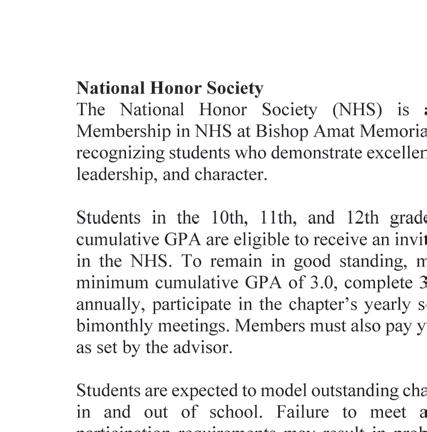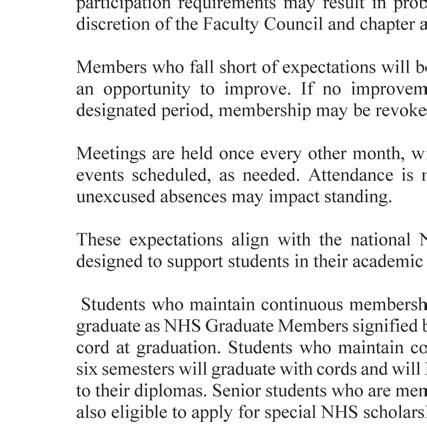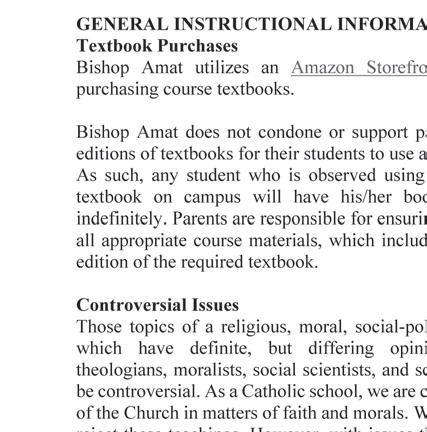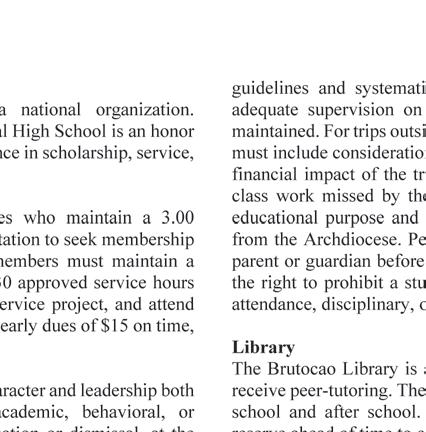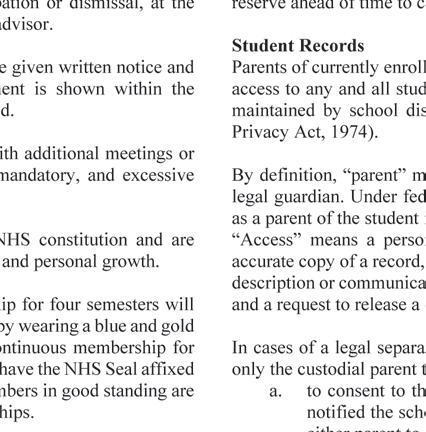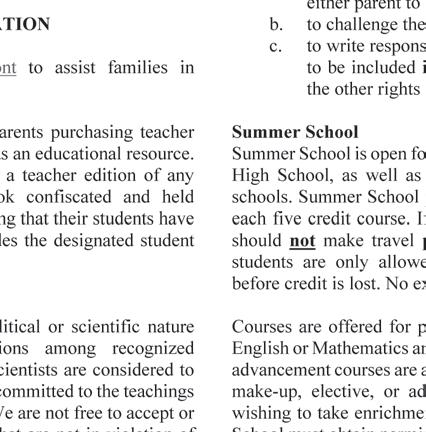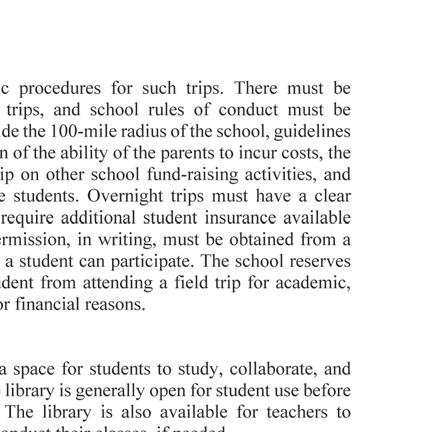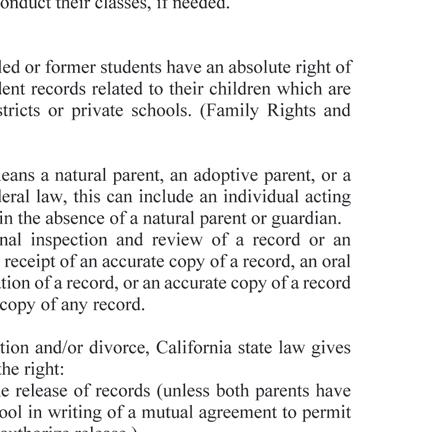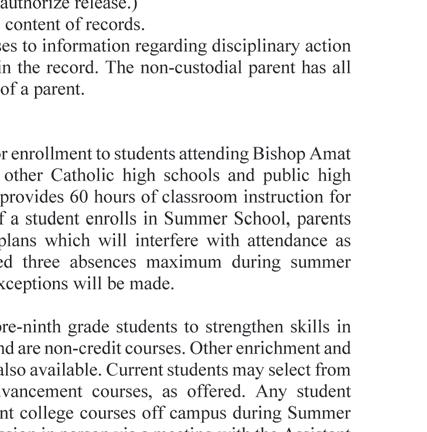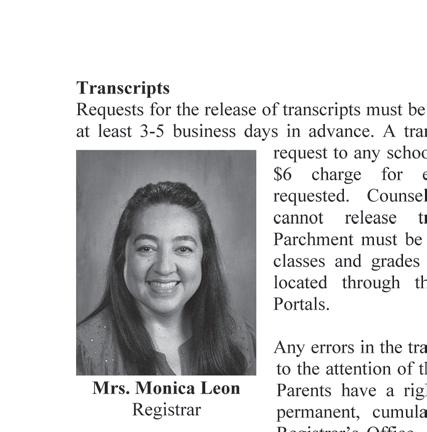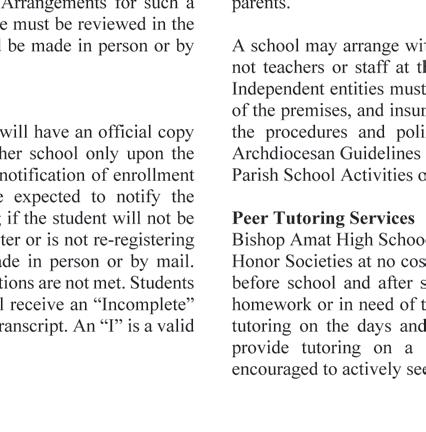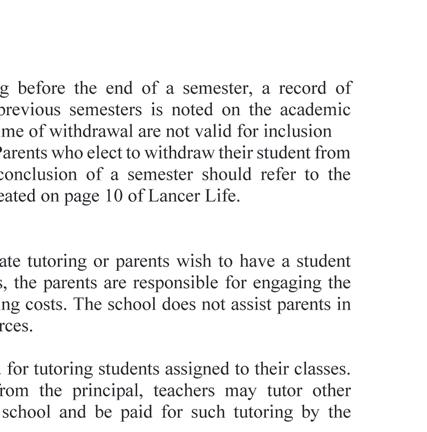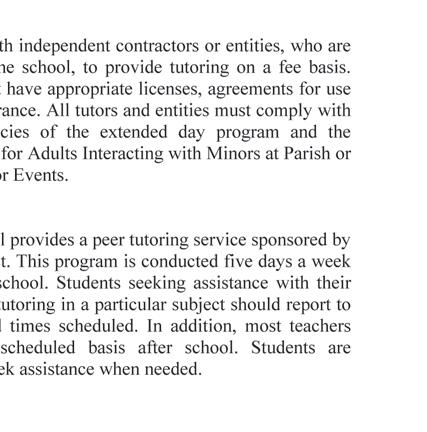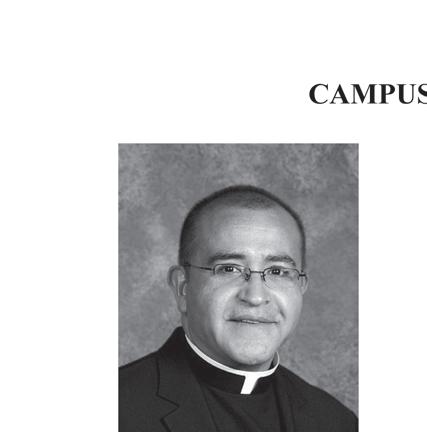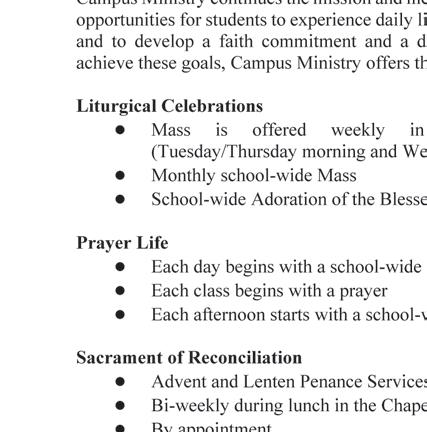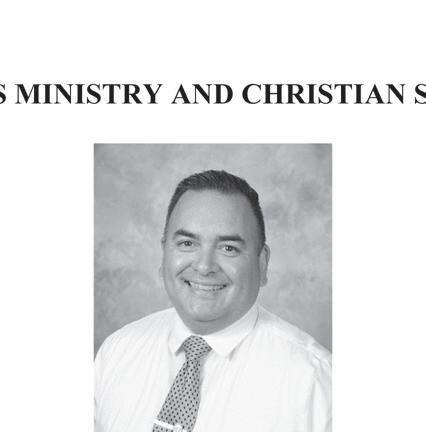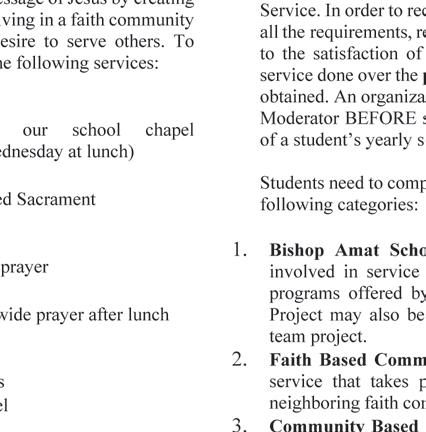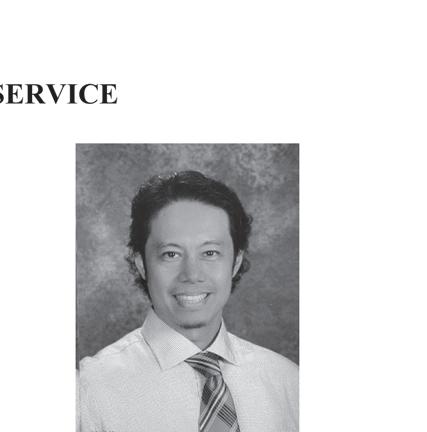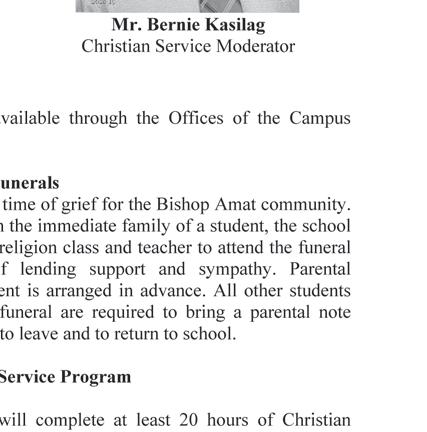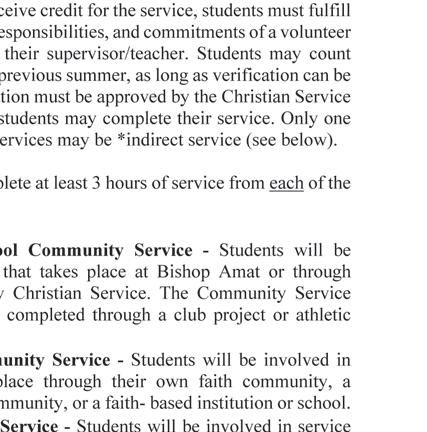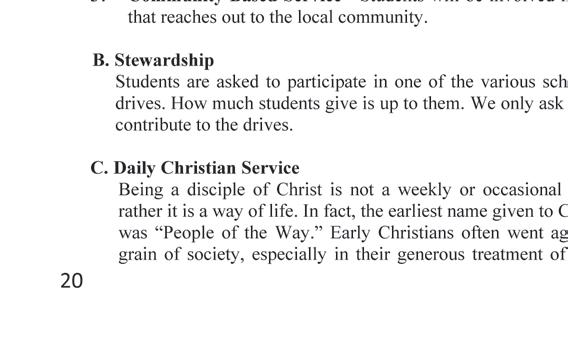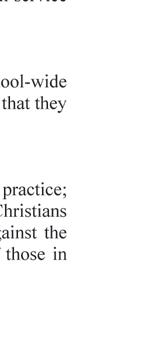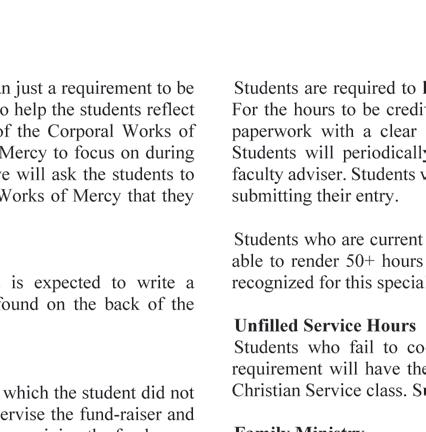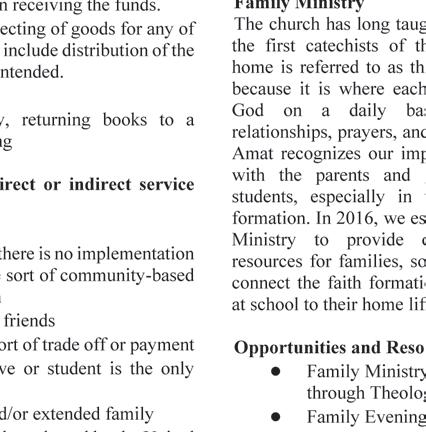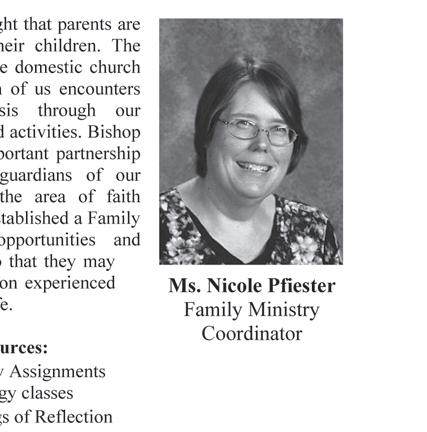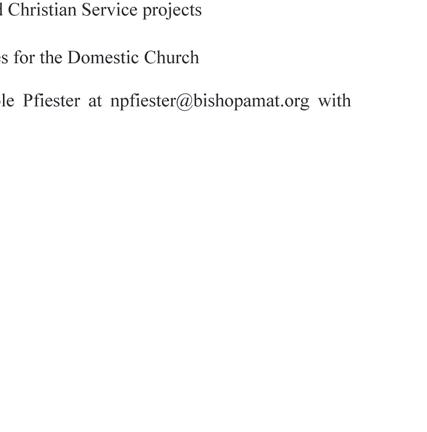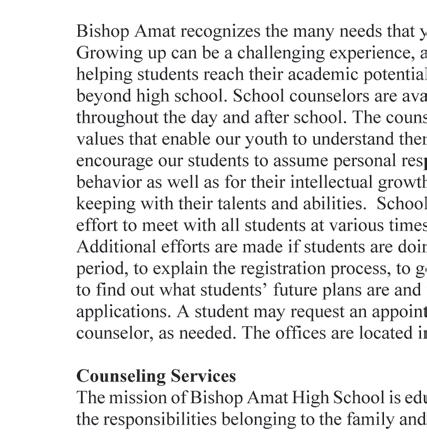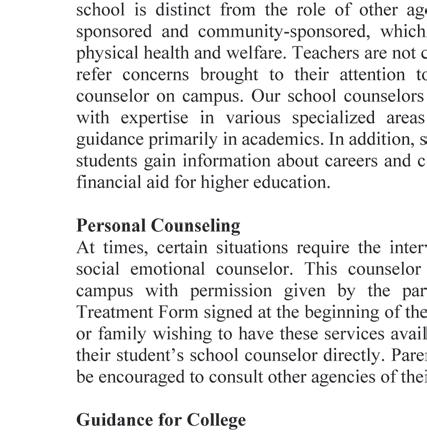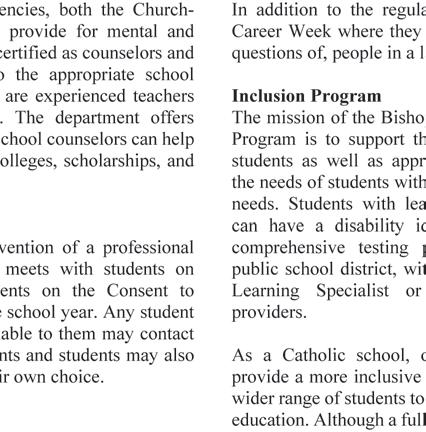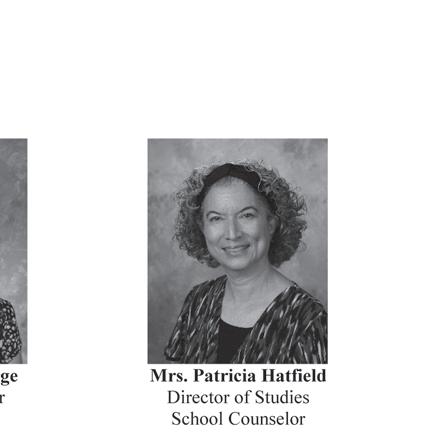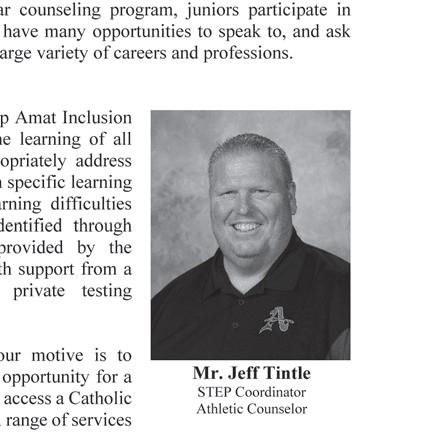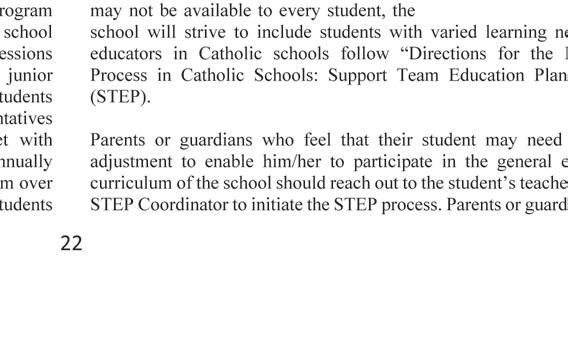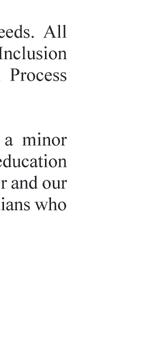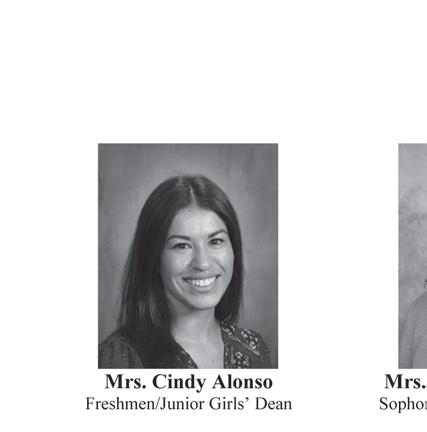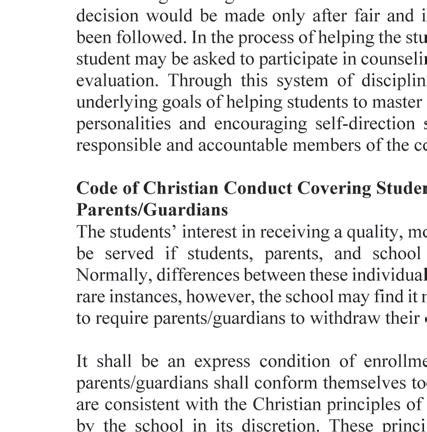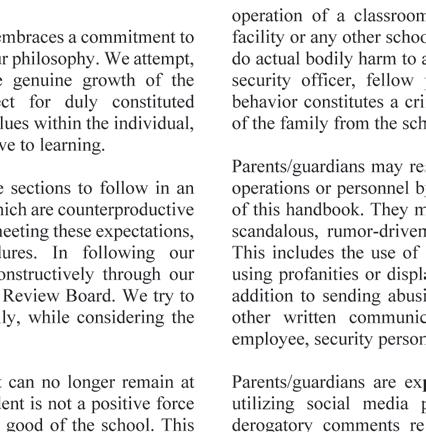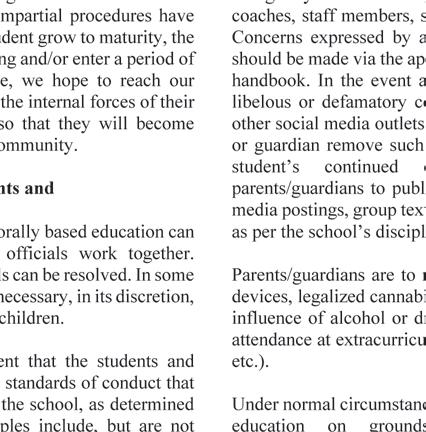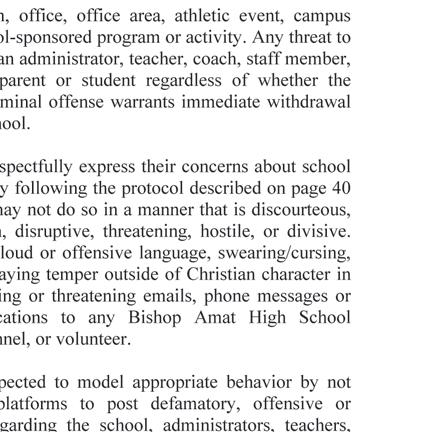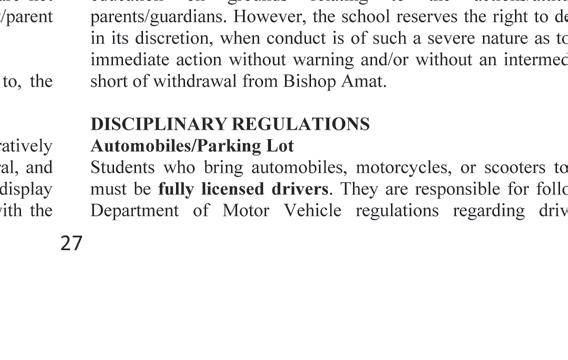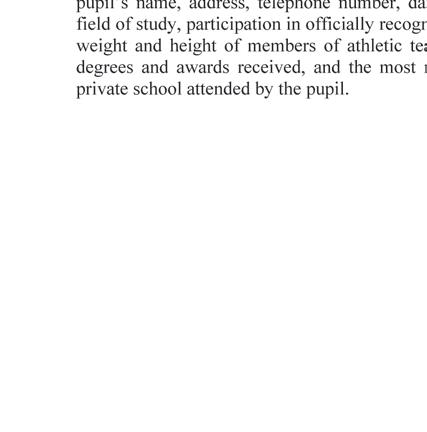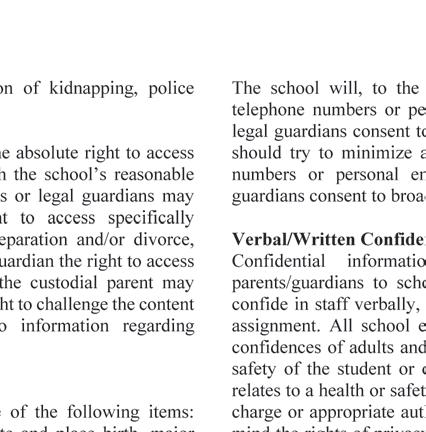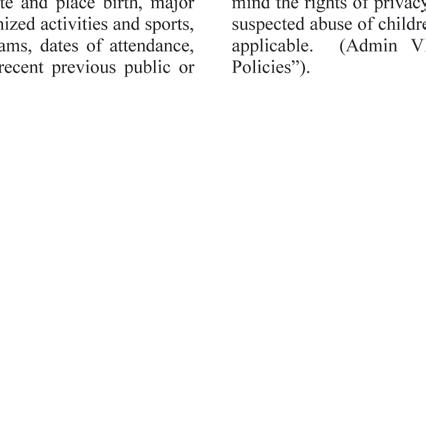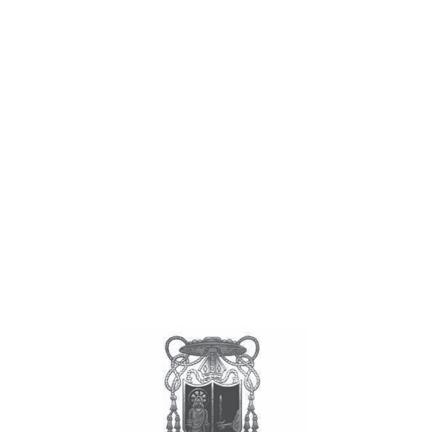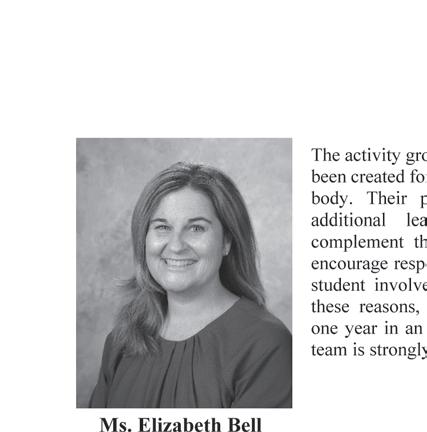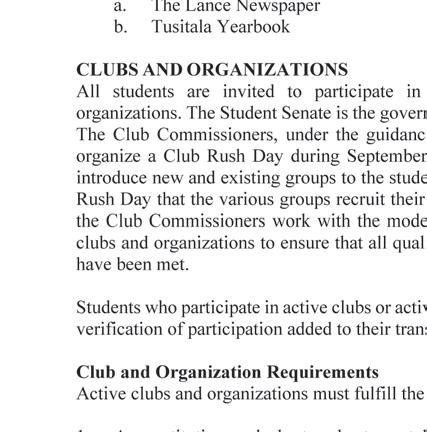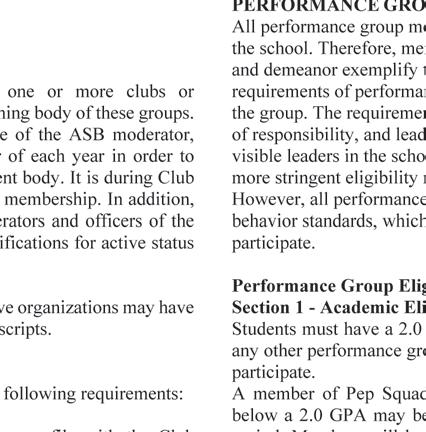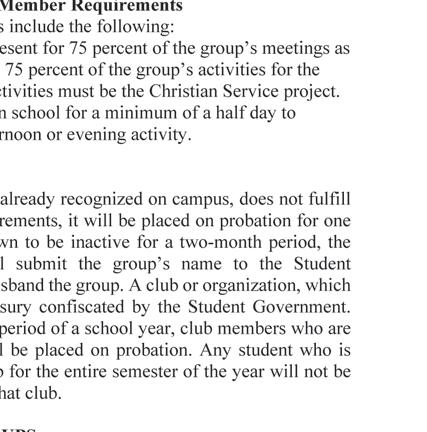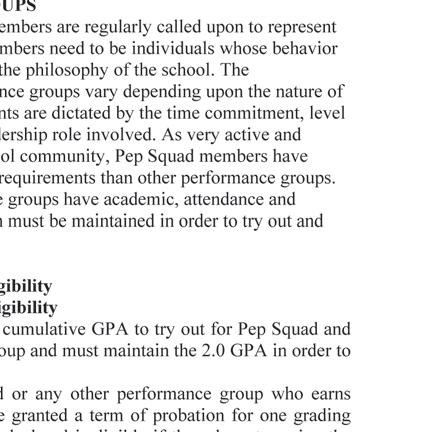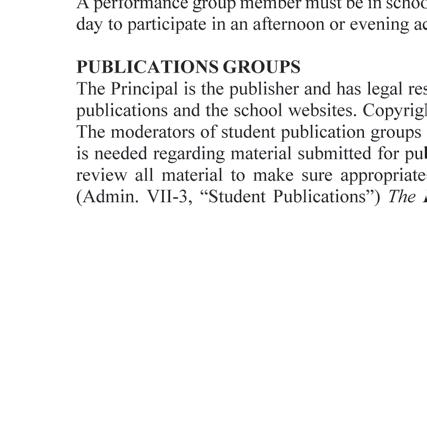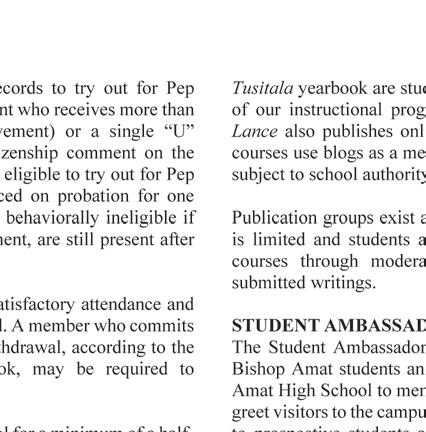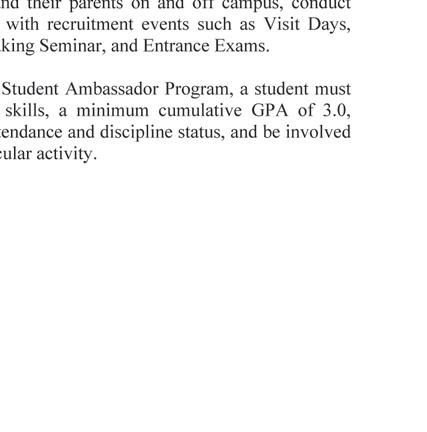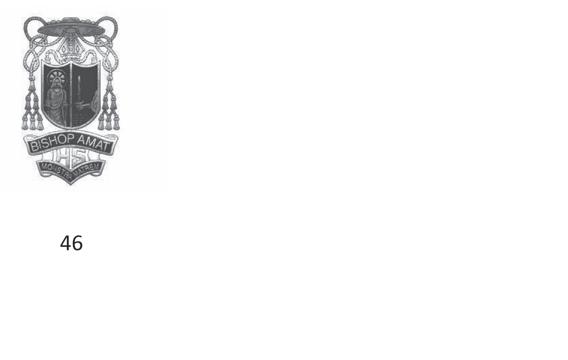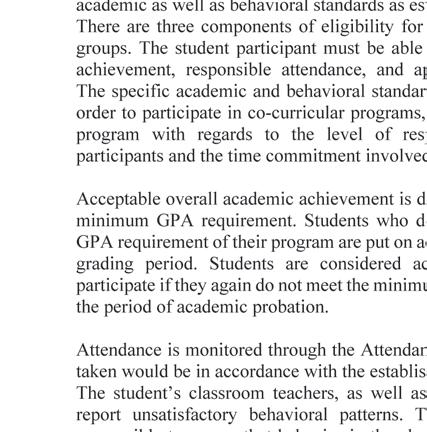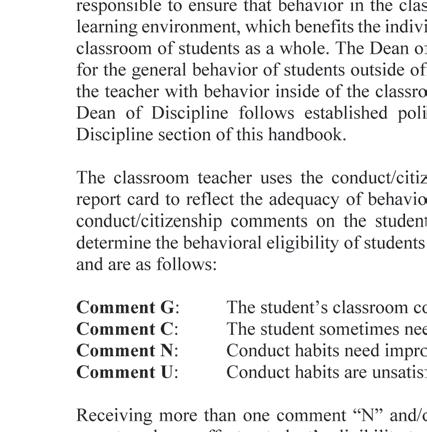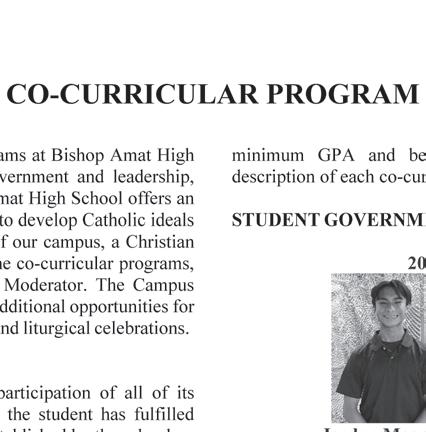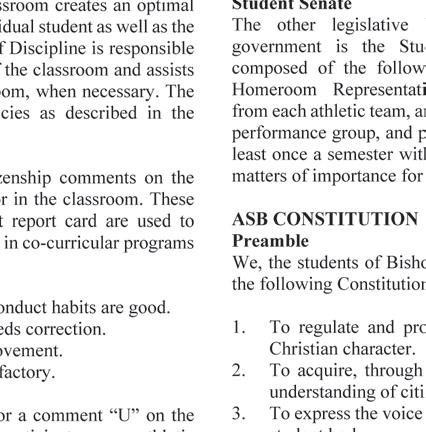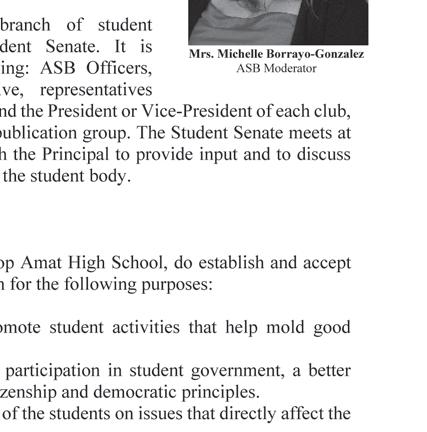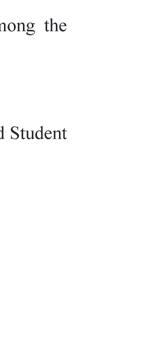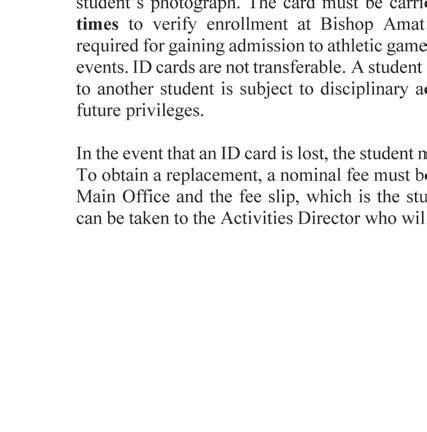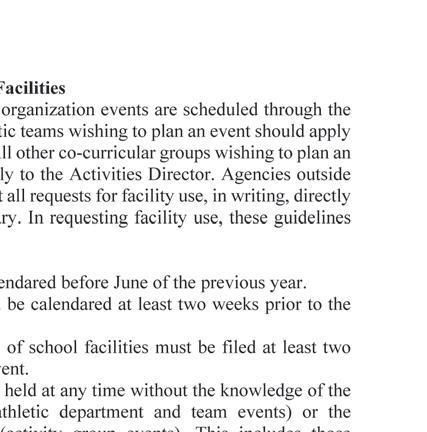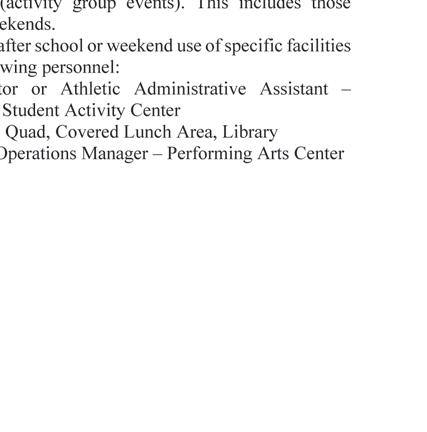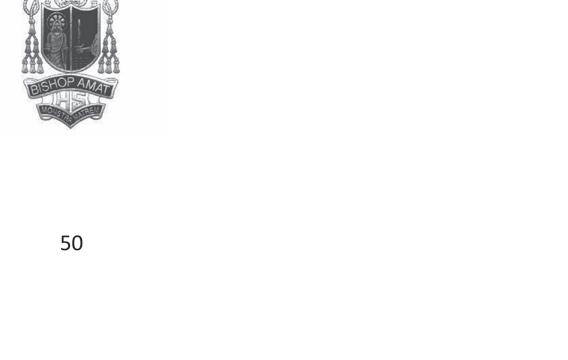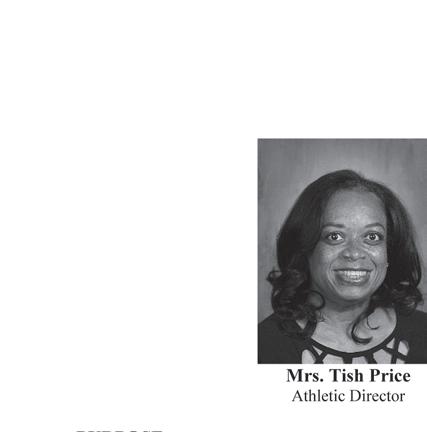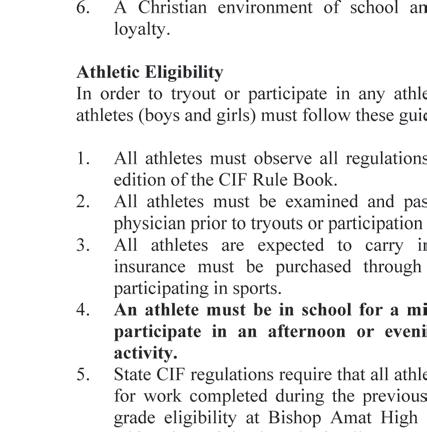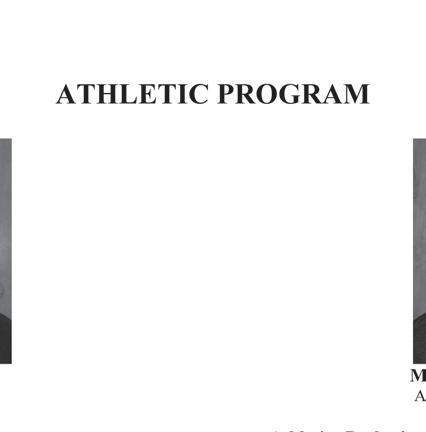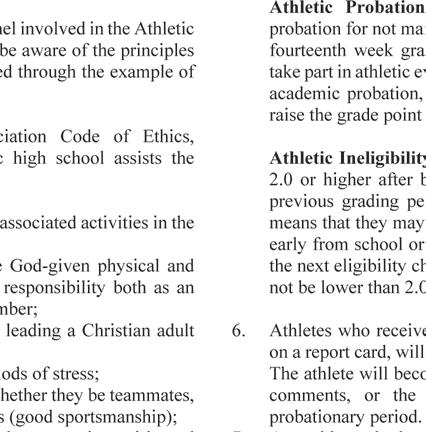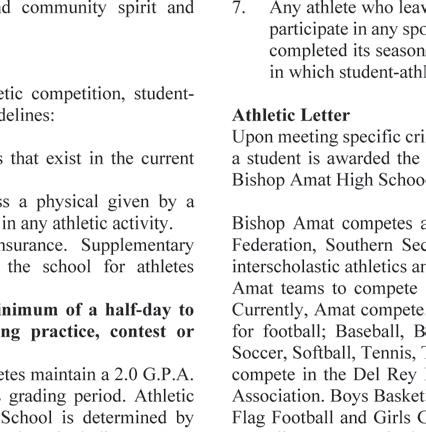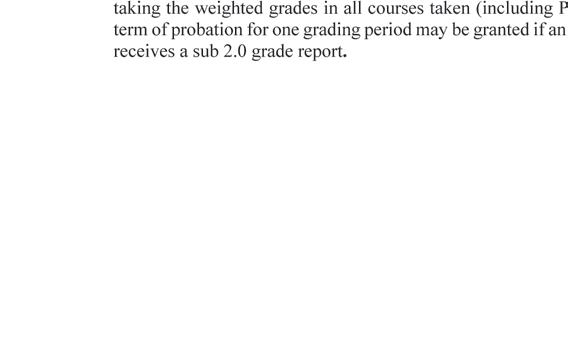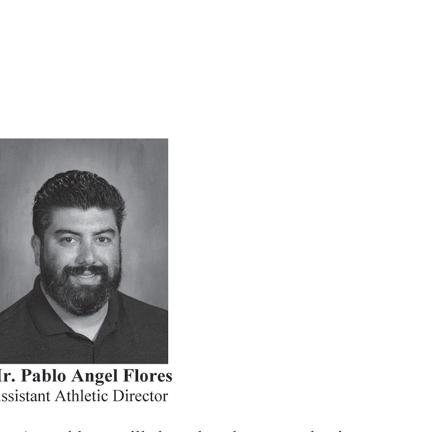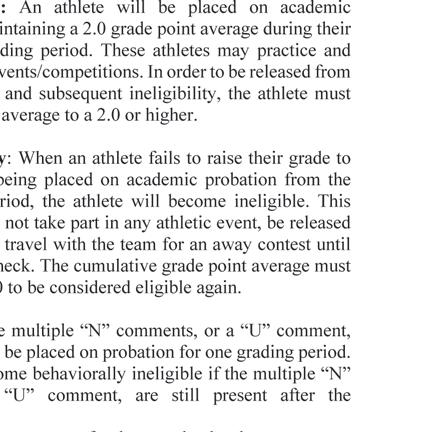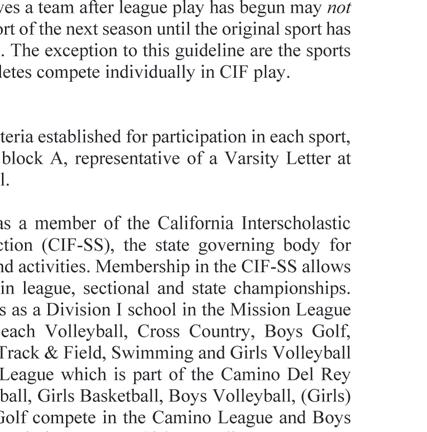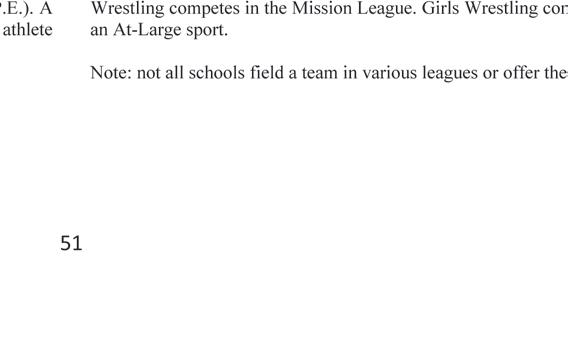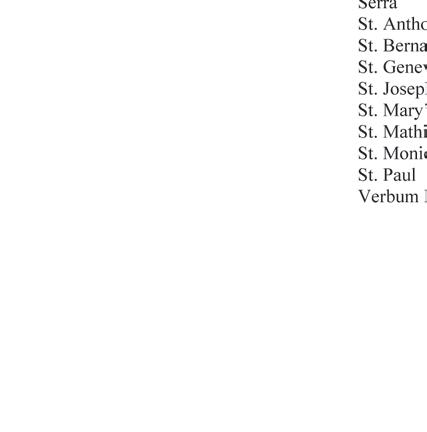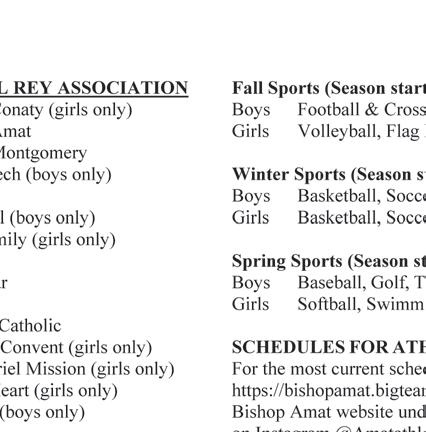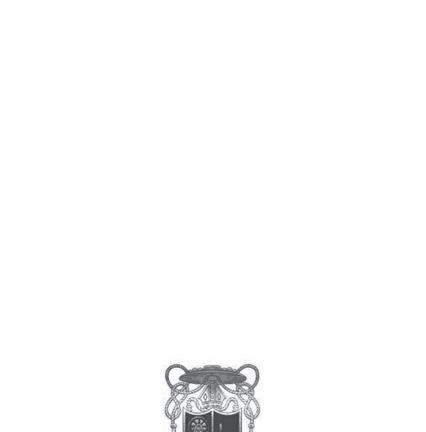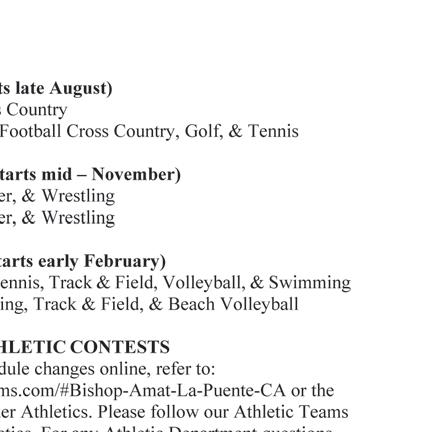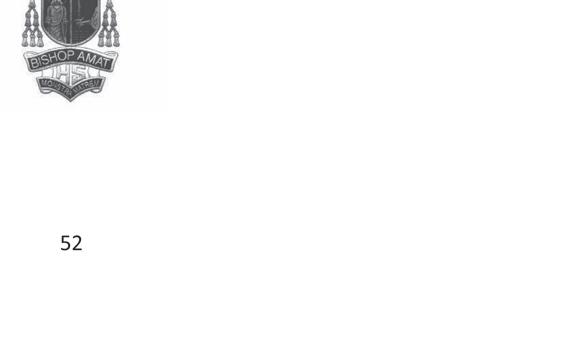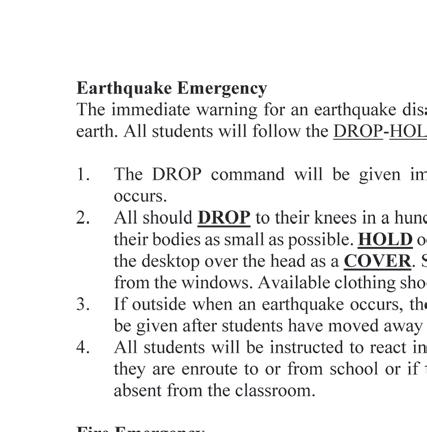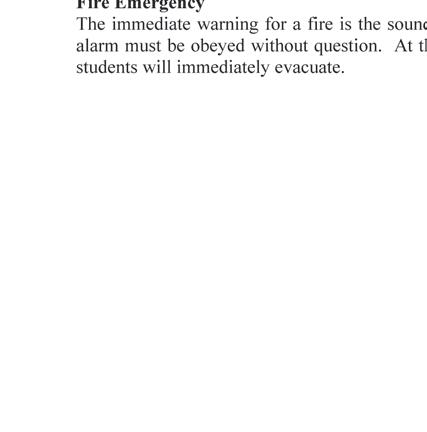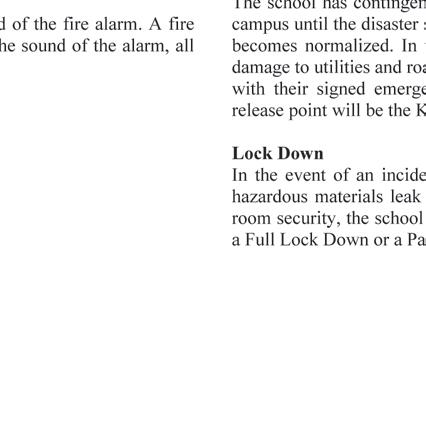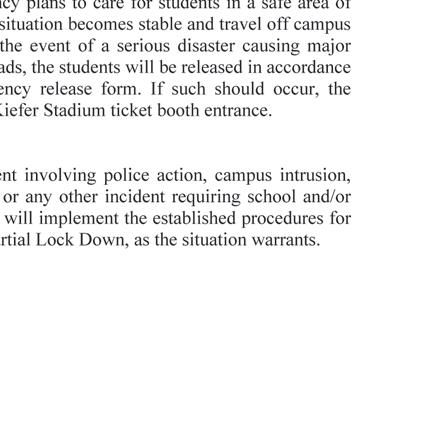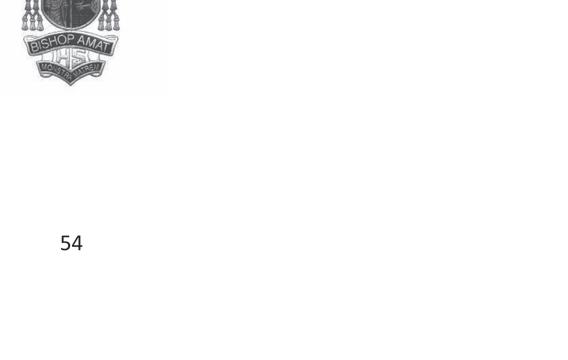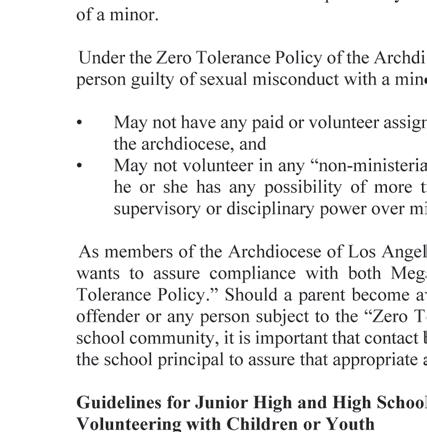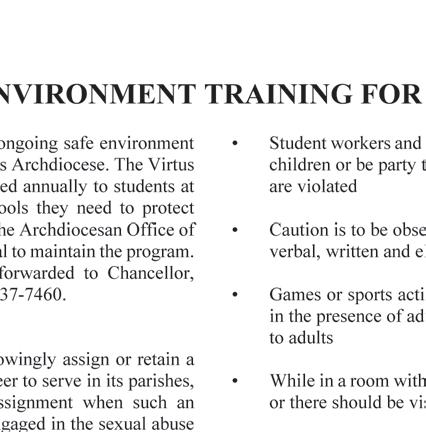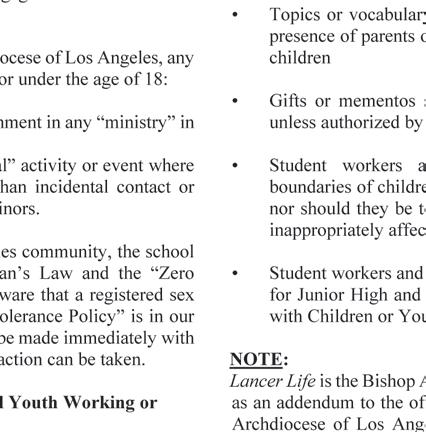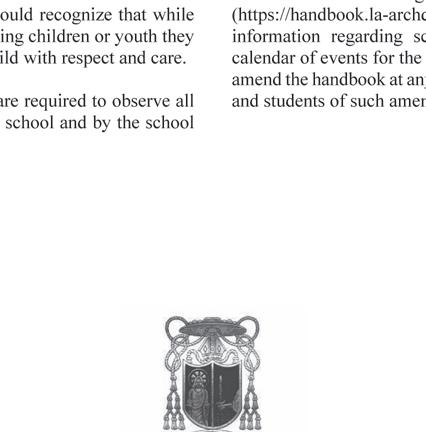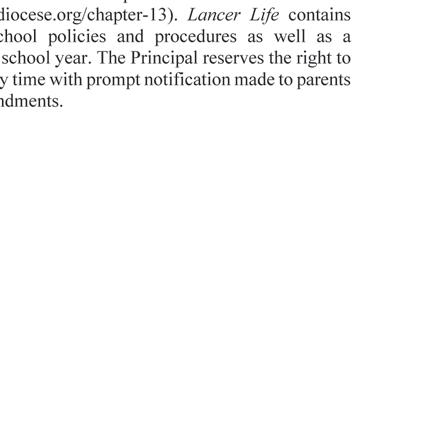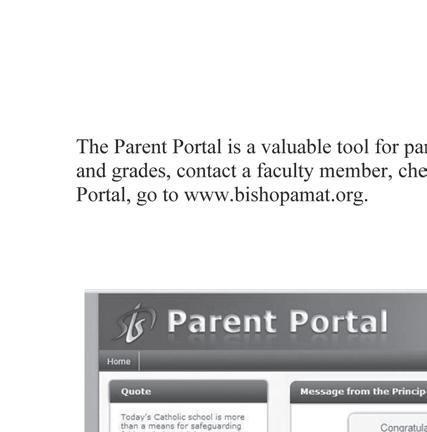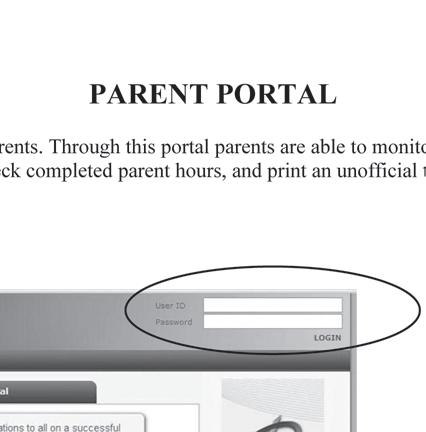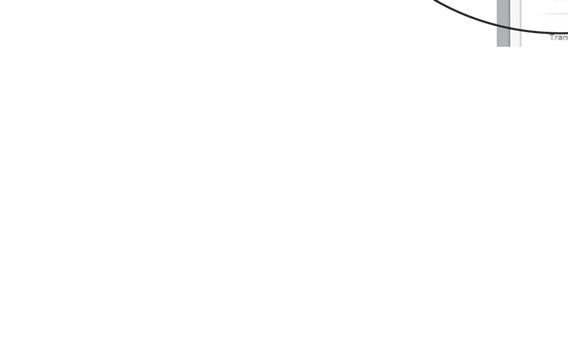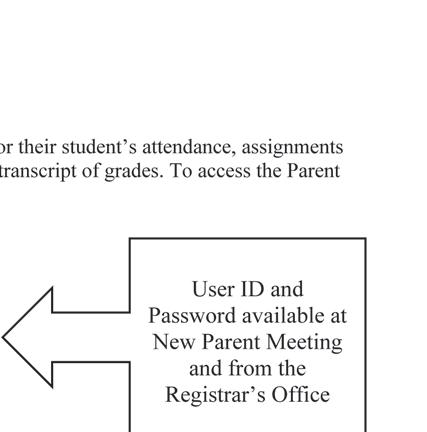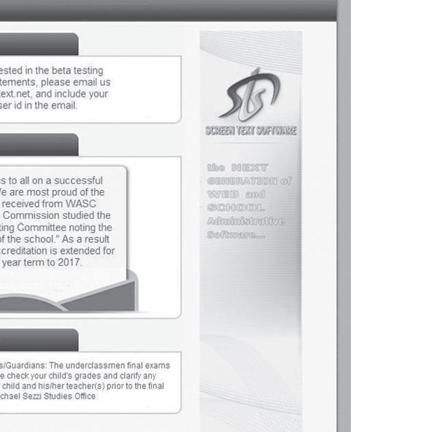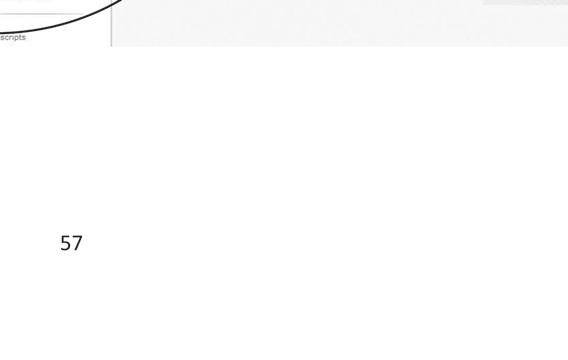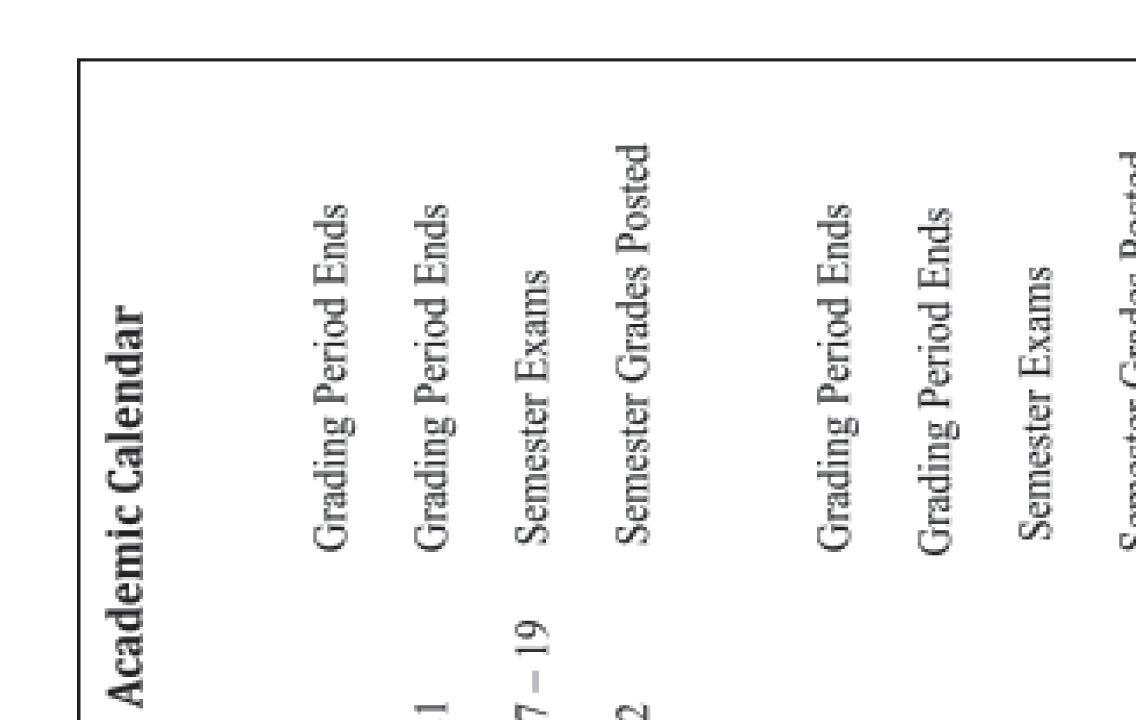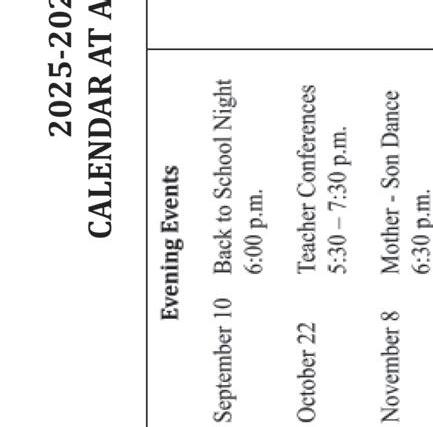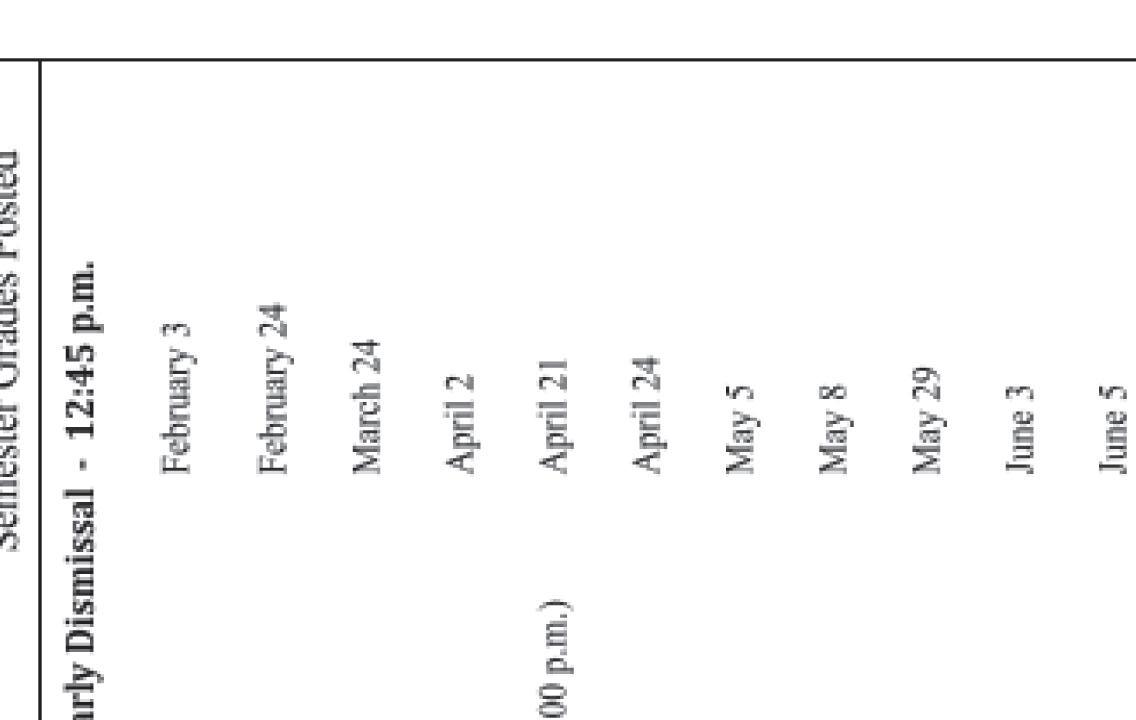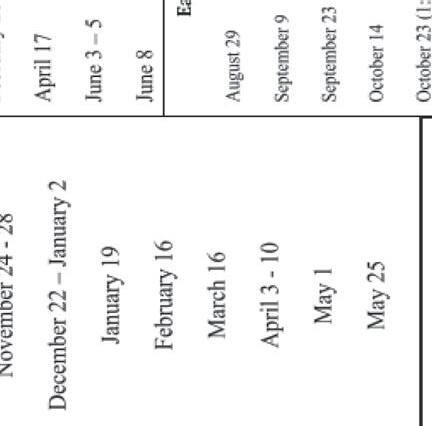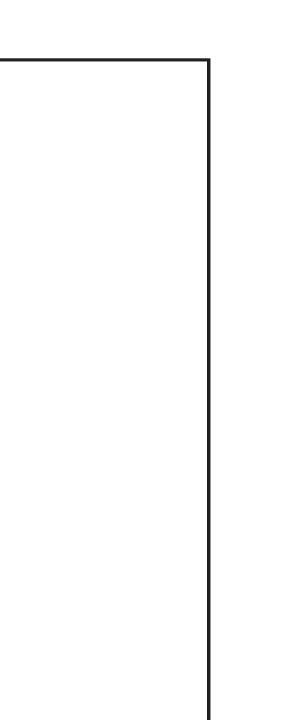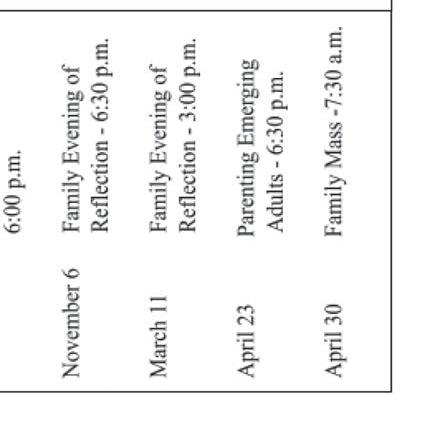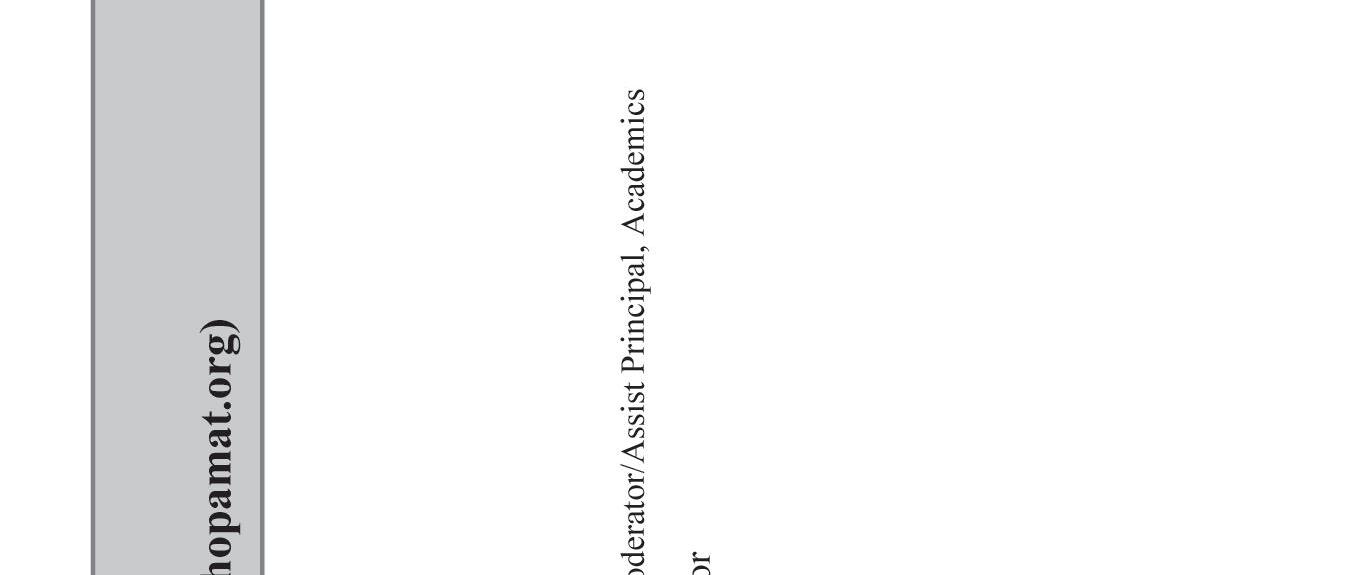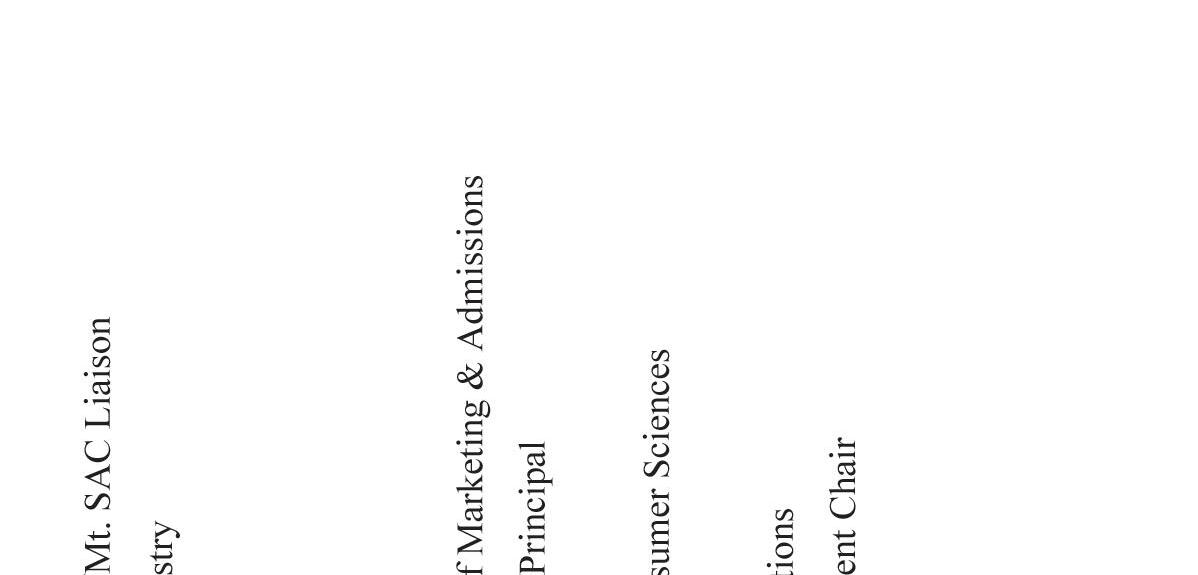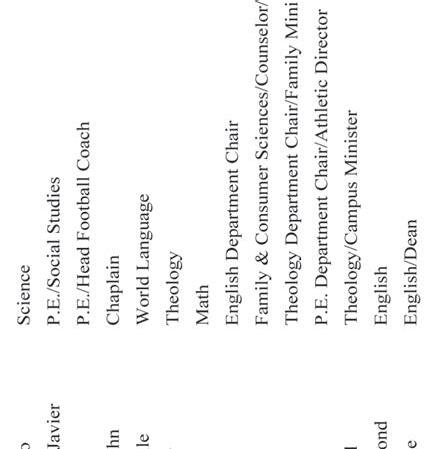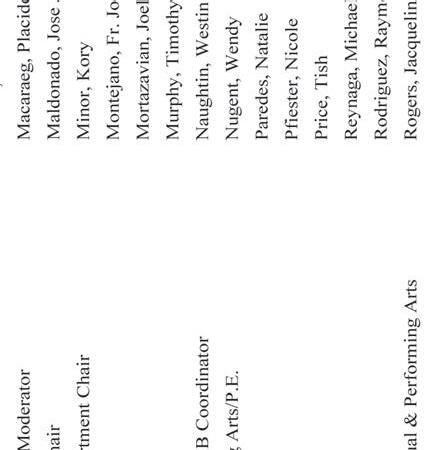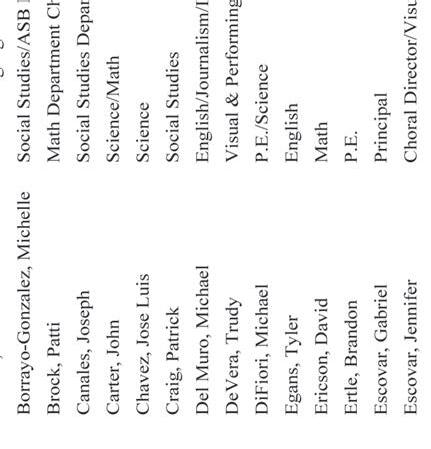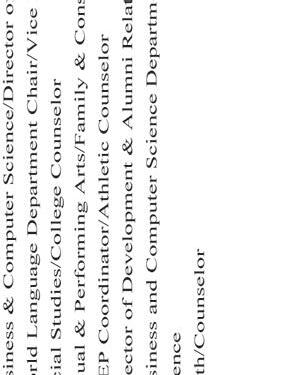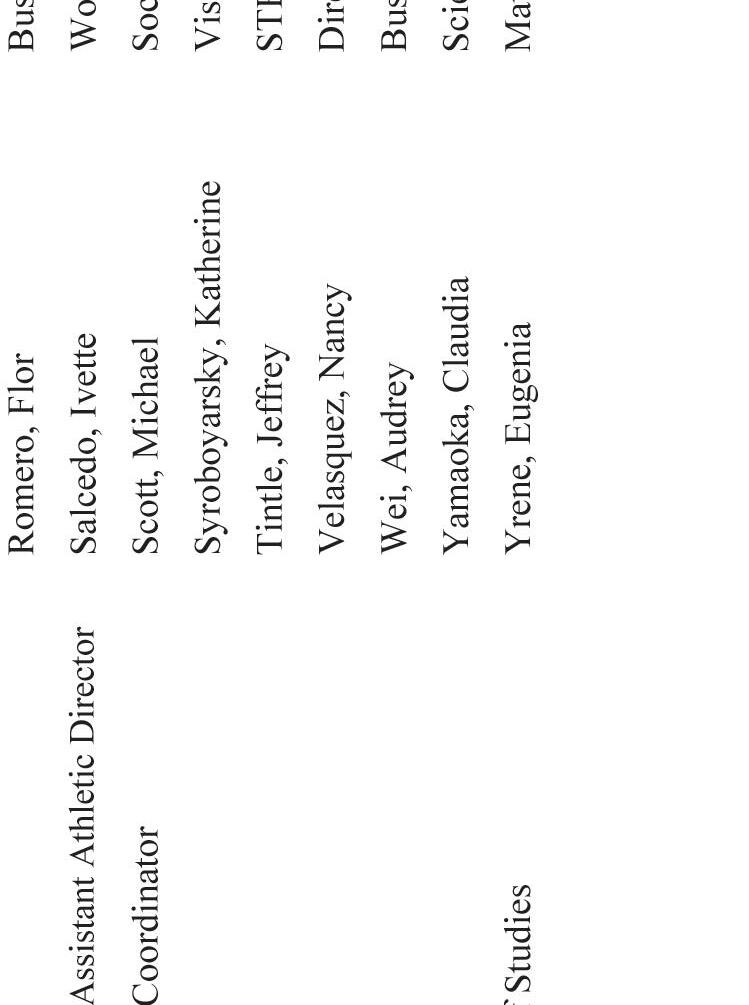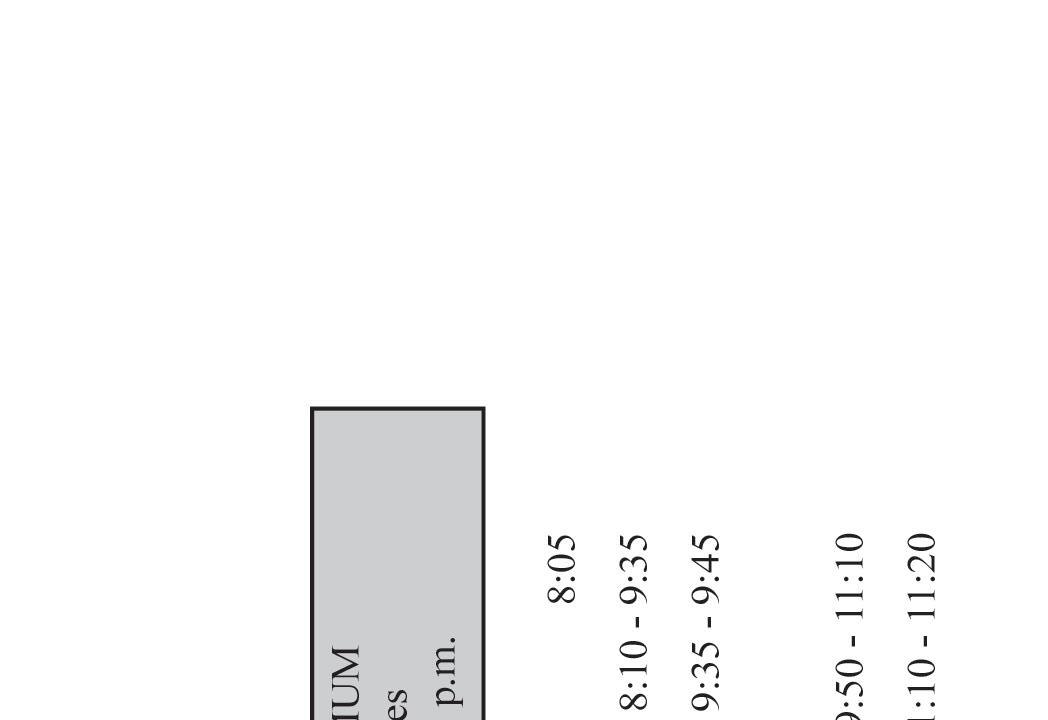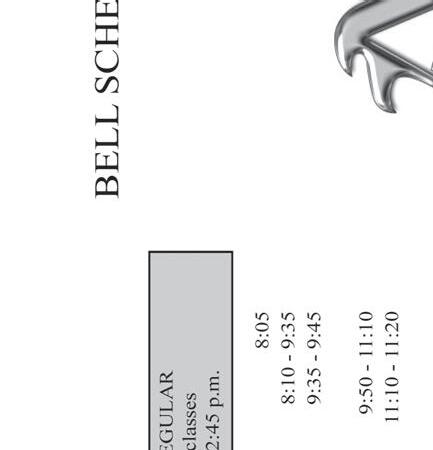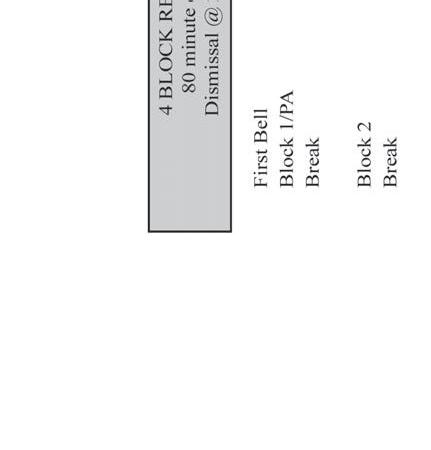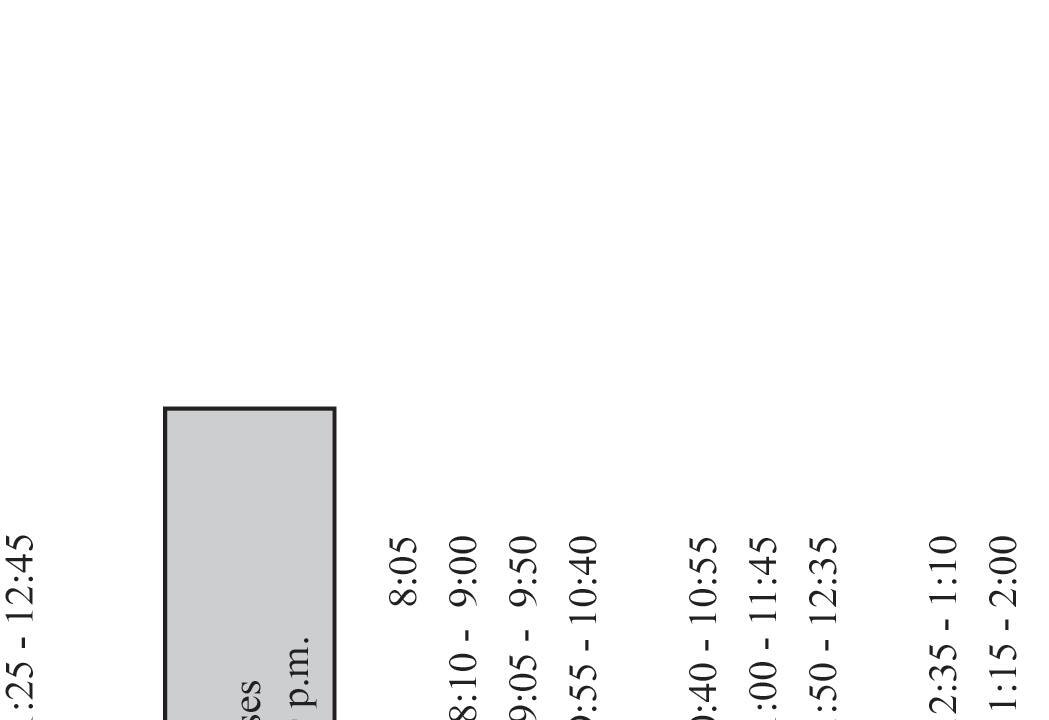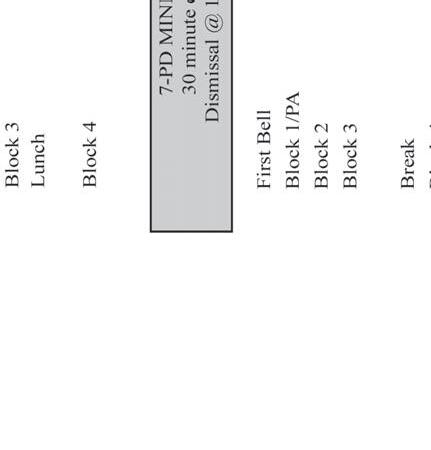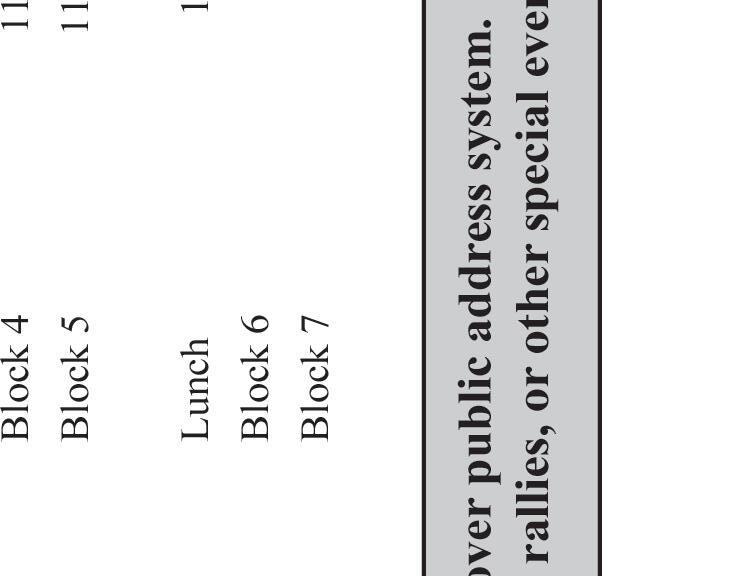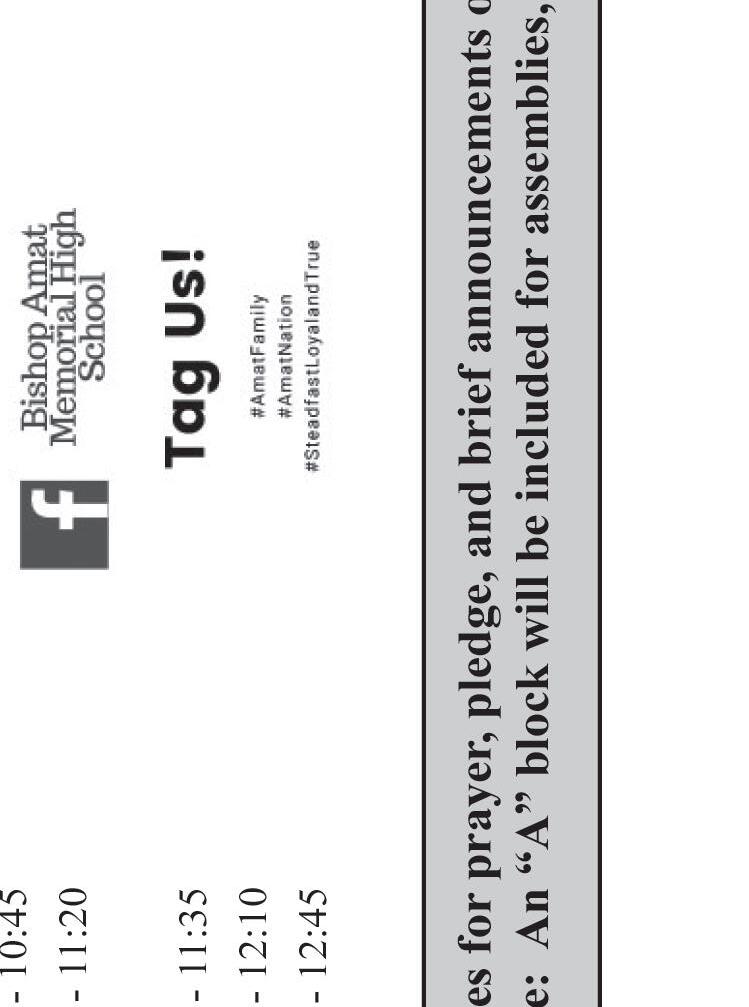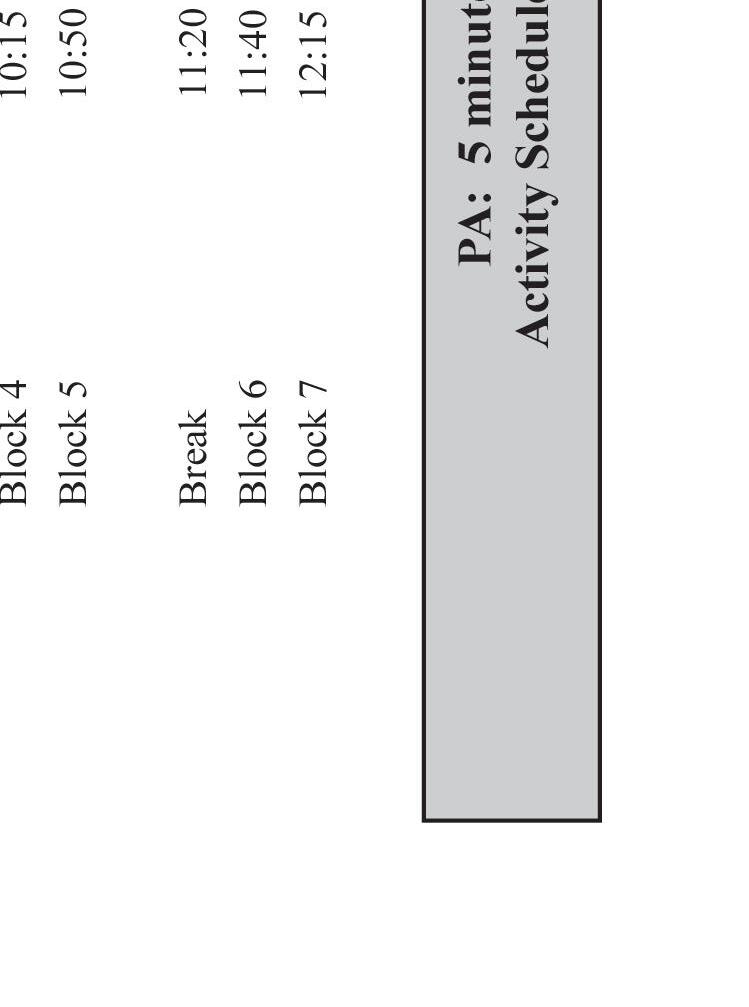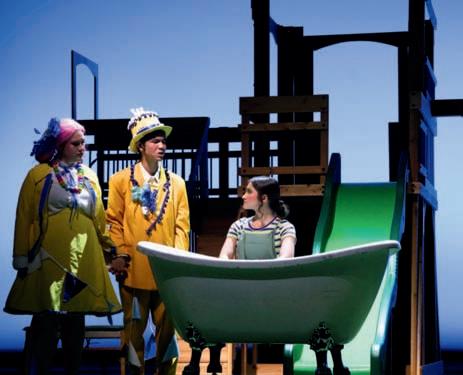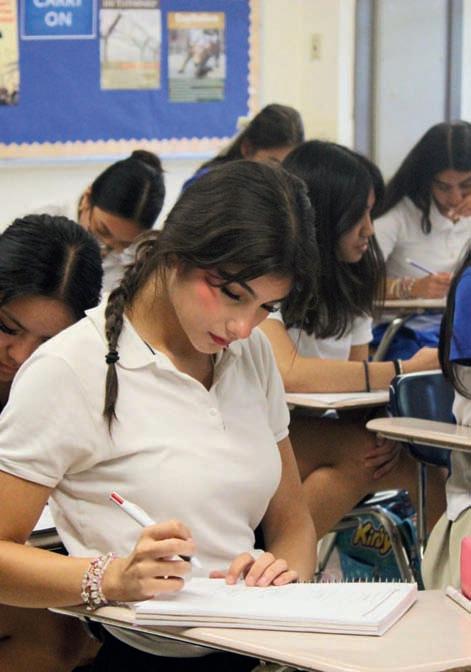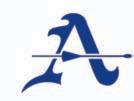PHILOSOPHY AND HISTORY OF BISHOP AMAT HIGH SCHOOL
Bishop Amat High School is a four-year co-educational Archdiocesan Catholic High School. The school seeks to form a community of faithfilled people committed to Christian truth based on the teachings of the Roman Catholic Church. The principles of Christian life outlined in the Gospel, interpreted by the Catholic Church and taught at Bishop Amat High School, invite followers to a life-style rooted in a personal relationship with the Lord Jesus Christ and extending out in loving service to others. Education to this lifestyle, while the primary responsibility of parents, is shared by faculty, staff, and students, as all seek to grow in personal awareness of their call to bring the presence of Christ to our modern world.
The school motto calls for education in Goodness, Discipline, and Knowledge. While it is important that our students experience these values in the academic content of the school, they must above all see them present in the lives of their parents and teachers. Seeing living witnesses who cherish the values they seek to acquire; our students will more readily embrace them for themselves.
The call to Goodness involves all aspects of one’s lifestyle. It primarily involves daily prayer through which one comes to know personally the tremendous love of the Father. It includes a willingness to be like Jesus in sacrificing oneself for others, aware of their supreme dignity as human persons. “If anyone wishes to follow me, he must deny himself, take up his cross and follow me.” (Mt. 16:24) Goodness also involves being empowered by the Holy Spirit to join with others in forming a community in service of others and in concern for the physical, social, and spiritual environment in which we live. In all aspects of student life, but especially through service and campus ministry, Bishop Amat High School tries to instill goodness as the binding force of the “Amat Family.”
The importance of Discipline and a disciplined lifestyle follows from the call to Goodness. The underlying purpose of the disciplinary code is to help students master the internal forces of their personalities so as to enable them to submit themselves to the Lordship of Jesus Christ. Thus obedient, they will be responsible and accountable members of the human family. School regulations such as the distinct dress and grooming regulations are part of the call to self-respect, self-discipline, and personal responsibility. The aim of Discipline is not conformity but authentic freedom to be all that God has created us to be.
The Knowledge taught at Bishop Amat High School reflects the varied needs of our student body, a diversified campus that includes many academic abilities. The multicultural student body itself provides an atmosphere of learning that enables the students to affirm their own cultural traditions and to be enriched by the other cultures, which they encounter here. The Knowledge taught at Bishop Amat High School flows from a college-prep curriculum, which prepares students for continued instruction in institutions of higher learning. However, the curriculum is designed with the flexibility to help all students of varied academic abilities to reach their full potential. The instructional program centers on a solid foundation in the scholarly disciplines within a Christian perspective, and along with the co-curricular and counseling programs, gives emphasis to the spiritual, personal, social, and physical development of the adolescent.
A willingness to participate in this call to a Christian lifestyle is a central feature of the Bishop Amat High School experience. The entire school program seeks to instill a sense of values, integrating knowledge of God and His plan for creation into the entire curriculum of the school, and assisting students in finding their identity in Jesus Christ by giving their lives to Him.
The mission of Bishop Amat High School is to integrate Catholic values into all areas of the life of the adolescent, values which are essential for the lifetime pilgrim journey of a follower of Christ. In His teaching, Jesus calls us to be leaven, salt, and light . . . the leaven which raises the values of society, the salt which gives the flavor of faith to the world, and the light which reveals the presence of Christ alive in His people.
Bishop Amat was a Spanish Vincentian priest who had been the rector of St. Charles Borromeo Seminary in Philadelphia. He was consecrated a Bishop in Rome on March 12, 1854. He was then appointed to the Diocese of Monterey, California. At his request, Los Angeles was made his episcopal city and the Diocese of Monterey became the Diocese of Monterey-Los Angeles in 1859. The population of Los Angeles grew from 1,610 in 1850 to 10,000 in 1878 when the Bishop died.
Bishop Thaddeus Amat built St. Vibiana’s Cathedral, which was consecrated in 1876. He opened the first schools in Los Angeles and invited the Vincentians to open St. Vincent’s College, which was the predecessor to Loyola University. Bishop Amat Memorial High School was formally dedicated to his memory in October 1959. Bishop Amat High School was built by the Archdiocese of Los Angeles in 1957 to serve the Catholic families of the San Gabriel Valley. Funded through the Cardinal McIntyre Youth Education Fund, Bishop Amat was founded as a co-educational high school. The school opened in the classrooms of St. Christopher’s School (boys) and St. John’s School (girls) in September 1957. On December 16, 1957 the present campus site was opened. His Eminence, James Cardinal McIntyre, formally dedicated the campus in October 1959.
The campus site has grown over the years with the present 200 and 500 wings added in 1959. The gymnasium was added in 1962, the Kiefer Stadium in 1965 and the 300 wing in 1966. In 1973, the school formally became co-educational, with a single administrative structure. A building dedicated to the performing arts was completed in 1982. Four classrooms, including a full computer lab, containing the latest technology available, were completed in 1988. A second computer lab was added in 1992, a new state of the art biology lab in 1993, a refurbished physics lab in 1994, and the Brutocao Library in 1995. In 2000, a new covered lunch structure was built complete with an integrated sound system and barbeque pit.
In 2002, the school undertook a major renovation with plans for the replacement of the Tate Duff Memorial Gymnasium. On May 16, 2004, the Living Rosary was held as the first activity in the new facility. The Student Activity Center houses a main pavilion which seats 1,600 spectators for Masses, assemblies, rallies, and basketball and volleyball contests. The building also includes a dance studio, locker rooms, an updated weight room facility, a dining room, and offices for members of our athletics and activities programs.
The 2021-2022 school year saw the long-awaited completion of a state of the art Performing Arts Center built to showcase Bishop Amat’s varied choral, dance, music, and theater programs. The main feature of the building is a 400-seat theater complete with a 1,800 square foot stage and orchestra pit. Additionally, the Performing Arts Center includes two classrooms specifically designed for instrumental music and choral instruction as well as two dressing rooms, a set design shop, conference space, and costume and prop storage facilities.
When the school was opened in 1957 it was part of the Cardinal McIntyre construction boom in Catholic Schools. The original staff was composed primarily of men and women religious. Women from the Sisters of the Immaculate Heart, Sisters of St. Louis, Sisters of the Sacred Heart, Carmelites, Benedictine Sisters and Franciscan Sisters taught the girls.
Parent Organizations
The Parent Association is the umbrella organization that represents all Bishop Amat Parents. One of the primary objectives of the Parent Association is to promote the welfare of children and youth in home, school, community, and place of worship by promoting a closer relationship between home, school, teachers, and parents. Officers are selected each year to carry out the responsibilities of the organization and provide the communication levels necessary for a positive school environment.
Every parent and guardian, by virtue of his/her child’s enrollment at Bishop Amat, is a member of the Parent Association. All parents are encouraged to attend the scheduled meetings and take advantage of the opportunity to learn more about the school and key events that affect students and parents. It’s also a great way to meet and get to know other parents of the Amat family.
The Athletic Booster Club supports, encourages, and promotes the proud tradition of athletic excellence at Bishop Amat High School through a voluntary program guided by Christian Principles and values with strong family, alumni, and community involvement.
The Club provides supplemental financial support to all school sanctioned athletic teams, provides volunteers to help staff athletic events and associated activities, provides a forum for the exchange of ideas, concerns, and needs of our student athletes and their teams, and encourages active involvement of alumni and parents in the athletic program of the school.
Development Commitment
The Bishop Amat campus was built through the generous support of parent donations to the Cardinal McIntyre School Building Fund in 1957. Since that time, each addition to the campus has been funded through similar generous sacrifices by the families of students. Parents of current students are required to continue this support by making contributions to the Parent Pledge Program during their four years at Bishop Amat. Parents are also encouraged to participate in the school’s annual fundraisers (Virtual Auction, Special Events, and Golf Tournament).
Expectation of Students
Students who are accepted to Bishop Amat must abide by the following school standards:
1. Respect for the religious beliefs of the Catholic Church, its moral principles and liturgical practices (respect does not imply adherence by those who are non-Catholic).
2. Respect and care for the property of the school, including adherence to standards of campus order and cleanliness.
3. Respect for the person and property of others, including faculty members and fellow students.
4. Adherence to the standards of the school as set forth in Lancer Life, including the requirements of dress and grooming codes.
5. Non-toleration and non-acceptability of drug and alcohol abuse.
6. A basic attitude of respect for those in authority.
7. Regular attendance and participation in class.
8. A dedication to studying and learning in accord with the ability of the individual student.
PARENTAL RESPONSIBILITIES
Parents have the primary responsibility for the education of their children. The school, Church, and community support and complement this role. It is important to realize that the school has a stated philosophy and specific expectations for families and their students enrolled at Bishop Amat High School. Parents’ attitudes are expected to contribute to the education process. Parents who do not agree with the school’s
philosophy and expectations should withdraw their student from Bishop Amat.
The student’s place of residence is considered to be the one indicated on the student’s original application for enrollment at Bishop Amat. Parents or guardians have the responsibility to notify the school whenever the student’s place of residence changes whether the change is temporary, extended, or permanent.
Parents also have the responsibility to supervise their children in the actions that take place on online and on social media. At times, student postings can be of a derogatory nature and such postings can be construed as harassment, or worse, of a fellow student or a teacher.
Rights of Non-Custodial Parents
In cases of legal separation and/or divorce, California state law gives the custodial parent and a non-custodial parent the right to access and examine student records provided they are legal custodians, as well. However, only the custodial parent has the right to challenge the content of the records and to write responses to information regarding disciplinary action. A parent who does not have legal custody of his or her child, but has visitation rights, may visit the school, subject to the school’s parental visitation policy, unless the school has received a legal order prohibiting such a visit. If a parent without visitation rights attempts to visit a student at school, the custodial parent or guardian will be notified. Parents are responsible for providing any custody orders or other legal documents to the school that they wish the school to follow.
Students No Longer Living with their Parents
Central to the philosophy of archdiocesan/parish secondary schools is the belief that parents are the primary educators of their children. In support of this, the school and the parents work in close collaboration in all aspects of the student’s educational process. A student not living in the home of a parent or guardian may not be allowed to attend an archdiocesan/parish secondary school. The principal is expected to confer with the Regional Supervisor before making any final decision.
Tuition and Fees
All households are assigned a tuition account number (Student ID number). This number should be used on all correspondence to enable the Finance Office to maintain accurate records.
The Registration Fee for 2025-2026 is $950 per student ($750 nonrefundable, non-transferable). Current families pay this fee in two parts (Part I at time of re-registration, Part II in June); incoming freshmen pay the fee in full at the time of registration. This fee reserves a seat for the following school year and offsets the cost of various student services offered throughout the year (student activities, campus ministry, athletic activities, student planner, summer reading program and yearbook). The $200 Mandatory Fall Raffle is also included in this fee.
2025-2026
Tuition
One Student
Two Students - same family
Three Students - same family
$10,835
$18,370
$22,110
The school has contracted with FACTS Tuition Management for the purpose of the collection of tuition fees. All families in the school are required to set up an account through the FACTS website.
Tuition is due and payable on either the 5th or the 20th (parent’s choice) of each month and is considered late if received after that date. A $30 fee will be charged to the account if the monthly tuition payment is not received by the 5th or 20th of the month. Parents who pay by credit card will incur a 2.95% convenience fee.
Delinquent Tuition Policy
1. Parents are expected to make regular monthly tuition payments. When a tuition account becomes seriously past due, the parent will be notified. Satisfactory payment arrangements must be made or the student will be placed on financial suspension, which means the student will not be allowed to attend school or participate in any athletic or extra-curricular activity, practice or competition. If the problem cannot be resolved, the student may be asked to withdraw from school.
2. Students with delinquent accounts will not be allowed to take Part B of semester exams. Students who earn a grade of “Incomplete” on a semester report card for financial reasons will not be allowed to return to the school for the following academic year until the tuition account is cleared and make-up exams have been taken. Note: Incomplete grades affect a student’s G.P.A. and eligibility to participate in extracurricular activities.
3. Students may be denied the privilege of attending school sponsored social events. In particular, students who have seriously delinquent tuition accounts will not be allowed to attend Prom.
4. Students who have delinquent tuition accounts at the end of the second semester will not be allowed to enroll in summer school.
Withdrawal Policy
The tuition financial obligation is incurred at the time of enrollment. The school has incurred staffing costs related to the number of students in the school and cannot absorb the loss of tuition revenue when students withdraw during the school year. Therefore, families who withdraw before the end of the school year are responsible for paying a percentage of their total tuition if they decide to withdraw. Reasons for involuntary withdrawal include, but are not limited to, poor academic performance, disciplinary issues or disregard for financial obligations to the school. If a student withdraws for any reason, voluntarily or involuntarily, on or before August 18, 2025, no tuition or fees will be due. Any payments applied to the 2025-2026 tuition and fees will be fully refunded less the non-refundable Registration Fees.
However, if a student withdraws voluntarily or involuntarily, after August 18, 2025, the parents or guardians, who are financially responsible for the student, are obligated to pay the full annual tuition and fees according to the schedule below. This schedule applies to the balance on all accounts, even for families using the monthly payment plan. If a student leaves the school before the end of the school year, the financially responsible person is obligated to pay the remaining balance regardless of the reason for leaving, whether voluntarily or involuntarily. Please note that all school fees are non-refundable after August 18, 2025, and the following schedule will be used to calculate your prorated tuition due to the school.
If a student’s tuition has been paid in full and withdrawal is: Before 8-18-25, 100% of total tuition will be refunded Between 8-18-25 and 10-19-25, 75% of total tuition will be refunded Between 10-20-25 and 1-6-26, 50% of total tuition will be refunded Between 1-6-26 and 3-20-26, 25% of total tuition will be refunded After 3-20-26, no refund will be given
If a student’s tuition is paid on a payment plan and withdrawal is: Before 8-18-25, 100% of payments will be refunded Between 8-18-25 and 10-19-25, 25% of total tuition is due and payable Between 10-20-25 and 1-6-26, 50% of total tuition is due and payable Between 1-6-26 and 3-20-26, 75% of total tuition is due and payable After 3-20-26, 100% of total tuition is due and payable
Parent Participation Program
Bishop Amat High School is a financially self-supporting institution. As such, all of the school’s expenses must be paid through self-generated funds (tuition, fees and fund-raising activities).
As with most Archdiocesan schools, the tuition charged does not cover the cost to educate a student. For the 2025-2026 school year, the Bishop Amat tuition is $10,835 per student. The actual cost to educate a student is $13,645 which leaves a “gap” of $2,810. The school must engage in fund-raising activities to cover this shortfall.
As a member of the Bishop Amat community, each family is an essential part of the fundraising efforts of the school. With this in mind, all families are required to participate in the Parent Pledge Program by contributing a minimum of $420 per year and to volunteer their services in areas of need (parent hours).
To contribute to the Parent Pledge Program, parents may visit the website at bishopamat.org, Giving and can opt to make a one-time payment of $420 by July 31 and earn 5 Development hours, or pay monthly.
Every family is also obligated to render 36 hours of volunteer service during the 2025-2026 school year (April 16, 2025 - April 30, 2026). Of these 36 hours, 6 hours must be served through the Bingo Program and 10 hours must be served through the Development Office
Parent Pledge Program
All families are required to participate in the Parent Pledge Program by contributing $420.00 annually to the Development Program for each year a family has a student attending the school. The donations made through this program provide the school with funds to offset “the gap” and to make capital improvements to the campus.
Parent Hours Program
1. Each family must render 36 hours of service to the school. Families that receive financial aid are required to complete an extra 6 hours of service through the Bingo Program. Parent hours must be completed in the following categories: 20 – various 6 - Bingo (setup, take-down, game worker) 10 - Development (arranged through the Development Office, ext. 7401)
A. Single-parent families are obligated to fulfill the 36-hour requirement.
B. Additional hours are not required for multiple student families.
C. Only activities approved through the Parent Hours Coordinator qualify for service-hour credit. (Refer to the Parent Participation Program Handbook.)
2. Hours must be completed by April 30, 2026.
A. Credit is given on an actual hour-per-hour basis.
B. Only on rare occasions may double hours be given.
C. Excess hours do not carry over to the next school year.
3. Only family members may complete service hours for credit. Exceptions must be cleared through the Parent Hours Coordinator.
A. Students are not eligible to earn credits to fulfill the service hours requirement.
B. To receive credit for an activity, it is the responsibility of the volunteer to sign in with the Event Coordinator.
4. If working hours for another family, the name of the student receiving hours credit must be given at the time of service. Hours are not transferable after they have been served.
5. Credit will not be given for hours that are not verified by an event coordinator, official sign-in sheet, or Parent Participation verification slip. Please be aware that no coach/moderator is allowed to give credit for Bingo/Development hours.
Academic Requirements for Graduation
In order to earn a diploma from Bishop Amat High School, the student must fully meet, in advance, the following minimum academic requirements:
credits
College Courses
Bishop Amat High School may accept college courses for credit in order to make up a failing grade, but only when the make-up class is not available at Bishop Amat during the summer.
In these cases, the following conditions must be met:
1. The student must obtain approval of the Assistant Principal, Academics before the class is taken. The appropriate college form and course description must be presented.
2. Upon completion of the course, the student must request an official transcript be mailed to the Registrar.
3. In general, ten semester units of high school credit will be awarded for a three-unit college course. None of these transfer classes will be counted in the GPA.
Total 270 credits
*Social Studies requirements must include Economics and U.S. Government. **Laboratory Science requirements must include Biology and Chemistry.
Participation in Graduation Ceremony Requirements
The following information explains the policies regarding graduation from Bishop Amat High School:
1. Participation in the graduation exercises is a privilege which a student earns as a result of:
a. completing the required 270 units of credit for graduation
b. satisfying all financial obligations, including tuition, fees, family assistance hours and fines
c. returning all uniforms and equipment
d. meeting behavioral expectations in regard to discipline
e. completing the required 80 hours of Christian Service
2. There is a non-refundable graduation fee. This fee covers the cost of the Baccalaureate and Graduation ceremonies, Senior Luau, Senior Dinner, graduation cap and gown and other senior events specific to graduation.
3. A senior will not be allowed to participate in the Graduation ceremony (walk) if the student:
a. fails to earn the 270 credits required for graduation
b. fails to complete the required 80 hours of Christian Service
c. receives a failing semester grade in a required subject
d. fails to meet the other requirements specified above
4. Students who do not participate in the Graduation ceremony for any of the reasons listed above will receive a diploma only after those requirements have been satisfied.
Dual Enrollment
The Dual Enrollment program at Bishop Amat High School, in partnership with Mount San Antonio College (Mt. SAC), offers a unique opportunity for high school students to take college courses taught by college professors directly on their high school campus. This program allows students to experience college-level coursework while still in high school, at no cost to them. These courses are open to all Mt. SAC students and adhere to Mt. SAC's deadlines and requirements. Students participating in the Dual Enrollment program are considered Mt. SAC students who have access to all the resources and facilities available to Mt. SAC students, providing a comprehensive and enriching educational experience. All grade levels are eligible to enroll in these classes.
4. Courses must be taken through the Mt. San Antonio College’s (Mt. SAC) Special Admit Program, Mt. SAC’s High School Referral Program, or Brigham Young University’s (BYU) Independent Study. Additionally, a $50 processing fee is required to update the student’s transcript.
High School Courses for Transfer
In general, courses from other high schools are not transferable to Bishop Amat for credit or to affect GPA. ROP, Adult School, Night School, and other special program courses are not accepted. The only exception to this is students who are applying for admission, or re-admission, to Bishop Amat as their transcripts will have to be evaluated as part of the admissions process.
BASIC PROGRAM OF STUDIES
Freshmen
0-70 credits completed Theology
English
Mathematics
Biology
PE or Band or Dance
Computer Science & World Languages or Freshman Composition Study Skills or AP Human Geography
Sophomore
70-140 credits completed
Theology Chemistry or Elective
English
Social Studies
Mathematics Elective World Languages
Junior 140-210 credits completed
Theology Chemistry (if not taken in grade 10)
English Elective
Mathematics Elective
Social Studies
Senior 210-270 credits completed
Theology Elective
English Elective
Social Studies Elective
Elective
COURSE OFFERINGS
Please note: All classes marked in bold are weighted in the Bishop Amat GPA. All classes marked with * are semester classes.
Business/Computer Science
STEM 1*
Data Analysis*
Accounting Directed Lab Studies
Introduction to Business* Web Design*
Game Design* Personal Finance
AP Computer Science Principles
English
Freshman Composition* AP English Literature
Honors Composition & Literature I Honors British Literature
English I English IV
The Short Story* Honors Composition & Literature II
Literature and Film* English II
Literature of Sport* AP English Language
Journalism Honors American Literature
Creative Writing* English III
Speech* IB English HL1
Shakespeare* IB English HL2
Poetry and Composition* Science Fiction & Fantasy Literature*
Visual and Performing Arts
Digital Photography Art I
Advanced Band Art II
Music Appreciation Art History
Lancer Chorus Chamber Singers
Yearbook Hnrs Yearbook Adv. Design & Publishing
Instruments Beginning Dance
Intermediate Dance Dance Production
AP Studio Art AP Art History
Digital Art and Design Theater Arts
Technical Theater & Design Honors Chamber Singers
World Language
Latin I Spanish I
Latin II Accelerated Spanish I
French I Spanish II
French II Accelerated Spanish II
IB French HL1 Spanish III
IB French HL2 AP Spanish Language & Culture
IB Latin HL1
IB Spanish HL1
IB Latin HL2 IB Spanish HL2
Family and Consumer Science
Clothing I Child Development
Fashion, Textiles & Apparel Clothing II
Mathematics
Honors Algebra I Advanced Algebra/Trigonometry
Algebra I AP PreCalculus
Pre-Algebra/Algebra IA Math Analysis
Algebra 1B/Algebra 1C Statistics
Honors Geometry Intermediate Algebra
Geometry AP Calculus AB
Algebra II AP Calculus BC
Honors Algebra II/Trigonometry AP Statistics
Physical Education
Boys PE
Girls PE
PE Dance
Marching Dynamics
Physical Conditioning
PE Pep Squad
Boys PE Soccer
Boys PE Basketball
Boys PE Baseball
Girls PE Basketball
Girls PE Soccer
Girls PE Softball
Boys PE Football PE Volleyball
Fitness* PE Wrestling
PE Flag Football
Theology
Christ in Scripture* Christology*
Paschal Mystery* Christ’s Mission*
Christian Vocations* Christian Morality* Sacraments* World Religions*
Christian Discipleship Sacred Scripture*
Church History* Introduction to Catholicism*
Note: Each student, whether Catholic or non-Catholic, is required to be enrolled in the program of Theology for each semester he/she attends a Catholic school. Class time, assignments, and accountability for Theology classes are comparable to that of other academic areas.
Science
Physics
Biology & Community Health
Anatomy and Physiology
Chemistry
Honors Physics
Honors Biology & Community Health
Honors Anatomy & Physiology
Honors Chemistry
AP Physics 1 AP Biology
AP Chemistry Robotics Engineering
Sports Medicine
Social Studies
AP European History AP Macroeconomics*
Honors World History Honors Economics*
World History Economics*
AP US History AP Psychology*
Honors US History Honors Psychology* Criminal Justice* Psychology*
US History US Government*
AP Government & Politics* Honors US Government*
AP Human Geography American History & Film*
Non-Departmental
Study Skills Office Aide*
Study Hall (Non-credit class) * Tutoring Aide*
Theology Curriculum
All schools, whether archdiocesan, parish, or those owned and operated by religious orders, institutes, or governing boards, are required to meet the following Catholic identity standards from the accrediting agency for archdiocesan schools, the Western Catholic Educational Association:
● The school has a mission statement and philosophy statement that indicates the integration of the Catholic faith in all aspects of the school’s life.
● The school provides regular opportunities for the school community to experience prayer and the sacraments.
● The school has a Theology curriculum and instruction that is faithful to Catholic Church teachings and meets the requirements as set forth by the U.S. Conference of Catholic Bishops.
● The local ordinary approves those who teach the Catholic faith (Canon 805) and there is ongoing formation for catechetical and instructional competence.
● The school maintains an active partnership with parents/guardians whose fundamental concern is the spiritual and academic education of their children (Canon 796).
● The school has a service-oriented outreach to the Church and civic community after the example of Jesus Christ, who said, “I have given you an example so that you may copy what I have done to you” (Jn 13:15).
● The school uses signs, sacramentals, traditions, and rituals of the Catholic Church.
● All school personnel are actively engaged in bringing the good news of Jesus into the total educational experience.
AP Courses
Bishop Amat High School has an extensive AP Program. This program is a cooperative educational endeavor between secondary schools and colleges and universities. It allows high school students to undertake college-level academic learning. Students can receive advanced placement, college credits, or both from thousands of colleges and universities that participate in the AP Program
Students enrolled in these courses are required to take the AP exam in May. A fee is charged for this exam. With the exception of World Languages, students who are not enrolled in an AP course may not challenge an AP Exam. Students who wish to challenge a World Language AP exam must make their intentions known by obtaining the permission of the AP Testing Coordinator by October 15.
student has, a Bishop Amat summer class must be taken for each semester failure received.
Only IF the course is not offered during the summer, arrangements may be made directly through the Assistant Principal, Academics for approval to take the course off-campus. However, there will need to be a meeting scheduled with the parent(s) and the Assistant Principal, Academics to gain approval. Additionally, there will be a $50 processing fee for updating the student’s transcript
If a student fails a required course, he/she must retake the same subject. If a student fails an elective course, he/she needs to make up only the credits. One course must be taken for each semester failure. Students who fail to complete the necessary summer courses may be asked to withdraw in the fall.
It is also highly recommended that students attend Summer School if they receive a deficient grade. Please note that students who receive a D or lower in Spanish I must attend Summer School. The same guidelines for failing grades outlined above apply to deficient grades.
Student Success Intervention Program
A student may be placed in the Student Success Intervention Program if it is determined that the combination of grades achieved by the student in any semester warrants such action. For example, any student who receives four F's in a single semester may be placed in this program.
In each case, a contract will be written enacting such terms as best motivate the student to improve. Among the terms will be the successful completion of all courses attempted during the new semester and attendance at summer school. Other terms may include exclusion from extracurricular activities and athletics.
Academic Termination
The school, acting through the Principal, reserves the right to require a student who receives four or more semester failures or who loses credit in four or more classes due to excessive absences, to withdraw from school. Before doing so, the Principal will ordinarily instruct the Assistant Principal, Academics to convene a meeting of the Academic Review Board for the purpose of permitting the student to petition for the right to remain in school. The Principal will consider the recommendation of the Academic Review Board before making a decision. A student permitted, under these circumstances, to remain in school will be placed on Academic Probation.
Final Exams
All students are expected to take their final exams, both Part A and Part B, during the scheduled time at the end of each semester. Students who miss semester exams during the first semester are expected to complete their exams within the first 10 school days of the second semester directly with the teacher of the class. Students who miss semester exams at the end of the second semester are expected to complete their exams during the second week of Summer School directly with the Director of Studies. It is the student’s responsibility to coordinate a date and time to make up exams.
Any student who has outstanding financial obligations to Bishop Amat High School will need to obtain clearance from the Finance Office prior to taking Part B of final exams. Once financial clearance has been obtained, instructions will be given to the student on how to make-up Part B. All outstanding financial obligations must be cleared before the beginning of the next academic year.
GRADE REPORTS
Progress Reports and Report Cards
The school issues two progress reports and one report card each semester. Progress reports are available online and semester report cards are mailed home to all families, as well as available online. These reports include
grades and comments on conduct and academic performance. Attendance records are also included on semester report cards. Progress report cards issued in the 7th and 14th weeks of the semester will reflect the student’s progress in the class to-date. Low grades on the 14th week reports are indicators that a student might fail and credit may not be earned at the semester. At the end of the semester, the report card will reflect the final letter grade. Only the final semester grades appear on the student’s transcripts.
Online Parent Portal
Parents may monitor the progress of their student’s grades, assignments, and attendance via the Parent Portal which can be found on our school’s website. Access codes will be distributed to parents of freshmen and new students in the student schedule packets distributed starting in late July. During the year, parent codes are available through the school Registrar.
Please refer to the “Parent Portal User Guide” in the Lancer Life as it describes the step by step process to view grades, daily attendance, access online progress reports, as well as other features related to being an Amat parent. After each grading period, parents may select from the “grades” tab “Progress/Student Report Card” to view final grades.
The Parent Portal will be closed at the end of each semester from the first day of exams to the day report cards are available online and mailed. For questions about individual grades, contact the teachers directly through their faculty email addresses. For each faculty member, the email address consists of the first initial of the teacher’s first name, followed by the last name @bishopamat.org. For questions about the grading and report processes, please call the Assistant Principal, Academics.
REPORT CARD COMMENTS
Academic Comments
1 Overall outstanding student
2 Student is well prepared
3 Outstanding effort
4 Good effort
5 Unsatisfactory effort
6 Outstanding participation
7 Good participation
8 Unsatisfactory participation
9 Too frequently absent
10 Some assignments not completed on time
11 Student fails to make up work when absent
12 Fails to complete assignments regularly
13 Poor project/essay grade
14 Project not completed on time
15 Low quiz/test grades
16 Poor midterm/ final exam grade
17 Inconsistent quality of work
18 Student is often inattentive
19 Fails to bring required items to class
20 Student does not seek help
21 Student is working below ability
22 Parent contact teacher
23 Student has improved in this class
Conduct Comments
G The student’s classroom conduct/citizenship habits are GOOD
C The student sometimes needs CORRECTION
N The conduct/citizenship habits of the student NEED IMPROVEMENT
U The conduct/citizenship habits of this student are UNSATISFACTORY
Teacher Conferences
Families are given the opportunity to meet briefly with teachers after the 7th week Progress Report in the first semester. After the 7th week Progress Report in the second semester, teachers will contact the parents of students who are not on track to successfully complete their class. Parents are encouraged to contact the teachers by email to request an
appointment, as needed. Teachers remain on campus until 3:30 p.m. for such purposes. Appointments outside of school hours must be at a time convenient to both parties. Parents are expected to make arrangements with a teacher before coming to campus and to check in at the main office upon arrival.
ACADEMIC HONORS
Honor Roll
A semester Honor Roll is published to provide recognition to students for superior academic achievement. The Honor Roll is based on the official GPA of the school and takes into account weighted, as well as regular classes. First Honors is given to students who earn a GPA of 3.5 or higher. Second Honors is given to students who earn a GPA of 3.00-3.49.
Academic Awards Assemblies
Bishop Amat High School strongly believes in giving recognition to students who demonstrate academic excellence in various disciplines. Each year, academic awards are presented during class assemblies held just prior to the close of the academic year. A special evening assembly is held for seniors. In some cases, students must submit required documentation by specific deadlines in order to be recognized at the assemblies.
Graduation with Honors
At graduation, honors are conferred on any student who has earned a cumulative GPA of 3.0. Specific awards include:
● Gold Medal
Students will be eligible to wear the Gold Medal if they graduate with First Honors by earning a cumulative GPA of 4.0 or higher.
● Bronze Medal
Students will be eligible to wear the Bronze Medal if they graduate with First Honors by earning a cumulative GPA 3.5-3.99.
● Second Honors Certificate Certificates will be presented at the Senior Awards Assembly to students who graduate with Second Honors by earning a cumulative GPA of 3.0-3.49.
Distinguished Scholars Program
The Distinguished Scholars Program celebrates the achievements of students who challenge themselves academically through the successful completion of a rigorous schedule of coursework in the school’s Advanced Placement and/or International Baccalaureate programs. Students must fulfill all academic, attendance, and extended Christian Service requirements in order to be recognized as a Distinguished Scholar upon graduation.
Requirements for Distinguished Scholar recognition at graduation include:
Academic Requirements
The student must have maintained a cumulative GPA of 3.5 or higher, having selected one of the following academic options:
1. International Baccalaureate Option - achievement of the IB Diploma Program Candidate status by the IBO
2. Hybrid Option - successful completion of at least six AP and/or IB courses (including taking all required exams)
*Diploma Candidates who miss an exam, fail to complete an internal assessment or otherwise neglect requirements of the program will not achieve Distinguished Scholar status.
Attendance Requirement - The student must maintain a 90% attendance rate in all courses.
Christian Service Requirement - The student must complete a minimum of 120 service hours by April of the senior year
Students seeking more information regarding program specifics should contact their academic counselor.
Valedictorian and Salutatorian
The criteria for the selection of the Valedictorian and Salutatorian include:
1. Sound character as defined by the Gospels
2. A record of service to the Bishop Amat High School Family during the student’s high school career
3. Noteworthy academic achievement
4. Ability to compose and deliver a speech
5. Acceptable conduct record (no serious disciplinary violations)
The process for the selection of the Valedictorian and Salutatorian is as follows:
1. During the second semester, the list of the seniors with a GPA of 4.25 or above will be distributed to the faculty.
2. These seniors will be invited to apply for the positions by completing an application questionnaire which will address, in particular, the areas covered by the election criteria.
3. The application questionnaire will be made available to the faculty who will be invited to recommend superior applicants. Four applicants will be selected.
4. Each of the four students will be invited to deliver a three minute speech before a panel of faculty judges. The judges’ comment sheets will be submitted to the Principal.
5. All of the faculty will be invited to comment, in writing, on any of the finalists.
6. Using the criteria for selection, the Principal will select the Valedictorian and Salutatorian based on the results of the speaking process, the student applications and the input of the faculty.
7. The Valedictorian and Salutatorian will speak at the graduation ceremony
8. The runners-up candidates will be invited to speak at the Senior Awards Assembly.
SCHOLARSHIP ORGANIZATIONS
California Scholarship Federation
The purpose of the California Scholarship Federation (CSF) is to foster higher standards of scholarship, citizenship, and service. Membership is open to students in the 10th, 11th, and 12th grades. There are two kinds of membership: active and inactive.
In order to foster high standards of scholarship, eligibility is based on attributes defined by an academic point system (A=3; B=1, or A=4; B=2 if an honors class, for up to two honors classes). The total number of points earned must be at least 10 based on a maximum of five classes with an emphasis on UC “A to G” list. A “D” or “F” grade, or poor reports of citizenship, disqualify the student.
Applicants who make the grade and citizenship requirements are considered inactive members. Although service is not a requirement for eligibility, service is highly recommended and is an additional requirement for consideration as an active member. To meet the service requirement for active membership, the student must provide three hours of tutoring service each semester through the school’s tutoring program. In addition, active members must participate in the organization’s meetings and activities.
Applications are accepted during the first three weeks of the semester. Students must reapply each semester that they are eligible. Four semesters of membership, including one semester using senior grades, are required in order to graduate as a CSF Sealbearer. All Sealbearers will receive certificates of membership and the CSF Chapter Seal will be affixed to their diploma. Seal Bearers who have been active members for at least four semesters will wear a gold cord at graduation.
would like information regarding steps for resolution of complaints arising out of a student’s disability may request the “Disability Discrimination Complaint Review Process” from the Principal.
The Inclusion Program seeks to work with parents, students, and teachers to create an educational plan that is appropriate for a student who has been identified with a need for academic support. The program puts in place appropriate minor adjustments to facilitate learning in the school’s college preparatory environment. Minor educational adjustments are based upon the student’s testing-identified needs. Documentation to verify a request for academic support must include a battery of tests completed by a licensed practitioner.
The Inclusion Program at Bishop Amat, in accordance with the philosophy of the school, regards the parent as the primary educator. Parents are asked to keep in mind that they are expected to follow through at home by checking their student’s progress via the Parent Portal, checking for homework completion at home, providing a quiet study area, and keeping in contact with both the Learning Specialist and their child’s teachers. A student’s potential success in the Inclusion Program requires both parent and student commitment.
The Inclusion Program is based in the Learning Resource Center (LRC) located in the 400 Wing. The LRC provides educational endeavors of an environment for distraction free testing along with additional testing time, as needed. The LRC is staffed with a STEP Coordinator who provides academic support and checks in with students who utilize the program to monitor their success. The STEP Coordinator is a resource for parents, students, and teachers who have questions regarding educational testing or academic support in general.
The goal of the Inclusion Program is to build self-esteem and selfadvocacy skills in the student as well as foster academic success in the school’s college preparatory environment.
Athletic-Academic Counseling
The primary focus of the Athletic-Academic counselor is to help those student-athletes who see college athletics as a goal beyond the high school level. The counselor will meet and discuss with student-athletes the different aspects of college athletics including the academic requirements, the various levels of competition, the recruiting process, financial aid and scholarships, navigation of the NCAA & NAIA eligibility centers, and other numerous scenarios that arise when dealing with this process.
REQUIREMENTS FOR COLLEGES AND UNIVERSITIES
Bishop Amat graduation requirements are approximately the same or exceed the entrance requirements of most colleges and universities.
University of California
The nine campuses of the University of California select academically qualified students for education in a liberal arts field and in preparatory courses in pre-professional fields such as medicine, law, science, teaching, business administration, etc. They also provide advanced or graduate study in these fields. Applications should be completed on-line and must be submitted by December 1
Students should understand that admission to the University of California system is extremely competitive and some campuses are more selective than others. Students interested in the UC system should not limit their applications to only the most selective campuses.
Bishop Amat graduates applying for admission have had the opportunity to meet or exceed the following University of California requirements:
1. High school diploma
2. Subject requirements
a. Social Studies 20 Credits
World History, U.S. History/Government
b. English 40 Credits
c. Mathematics
Algebra I, Geometry, Algebra II
d. Lab Science
30 Credits (40 credits recommended)
20 Credits (30 credits recommended)
Biology, Chemistry
e. World Languages 20 Credits
Must be in the same language (30 Credits Recommended)
f. Visual and Performing Arts (Full year course) 10 Credits
g. Electives 10 Credits
Must be chosen from at least one of the following areas: English, Advanced Math, Lab Science, World Language, Social Science, Visual and Performing Arts.
*An average grade of A or B is expected in the subjects listed above. No D or F grades will be accepted.
California State Universities
The California State University has over twenty campuses in the system. Each campus has its own unique geographic and curricular character. All emphasize the liberal arts or sciences and offer teacher education and a wide variety of professional studies. Applications should be completed on-line and should be submitted by November 30.
The California State University requires the following:
1. High school diploma
2. Subject requirements
a. Social Studies
20 Credits
U.S. History/Government, other UC approved “a - g” courses
b. English 40 Credits
c. Mathematics
Algebra 1, Geometry, Algebra II
30 Credits (40 credits recommended)
d. Lab Science 20 Credits Biology, Chemistry (30 credits recommended)
e. World Languages 20 Credits Must be in the same language (30 credits recommended)
f. Visual and Performing Arts - Full Year Course 10 Credits
g. Electives 10 Credits
Electives must be college preparatory courses from the following fields: English, Advanced Math, Lab Science, World Language, Social Science, and Visual and Performing Arts.
An average grade of “B” is expected in the subjects listed above. No “D” or “F” grades will be accepted.
Students planning to major in Mathematics, Engineering, Science, and Science-related fields should complete four years of college preparatory work in Mathematics and Science.
Private Universities and Colleges
Private colleges differ in entrance and testing requirements, as well as application dates. Students should check the website for each college in which they are interested and/or see the College Counselor for more complete information. Students must secure their own applications and seek their own recommendations.
Protocol for Letters of Recommendation
The college application process often necessitates requests by students for academic and/or personal recommendations. When a student must approach a teacher, counselor, or administrator to ask for a recommendation, he/she should adhere to the following guidelines which are also listed on the school website under Academics:
1. Ask those people who know you well enough to write a good recommendation for you.
2. Be prepared to give each person you ask a completed copy of your Bishop Amat Senior Résumé. The more thorough and in depth the student’s input, the better the recommendation.
3. Allow approximately two weeks, not including vacation time, from the time that you make your request for the writer to follow through. When you do not allow the writer sufficient time, he/she finds that the final result is hurried and is often a mediocre letter. This could mean that your chances for admission or scholarship are lessened.
Guidance for Financial Aid
Counselors are well versed in the procedures and forms necessary in applying for financial aid at the various colleges and universities. Financial aid is available at two- and four-year colleges in the form of scholarships, grants, loans, and work-study programs. Each college’s financial aid website discloses programs which are available. Most financial aid is based on financial need, which is determined from information given on the Free Application for Federal Student Aid (FAFSA). Some private colleges also require the CSS PROFILE form to be completed before a student’s aid can be determined.
The FAFSA is available in October. Every November, the Counseling Department hosts a FAFSA workshop to assist parents with the completion of the application. It must be submitted no later than March 2 for seniors attending UC, CSU, and California Community College (CCC) in the fall. Most other schools may have earlier deadlines.
Information given on the FAFSA (and CSS PROFILE if necessary) is put into a formula from which a family contribution to a student’s education is estimated. This amount is subtracted from the college’s estimated cost of attendance and the difference is the amount of financial aid for which the student is eligible. In addition to determining financial need for college-funded aid, the information on the FAFSA is used to determine a student’s eligibility for Federal PELL Grant, Supplemental Education Opportunity Grant, College Work Study, and Cal Grants A, B, and C.
Once a student’s eligibility for aid is established, a financial aid package is put together by the college which includes the federal as well as the state aid for which the student is eligible. The balance of the financial need, if any, is then offered by the individual college. A student should expect to receive a combination of grants (free money), loans, and workstudy in his/her financial aid package. Because public colleges and
universities (UC’s, Cal States, Community Colleges) cost less in terms of tuition, a student will not receive as much grant financial aid.
A student attending a private school may need more financial aid to cover the cost of education and should be aware that a portion of the higher aid will be in the form of educational loans which must be repaid after graduation.
Guidance for Scholarships
Private scholarships are available at the local, state, and national levels, giving partial or complete financial assistance for higher studies. Seniors are informed about scholarships that are available through morning announcements and posted information. Information on outside scholarships is also available online. Parents should also be aware of scholarship scams that often appear in mailings. Please consult the College Counselor if you have questions about this. Scholarships may be based on merit alone or a combination of merit and financial need. They are offered by corporations, labor unions, fraternal organizations, banks, and educational foundations. Students are encouraged to maintain a high record of academic achievement, and extra-curricular and service involvement to meet the requirements of special scholarships. Spring workshops, hosted by the College Counselor, are posted on our school calendar.
Guidance Through a Planned Testing Program
Incoming freshmen are given the High School Placement Test (HSPT) before acceptance into Bishop Amat High School. This exam helps place students in classes where they will experience the greatest success.
All freshmen, sophomores and juniors sit for the STAR assessments in Language Arts and Math three times a year.
Freshmen, Sophomores, and Juniors take the Preliminary Scholastic Aptitude Test (PSAT/NMSQT) in October as preparation for the tests required to enter college. For juniors, results are also used to determine relative strengths and weaknesses in competition for college as well as for the National Merit Scholarship Program.
Seniors who are planning to apply for admission to a four-year college may take either the SAT and/or the ACT at the end of their junior year and/or at the beginning of their senior year. The SAT and/or ACT is no longer used by the UC and Cal State systems as a tool for admission. Please check the websites for all potential colleges and universities of interest to determine if the tests are used for admission purposes. Students register for these exams online.
Work Permits
Under California law, a minor student may not work without a work permit issued by the appropriate authority. To obtain a work permit, a cumulative GPA of 2.5 and other specific information is required from the student’s school. The minor student, after obtaining a promise of employment, must obtain a “Request for Work Permit.” Work permit requests and information can be obtained on campus by speaking to their own school counselor. Additionally, information regarding work permits and how to apply is available from the California Department of Education (http://www.cde.ca.gov)
ATTENDANCE
REQUIREMENTS
Students are expected to have regular and prompt attendance in class. Missing more than 40 minutes of an 80-minute class (or half the period for a shorter class) constitutes an absence. While being present at school every day is very important, we recognize that there are instances where an absence is necessary and even expected (i.e. illness, death in the family, emergencies, etc.). Such instances should supersede any efforts to be in school every day.
A student who exceeds 15 absences in a class will automatically lose academic credit regardless of the grade or reason(s) for the absence(s). When a student reaches over five absences in a class for any reason (verified, unverified, truancy, or suspension) during a semester, parent contact may be made by the school counselor to review the school policy on absences and to review a plan for the student to successfully complete the semester.
Parents will receive a daily attendance notification from the Attendance Office alerting them to their student’s absence or tardiness to class. Parents will be directed to the Parent Portal to check for the specific class(es) in which the student was marked absent or tardy. A signed absent note from a parent/guardian is required to clear an absence as verified.
Types of Absences
1. Verified Absences:
a. valid illness
b. medical, dental, orthodontic, optometry or lab appointment
c. legal or court appearance (see note below)
d. attendance at funeral services
e. approved school sponsored activities (field trip, athletic competition, retreat, etc.)
2. Unverified absences:
a. any absence for an acceptable reason (as listed above) in which the parent/guardian has failed to notify the school and has not provided a signed note for the student’s attendance file, as required
3. Truancy:
Truancy is defined as an unverified absence from school without the knowledge and consent of both the parents and the school, either for a whole day, part of a day, or part of a class period.
4. Authorized Family Absence:
Authorized family absences are those absences that have been prearranged through, and approved by, the Vice Principal. These absences are counted towards the student’s allowable 15 absences and will be included in the total absence count if a loss of credit situation should arise.
Note: A mandated and verified court appointment is not counted as an absence provided the student presents an official statement from the court noting the time and length of the appointment upon return to school.
ATTENDANCE PROCEDURES
Arriving at School After an Absence
When a student returns to school after an absence, the parent/guardian must provide a signed note * with the following information to clear the absence as verified:
● name of student and ID number
● date(s) of absence
● reason for absence
● parent signature and contact number
*An official note provided by a doctor, dentist or medical office will also suffice
Signed notes can be dropped off at the Attendance Office by the student or it can be scanned and emailed to: attendance@bishopamat.org by the parent.
When a parent signed note is received by office personnel, the absence will be cleared as “verified.”
If a note is not provided, office personnel will follow up with the parent. Until then, the absence will remain “unverified.’
Note: Approved school sponsored activities (field trip, athletic competition, retreat, etc.) do NOT require a signed parent note for verification.
Arriving at School After the Start of a School Day
Students arriving on campus any time after the start of the school day MUST check in at the Attendance office. It is imperative that the student check in at the Attendance Office when arriving to school after the start of the school day whether or not the student has a signed note. Failure to do so may result in disciplinary consequences.
Early Dismissals
No student is ever allowed to leave campus during school hours without specific permission obtained, in advance, through the Attendance Office.
When a student is expected to leave class early due to a pre-arranged appointment, the parent must call the Attendance Office, send an email with a parent signature (attendance@bishopamat.org) or send a signed note with their student to drop off at the Attendance Office in the morning.
Parents must submit a signed early dismissal request with the following information: name of student, ID number, date of early dismissal from class, reason for early dismissal, parent signature and parent contact number.
Early dismissal requests will be processed during the first block of the day and students may pick up their Early Dismissal slip from the office at break or lunch. Requests made directly by parents/guardians later in the day will be processed, however, please note the following:
● Once students are dismissed to a scheduled break, lunch or assembly (Mass, rallies, etc.), students cannot be pulled for an Early Dismissal
● On special activity/picnic days, Early Dismissal requests will not be approved or processed unless the parent/legal guardian comes to campus to personally make the request. This includes the parent/legal guardian of any student-driver. Phone call or email requests will not be accepted either. There will be no exceptions.
● Only a parent/guardian can authorize their student to leave campus early. A person designated as someone who can pick up a student in an emergency is not authorized to pull the student from school without the express permission of the parent first.
Athletic Early Dismissals
Classroom teachers are provided with an electronic listing of athletic teams, team rosters, game days, and dismissal times for each season. Team members are automatically released from class for games
according to these listings. Parent notes are not required for athletic dismissals due to competitions.
Tardiness
It is very important for students to arrive at school and to each class on time. The habit of arriving late can become a life-long problem so it is imperative for parents and students to establish a routine that will ensure timeliness.
Students who arrive at school after 8:10 am are considered tardy and must report to the Attendance Office to check-in.
Students who miss more than half of the first block are considered absent (not tardy) and must submit an absent note. If a note is not turned in at check-in, parent contact will be made.
Tardy Detentions
Students are required to be in class on time. A student who is tardy to any period/class is required to serve a 15-minute detention for each tardy on the same day the student is late. Students who fail to appear for afternoon detention will receive a dean’s detention on a subsequent day.
As a courtesy, students will receive a detention reminder during the last block of the school day. It is the student’s responsibility to report to detention when he/she is tardy regardless of whether or not the reminder was delivered. Students who are playing in afternoon athletic games (not practices) or activity group competitions and performances may serve the subsequent day if the Dean is notified before the detention takes place.
A student who accumulates more than three tardies in any one class is also eligible for a teacher detention. If the student continues to be tardy after the teacher has assigned a detention, the teacher will refer the student to the Dean of Discipline. A student is liable for a dean’s detention for every teacher referral submitted to the dean. Students who are habitually tardy may also face more severe disciplinary consequences.
Tardy Detention Exemptions
Students who are late due to family emergencies, lost items, faulty alarms, car problems, and similar situations will be accepted into school, however, they are not exempt from tardy detentions and are responsible for serving detention if they are tardy and/or receive a reminder notice. Individual exemptions for reasons other than those listed above may be made by the Vice Principal.
GENERAL ATTENDANCE-RELATED POLICIES
Make-Up Work
When absent, it is highly recommended that the student emails the teacher directly to inform him/her. As all assignments are posted on teachers’ Google Classrooms, students should be able to access any work assigned on the day of the absence. Teachers are required to allow students with verified absences to make up all assignments and tests. Teachers are not required to provide make-up work for students with unverified absences.
Classwork and quizzes may be made up at the discretion of the teacher; however, at no time may a zero be given for a quiz or assignment that the student was not permitted to make up. Per school policy, students who are absent have as many days to make up work as they were absent from class. Additionally, students are expected to follow established make up policies provided by teachers in their course syllabus. In cases of extended absences, arrangements must be made with the school counselor. Any long-term assignments such as projects are due on the established due date, regardless of absence.
Students are expected to make arrangements with the teacher to make up tests missed due to an absence in a timely manner. A student who fails to take a test after repeated attempts by the teacher may receive a zero on the test, but only after the teacher has communicated with the parent about the possibility of receiving a zero for failing to take the exam.
Extended Absences due to Illness
When a student is expected to be absent for more than five days due to illness or hospitalization, the parent must contact their student’s school counselor and notify the Attendance Office. The counselor will assist the parent in communicating and coordinating with the student’s teachers.
Extended Absences due to Travel
Parents should not make travel plans that interfere with school attendance. If, however, a student must miss school due to family business, travel, etc., the parent must inform the Attendance Office ahead of time. These absences will be counted towards the student’s allowable absences and will be included in the total absence count if a loss of credit situation should arise.
Parents requesting assignments prior to the planned absence should email the teachers directly; however, teachers are not required to make such provisions. If assignments are provided, students are expected to submit completed work upon their return to school.
Attendance at School Activity or Event
Any student who is absent from school for more than half the day on the day of a school activity or event (athletic contest, field trip, rehearsal, dance, practice, meetings, retreats, rally, picnic, etc.) may not attend or participate in that activity or event.
Infirmary
Students should use the Infirmary to get immediate help for a minor issue or to make arrangements to go home, if sick. Students should not use their personal cell phones to contact a parent. Instead, students should report to the Infirmary where the attendant will make parent contact. Students are not allowed to stay in the Infirmary for long periods of time. Students who are in the Infirmary during class time are considered absent from class. If the Infirmary is closed, students will report to the Attendance Office to contact their parent.
Students who leave campus due to illness must have an Early Dismissal slip obtained from the Attendance Office. The Early Dismissal slip is exchanged for a re-admit slip when the student returns to school.
Ditch Days
Ditch days are not allowed and are illegal, even if the parent gives permission for the student to miss school. Parents are expected to support the state and school regulations regarding ditch days by not signing absent notes for false illness or other situations to cover up participation in a ditch day.
Truancy
A student who is absent from school without a valid excuse for three full days or who is tardy/absent for more than a 30 minutes period during the school day or any combination thereof, is truant and shall be reported as such. In the event that the school suspects that a student is truant (absent from school/classes without a verified reason), the parent/guardian will be notified immediately and the student will be placed on Disciplinary Probation. If the school suspects that the student is habitually truant (absent three times in a school year, without a verified excuse) and all resources at the school level have been exhausted, the school will notify the local Child Welfare and Attendance authorities. Students who are habitually truant are subject to dismissal from the school.
insurance. Driving is a privilege, not a right. Student violators of the vehicle code or laws that protect safety are subject to disciplinary action.
1. The student parking lot is on the west-side of the campus near the 400 and 500 wings and lunch area.
2. The Activities Director makes arrangements for the parking of student cars on campus in keeping with the regulations. Parking Permits are available to students per semester for a fee.
3. Students may park only in specified areas. Violation of these regulations will result in parking privileges being revoked. Parking fees will not be refunded.
4. All parking lots are strictly off limits during the school day. Students are not allowed to go to their cars during the school day or they will receive a Saturday Detention. Repeated violations may result in forfeiture of parking privileges and/or disciplinary probation. Parking fees will not be refunded.
5. The maximum speed limit on campus is 8 miles per hour. Driving unsafely on school property may result in forfeiture of parking privileges and/or disciplinary consequences. Parking fees will not be refunded.
6. Students who are illegally parked or fail to follow set regulations in the student parking lot may receive a Saturday Detention, have their parking privileges revoked and/or have their car towed at the owner’s expense. Parking fees will not be refunded.
7. Students should never sit or loiter in their cars before or after school.
8. Students and parents are expected to follow directions given by the Security Officer at all times.
9. The school is not responsible for any theft, damage, or any valuables left in vehicles on school premises.
Food, Balloons and Flowers
The Main Office and the Attendance Office do not accept food, balloons, flowers or other items delivered to the school for any reason. These offices are very busy and are not staffed to take on this extra responsibility. On special event days like Valentine’s Day or Yearbook Day, food deliveries will not be accepted either. As this is a closed campus, parents are not allowed to personally make deliveries, specifically food deliveries, to their student during the school day. In addition, students are not allowed to have food or beverages delivered to campus directly from any dining facility or any food delivery service (GrubHub, DoorDash, etc.). Any deliveries attempting to be made will be denied.
Before and After School Policies
In the morning, parents should drop students off at the street, keeping in mind all traffic regulations (no blocking of driveways, no parallel parking, stopping in any red zones, etc.). Drivers, including drivers of carpools, should never come into the faculty or student parking lots in the morning as it creates a traffic jam, as well as an unsafe situation Students are expected to remain on campus once they arrive in the morning, regardless of the time of arrival. Students may not leave campus to go to vehicles, local stores, fast food establishments, or the homes of friends who live nearby. Students who leave campus once they arrive, without proper authorization from school personnel, are subject to disciplinary action. This includes arriving at athletic practices/workouts scheduled before school.
After school, Bishop Amat students should leave campus right after the bell rings, if driving themselves, or as soon as their ride arrives unless they are attending a scheduled practice or activity. Students should not leave campus and then return later just to socialize with friends who are still at school. Students should never sit or loiter in their cars before or after school nor should students roam the campus. Instead, students waiting for a ride later in the day should wait by the covered lunch area. Vehicles are not admitted to the Student Parking Lot from 2:40 p.m.3:15 p.m. on regular school days due to the safety hazard that exists as
student drivers leave the lot and pedestrians cross the lot. Drivers, including carpool drivers, should pick up their students on the street. Vehicles may enter the parking lot after the Security Office removes the barricades after 3:15 p.m. All students who are waiting for rides after 3:10 p.m. on regular school days will be directed to wait in the lunch area of the school. Students should not wait in any school office for their ride, but should wait in the lunch area instead. This includes athletes and members of other after-school activity groups. Drivers, including carpool drivers, will be expected to pick up students in the lunch area after 3:15 p.m.
Any person who is allowed to enter the student parking lot to pick up a student should pick up the student and exit the lot. It should not be necessary to get out of the car. Any person entering the school grounds for business other than a scheduled game or other function should be entering and checking in through the Main Office.
Bicycles and Skateboards
Bicycles may be ridden to school; however, they are to be walked on campus at all times. They are not to be taken through the academic area of campus. Please keep bicycles LOCKED at the appropriate racks in the lunch area. Skateboards are not to be ridden on campus at any time. Skateboards in use are subject to confiscation.
Backpacks
All backpacks should be free of writing on the outside, except for the student name and the company label if there is one.
CHEATING
Cheating in any form, or dishonesty of any kind, is directly contrary to the philosophy of Bishop Amat High School. Doing another person’s work deprives that person of the opportunity for learning and is, therefore, a form of injustice. A student should develop enough personal character to accept a lesser grade for work not done or learning not mastered, rather than to cheat and to expect another student to assist in such dishonesty. Each student is expected to be strong enough to refuse to assist a fellow student in cheating. The school interprets cheating to extend to loaning or copying of homework and other assignments, whether in or out of class, giving or receiving answers to quizzes, tests, or exams, or talking during testing. Additionally, direct and undocumented copying of copyrighted works (books, articles, Internet, etc.) or utilizing ChatGPT and similar tools represents a form of cheating known as plagiarism which is not only unethical, but illegal.
Cheating on homework and classwork assignments
All students involved will receive a “zero” grade on the assignment and will be reported to the Dean of Discipline. Students who repeatedly cheat on assignments may be placed on disciplinary probation.
Cheating on quizzes, tests, projects, examinations
This type of cheating includes the use of notes, the exchange of papers, sharing or copying of information through any method of technology, looking at another student’s paper, or allowing another student to look at one’s paper. Talking to another student or any other form of communication construed by the teacher as possible cheating behavior is also included. In such instances, both students will receive a “zero” on the assessment and will be reported to the Dean of Discipline who will assign detention to both students. When an incident of cheating occurs in the case of a midterm or semester examination, students will be placed on disciplinary probation in addition to receiving a zero on the exam. Students placed on disciplinary probation due to cheating may have to forfeit their membership in NHS.
Theft, purchase, or receipt of a quiz, test, project, examination
As this represents a major violation of the school’s discipline code, students involved in such activities are liable for immediate dismissal from the school.
Classroom Behavior
The following classroom behavior is to be observed by students:
1. Upon entering a room for class, students are expected to proceed to their assigned desk and be seated.
2. Students are not allowed to sit in a classroom without the presence of a teacher. If a teacher does not show up when the bell rings, a student should either notify the Attendance Office or the teacher next door.
3. Articles on or near the teacher’s desk are not to be touched without permission and are not to be used or read by the students without permission.
4. Students are required to bring their school-issued Chromebook, fully charged, as well as their charger, every day to class.
5. School furniture and equipment must be respected.
6. Books and backpacks should be stored beneath the desk, not in the aisle, on the desk, or in the student’s lap.
7. Students are not permitted to write, pass, or read personal notes during class time.
8. Teachers may have individual classroom rules depending on the needs of their particular situations.
9. Students are to bring to each class the required materials needed to successfully complete the assigned work. Each student is required to have his/her own textbook. Students are not allowed to go to their lockers during class time.
10. Students are not permitted to work on assignments from other classes without the teacher’s permission.
11. Students must have their cell phones off and in their backpacks at all times.
Corridor/Campus Behavior
The following guidelines are to be observed while in the corridors:
1. Students are not to loiter in corridors during break, lunch, before or after school.
2. A student who must leave the classroom during a class period for any reason will be issued a hall pass by the teacher who is responsible for him/her at that time. When the student returns, this pass is to be returned to the teacher. Any student, without a hall pass, who is found on the school grounds when he/she should be in class will be considered truant.
3. The Quad, Wings (classroom buildings and restrooms) and walkways are considered academic areas. Behavior in these academic areas should be quiet and moderate. Food, drinks, phones, headphones/air pods or music devices are restricted from these areas.
Library Behavior
The Brutocao Library is open before and after school Monday through Friday. Students must abide by the following when in the library:
1. Students are never allowed to eat or drink in the library.
2. While working at the tables, backpacks and purses must be placed on the floor.
3. Students are expected to maintain a quiet learning environment in the library at all times.
4. Work conducted on all computers must be limited to academic work only.
5. The side double-doors connecting the 600 wing hallways to the library should remain locked at all times. Therefore, students should enter and exit the building via the main double doors entrance.
6. The library is considered an academic area. Therefore, only academic work will be allowed. Students may not socialize, loiter, play games, listen to music, use cell phones or headphones, etc. while in the library. This policy applies to all library use including classes conducted there.
7. After 3:30 pm, restrooms in the 600 wing, designated for faculty during the school day, will remain open for student use when the library is open.
Gum Chewing and Eating Food
Gum chewing is not acceptable on campus at any time. Students caught repeatedly chewing gum may be reported to the Dean of Discipline. Students may eat in the lunch area or a supervised classroom, with teacher permission, during break and lunch. Students may NEVER eat in the library, chapel, computer labs, science labs, Student Activity Center, Performing Arts Center or hallways. Any student caught eating in a restricted area or during class may be reported to the Dean. Students must throw their trash into trash receptacles after eating.
Hazing
No student may engage in hazing or commit any act that injures, degrades, disgraces or tends to injure, degrade, and disgrace a fellow student/person attending school. (Admin. VIII-16, “Hazing”.) SEE: Harassment, Bullying and Hazing Policy, Page 43
Littering
All students are required to respect the school facility and the school grounds. Littering is unacceptable at any time. Students are expected to clean up after themselves and use the trash cans that are located throughout the campus when discarding their items.
Locker Rooms
The locker rooms are provided for the use of the physical education students, athletes, and other activity groups. All other students are prohibited from entering the locker rooms at any time. Groups that are entitled to use the locker room are restricted from its use unless there is a coach, teacher, or other adult present. At no time should students be in the locker room before school, during break, at lunch, or after school unless accompanied by their coach. Students are responsible for securing all of their belongings in their assigned locker with a school PE lock purchased through the Student Store. The school is not responsible for any lost or stolen items.
School Searches
Students’ legitimate expectations of privacy in person and in the personal effects they bring to school must be balanced against the obligation of the school to maintain discipline and to provide a safe environment for the school community. Accordingly, school officials may conduct a search of the student’s person and personal effects based on a reasonable suspicion that the search will disclose evidence that the student is violating or has violated the law or a school rule.
School officials do not need a warrant or a parent’s permission to conduct a search of the student and/or the school’s or a student’s personal property, as long as they have a reasonable suspicion that a law or school rule is being or has been violated. Whenever a school official conducts a search of a student’s person or personal effects, an adult witness should be present.
Students do not own their lockers or other school property. Lockers are made available to the student by the school. The student does have some expectation of privacy in his/her locker from other students. However, a student may not exclude school officials if the school official has a reasonable suspicion that a law or school rule has been violated.
A student has a greater expectation of privacy concerning his/her backpack, purse, clothing, and other personal effects. A school official who finds it necessary to conduct a search of a student’s backpack, purse, clothing, or personal effects must have a reasonable suspicion that a law or school rule is being or has been violated. The student’s parents should be notified of any such search.
An alert from trained and certified detector dogs is sufficient to allow the school official to have a reasonable suspicion and to conduct a warrantless search of the student’s locker, car or his/her personal property, and effects. In addition to this policy on searches by the school, every student is subject to the Archdiocesan and school use and privacy policies concerning cell phones and other electronic devices, whether the devices belong to the school or to the student.
If a student refuses to cooperate in a reasonable search of the school or student property, including electronic devices, the student’s parents and/or the police may be called for assistance or referral.
In the event that any items belonging to a student are confiscated, the school official should document that fact and, when possible, take a photograph of the place where the confiscated object was found and of the object itself. It is also recommended that the school obtain a signature from the student acknowledging that the item was in his or her possession at the time it was found.
Student Lockers
Academic lockers are the property of the school and are assigned to the student through the Attendance Office. Academic locks are purchased by the school and are issued at the time of initial enrollment. The same lock is used during the four years at Amat. Locks for P.E. lockers are purchased directly through the Student Store. Only school-issued locks are permitted on lockers. Any other locks will be removed.
Students may go to their academic lockers before school, at break, before and after the lunch periods, and after school only. Students should have all of their required books with them during the school day. Visits outside of the specified times are not allowed.
Locker combinations should never be given out to other students, even friends. Students are not permitted to share lockers at any time. Entering or attempting to enter a locker not belonging to the student will be interpreted as an attempted theft and subject the student to disciplinary action.
Lockers are to be kept neat, clean and free of any visible items. Students are NOT allowed to place items on the outside of their academic lockers. This includes, but is not limited to, pictures, decorations, stickers or decals. However, students may place personal items like pictures (no decals or stickers) on the inside of the locker ONLY. Students will be charged the expense of cleaning and repairing lockers when these regulations are violated.
For special occasions like a birthday or a school-related event, students may decorate the outside of a locker, but only blue painter’s tape should be used to avoid damaging the paint on the locker. Scotch tape, masking tape or duct tape should never be used. Birthday paper that is placed on the locker door should be removed from the locker after one week. Students are reminded that this is a Catholic high school. Nothing should be placed on a locker which is not appropriate in a Catholic environment. The Deans of Discipline or the Vice Principal may remove inappropriate items at any time.
Although students do have some control over their lockers in that other students may be kept out, school officials have the right to access a student’s locker at any time when there is reasonable suspicion that the
locker may contain something that would be disruptive to the educational process or dangerous to the health and safety of the students. The student is responsible for any item that is found in his/her locker. (Admin. VIII16, “Locker Searches”).
Lost and Found
All lost or found articles should be brought to the Attendance Office located in the 100 wing. Theft from the classroom should be reported immediately to the teacher in whose class the theft occurred. Theft from any location, other than the classroom, may be reported to the Dean. The school is not responsible for any student property left unattended. For the purpose of returning lost books, a student’s books should be clearly labeled with the student’s name.
Responsibilities for School Property
The parent or guardian of a student shall be liable to the school for all property belonging to the school that was loaned to the student and not returned upon demand by an employee of the school authorized to make the demand. (E.C. 16074)
Students must make an immediate report to the teacher upon the discovery of any damage to their desks or other equipment. Failure to report damage places the responsibility upon the student assigned to that station.
Student - Visitors on Campus
Students may not receive visitors on campus before school, after school or during school. Failure to comply makes the student liable to disciplinary action. The school discourages adult visitors in the classrooms. Exceptions may be made at the discretion of the Principal.
Any person needing to enter our campus or who has business in office buildings, other than the front office, is required to provide a valid driver’s license when checking at the front office. If cleared, a visitor’s pass will be issued and must be returned to the front office when leaving the school.
Restrooms
Restrooms are located in the academic buildings throughout the campus for student use. The restrooms in the 600 wing and the front office are reserved for faculty and other adults. Students are restricted to the 300 wing restrooms during the lunch periods Students may not use the restrooms during class time for any reason without a digital pass (SmartPass). Students are required to go to the Infirmary if leaving the classroom due to illness. Students who are ill may not stay in the restroom during class time nor may they use their cell phones to call their parent. Students who are in the restroom instead of class without permission from the teacher are considered truant.
Restrooms are to be kept neat and clean. Walls must never be written on or marked in any way. Inoperative facilities or missing/low supplies are to be reported immediately to the Attendance Office.
Loitering or loud talking is not permitted in the restrooms at any time.
STUDENT ACTIVITY CENTER (SAC)
The Student Activity Center (SAC) is located between the 600 wing and the stadium. During the school day, various student groups use the locker rooms and main pavilion of the facility as members of PE or athletic/activity classes. In addition, the general student body participates in assemblies, rallies, and other scheduled activities in the Pavilion of the Student Activity Center. The faculty has daily access to the dining room located on the second floor.
Students are to abide by the following regulations regarding use of the
1. Only students who are enrolled in a physical education class, participating in an athletic team or performance group practice, or on legitimate business with office personnel should be in the facility when an assembly or other scheduled school event is not in progress. All other students are prohibited from entering the facility without authorization before or after school, while classes are in session, during breaks and lunch or disciplinary action will be taken. Any student group permitted to use activity center facilities must do so under the direct supervision of a coach, teacher, or other authorized adult.
2. Gum, food, and drink are prohibited.
3. The building is equipped with an elevator for those persons physically restricted from using the stairs of the facility. Student use of the elevator is strictly prohibited without prior authorization. Students requiring use of the elevator must first obtain a pass from the Vice Principal who permits such usage.
Specific Usage Regulations
The Student Activity Center houses the Athletic Department Offices, in addition to facilities that can be used for instructional, athletic, conference and dining purposes. Students are to abide by the following regulations specific to each facility as listed:
Main Pavilion
a. Student use of the pavilion is limited to scheduled events such as assemblies and rallies.
b. Students may not bring any bags, backpacks, or purses with them into assemblies and rallies.
c. Students should enter the main pavilion from their designated class door, proceed up the stairs to the second floor, and walk down to their assigned seating section.
d. Students should not stand or walk on pavilion seating; aisle stairs should be used at all times to enter or exit the seating area.
e. Climbing of bleachers is strictly prohibited.
f. Walking on the main floor of the pavilion is permitted only when the protective floor covering is in place or provided the student is wearing activity-appropriate footwear as during an athletic practice.
g. Students are strictly prohibited from walking across the secondfloor catwalk area while events are in progress on the pavilion floor.
Restrooms
a. First floor main entrance restrooms may be used during scheduled events taking place in the main pavilion.
b. Students are prohibited from using the restrooms located on the second floor, with the exception of those located in the PE locker rooms during changing periods.
Locker Rooms, Equipment Room, Weight Room, Team Room
a. Use is limited to PE classes or assigned teams participating in scheduled practices or workouts.
b. No student is to use these rooms without permission from and appropriate supervision by a coach or other authorized adult.
c. A student found in these areas during the school day and not under the direct supervision of a teacher or coach will be considered truant and will face disciplinary action.
d. Students are NEVER allowed to eat lunch in these locations.
Dance Room, Seminar Room, Box Office
a. Use of the dance and seminar rooms is limited to PE classes, academic classes, or activity groups that have previously scheduled events in these rooms.
b. Use of the box office is restricted to activity groups that have received prior approval and are under the direct supervision of an authorized adult.
Dining Room and Kitchen
a. The second floor dining room and restrooms are limited to faculty use during the school day.
b. Students are not permitted to enter the kitchen or restrooms at any time.
Athletic Department Offices
a. Students are permitted to enter the athletic department offices provided they are on authorized business.
b. Students are to access the athletic department by using the northeast entrance doors (Hall of Fame access door nearest to the baseball field) of the Student Activity Center.
Note: Any student who is in the Student Activity Center without proper authorization will receive an automatic Saturday Detention unless a more serious consequence is deemed necessary.
CARROLL PERFORMING ARTS CENTER (CC)
The Monsignor Aidan Carroll Performing Arts Center (CC) is located on the east side of campus next to the 100 and 200 Wings. During the school day, various student groups use this facility as students enrolled in performance group activities and classes. In addition, at times, general groups of students may participate in assemblies or other scheduled activities in the Carroll Center.
Students are to abide by the following regulations regarding use of the CC:
1. No loitering is allowed in the building or around the building before school, during the school day or after school.
2. Students may only enter the building with a teacher/adult supervisor. This is always the case even if the door is unlocked or open. Students must wait outside until the teacher/adult supervisor arrives to escort students into the building.
3. Food, drinks, and gum are not allowed in the CC. This includes all areas of the building (stage, pit, control rooms, dressing rooms, choral room, band room, lobby, shop, main theater, etc.)
4. Bottled water with a secured lid is the only acceptable drink.
5. Students must remain with their teacher/adult supervisor at all times. No wandering around the facility.
6. Students may only enter and exit the stage from the backstage area. Do not climb on/jump off the stage.
7. Students may not touch any of the equipment, unless instructed to do so. This includes, but is not limited to, pulleys, light switches, audio equipment, monitors, etc.
8. Using the dressing rooms is a privilege. Inappropriate behavior will not be tolerated.
9. Students should not stand or climb on any of the furnishings.
10. Students should not write on any of the walls. This is considered vandalism and will not be tolerated.
TECHNOLOGICAL DEVICES ON CAMPUS
As the school recognizes that many students carry personal electronic devices such as cellular phones to campus, students and parents must recognize that the use of such devices readily becomes a distraction from the school’s academic purpose. As such, the following limitations apply to the use of technological devices on campus. The school is not responsible for the loss or theft of any technological devices which a student brings to school.
Chromebooks
All Bishop Amat students are issued a school Chromebook and charger which must be brought to school daily. Please note that devices will not be issued for the day due a student forgetting to bring their device or charger.
Students are expected to use their school-issued Chromebook on campus for academic purposes only. Students should be aware of, and abide by, the following:
1. School-issued Chromebooks should be used during class time under the immediate direction and supervision of the classroom teacher.
2. Students need to create a routine to ensure that they charge their device overnight and bring it to school daily.
3. Students are solely responsible for the care and safekeeping of their school-issued Chromebook.
4. Students should never leave their school-issued Chromebook unattended.
5. Lost or damaged devices are subject to the rules stipulated on the Chromebook Agreement Form signed by parents in the Enrollment Portal.
6. The school is not responsible for lost, misplaced, stolen or damaged devices.
Students whose school-issued Chromebook breaks or is no longer functioning properly should report the issue to their parent so that a claim can be filed, if covered by insurance.
If a school-issued Chromebook breaks, is stolen, or is otherwise not functioning, and the repair is not covered by insurance, the device will need to be replaced. Students are responsible for the replacement cost of $300.00. The replacement cost for a lost/damaged charging cord is $50.00. All replacement costs must be paid before a new school Chromebook or charger is issued to the student.
If the repair issue with the school-issued Chromebook is covered by the insurance, the student will be issued a loaner Chromebook via the IT Office until their device is fixed. Students whose device is not covered by insurance will be assessed a rental fee. Families are strongly encouraged to purchase insurance annually.
Students will retain possession of the device upon graduating from Bishop Amat.
Cellular Phones
The use of cell phones, including smart watches, for personal reasons is strictly prohibited during the school day. In the event of an emergency, parents or legal guardians alone may contact the student by calling the Attendance Office. Similarly, students should come to the Attendance Office or to a Deans’ Office to call parents, if such a need arises during the school day.
Students who carry cell phones or smart watches must leave them turned off at all times (not on silent or vibrate) and in their backpacks, purses or lockers during the school day. Students are not allowed to carry such devices in their pockets. Students are never allowed to use cell phones or smart watches in the academic area (academic wings, library, restrooms, offices, etc.) for personal reasons before 2:45 p.m.
Students who remove cell phones from their backpacks or purses during the school day, carry their cell phone on them, or whose device rings or beeps or vibrates in class will have that device confiscated and their respective Dean of Discipline will be notified. As the Deans of Discipline have additional responsibilities, it is unrealistic for students and parents to expect an immediate release of
confiscated devices. A confiscated cell phone may not be released on the same day that it was confiscated.
Students who have an item confiscated for the first time may have the item returned directly to them only after a detention slip has been issued by their respective Dean. Repeat violators will be issued more hours of detention and the item will only be released directly to a parent/guardian after all of the detentions issued for the confiscation have been served. There are no exceptions to these policies.
Confiscated devices are released after school through the Vice Principal’s office provided the above procedures have been followed.
Students who repeatedly violate the school’s cell phone policy are subject to further consequences, including disciplinary probation.
Air pods and listening devices
The use of listening devices (air pods, cell phones, headphones, speakers, etc.) is not permitted anywhere on campus during the school day. As such, students who use these devices or have these devices visible may have them confiscated by teachers or the Deans of Discipline.
Recording Devices
Students are not permitted to use any electronic devices for the purposes of recording at any time on campus including school events without prior approval.
Laser Pointers
The unauthorized use of laser pointers is prohibited at all times on campus. Students with such devices will be subject to having them confiscated and receiving disciplinary consequences.
DRESS AND GROOMING CODE
The Christian message is a call to a lifestyle that is different from the norm of society. Dress and grooming regulations, based on that call, are centered on cleanliness, neatness, modesty, good taste, and safety.
Listed below are the school’s specific rules for student dress and grooming. These regulations are to be observed by all students at all times while at school or any school function (field trips, etc.) unless specific regulations, differing from those listed below, are given by the Vice Principal.
The Deans reserve the right to request any student to change attire, to regulate against certain fashions, and to confiscate any objectionable items when they deem it necessary. Issues relating to dress or appearance of a student that are not specifically mentioned in this handbook, but are inconsistent with the school’s philosophy and expectations, may be deemed unacceptable at the discretion of the Principal.
Limited Items
School hours are considered from 7:00 a.m. to 4:00 p.m. The following limited items may not be worn between those hours: sunglasses, hats of any kind, and boy’s earrings. This includes metal or rubber studs. Earrings must be moderate.
Restricted Items
The following restricted items are never allowed to be worn on campus or at any school function on or off campus: visible tattoos, body/nose rings, bars, plugs or tribal spacers. This includes metal or rubber studs. In addition, chains for wallets are not to be worn.
REGULAR DRESS CODE
Bishop Amat students are required to report to campus in their school uniform. Students that have a PE, dance, or athletic class during the first block should report to school in their school uniform and report to the gym at 8:05 a.m. when the bell rings to change into their PE clothes. The only exceptions to this are the students that have an athletic practice before the school day begins. Students that do not abide by this rule may face disciplinary action.
Students may wear any combination of the uniform items listed below. With the exception of uniform skirts, uniform skorts, uniform sweaters and uniform vests which MUST be purchased from Paradise School Apparel, all other uniform items can be purchased elsewhere, however, the specifications listed below must be met.
Paradise Uniform Skirts (girls only)
All incoming freshmen and transfers, if opting to wear a skirt, must purchase a NEW uniform skirt with the Amat “A” logo at the hem. Used skirts are not allowed. Any sophomore, junior or senior purchasing a new skirt must also have the Amat “A” logo at the hem.
Approved colors for uniform skirts are blue, gray or khaki only. Skirts must be no shorter than three inches above the top of the knee. Skirts cannot be rolled to a length shorter than three inches above the top of the knee. Students who fail to comply with this length requirement will be sent home and may be denied the use of uniform skirts and, instead, be required to wear uniform shorts or pants.
Paradise Uniform Skorts (girls only)
All incoming freshmen and transfers, if opting to wear a skort, must purchase one with the Amat “A” logo at the hem in blue, gray or khaki only. Skorts must be no shorter than three inches above the top of the knee. Skorts cannot be rolled or altered to a length shorter than three inches above the top of the knee. Students who fail to comply with this length requirement will be sent home and may be denied the use of uniform skorts and, instead, be required to wear uniform shorts or pants.
Paradise Uniform Sweaters
V-neck pullovers, crew-neck pullovers, and cardigans are acceptable. All sweaters must be worn with a uniform shirt underneath. Approved uniform sweater colors are navy, burgundy and gray. Please note that navy is the only acceptable option for school-wide Mass days.
Paradise Uniform Vests
If worn, the vest must be worn with a uniform shirt underneath. Approved uniform vest colors are navy, burgundy and gray. Please note that navy is the only acceptable option for school-wide Mass days.
Uniform Pants
Students may wear Paradise uniform pants or another brand provided it is a classic, relaxed, or straight-leg style similar to Paradise. Pants may not be double/reinforced knee, cargo-style, capri style or joggers. Acceptable pants colors are navy, khaki and gray. Classic Dockers are preferred.
All pants worn must meet the following set of criteria:
1. Pants may not be oversized or sagging.
2. Pants must fit the student appropriately. Pants can neither be tight or baggy.
3. Pants must have a waistband designed to be worn at the waist.
4. Boys must always wear belts with their pants.
5. Pants must not have slits or tears or holes anywhere.
6. Pants may not be jeans/denim material.
7. Pants may not have exterior pockets. Back pockets should be interior pockets.
8. Pants must not be rolled at the waist or ankles.
9. Shirts must be tucked into the pants.
Uniform Shorts
Students may wear Paradise uniform shorts or another brand provided they are the same style as Paradise shorts. Acceptable colors are navy, khaki and gray. Shorts may not be cargo-style or denim/jean material. Dockers are preferred.
All shorts worn must meet this set of criteria:
1. Shorts may not be oversized or sagging.
2. Shorts must fit the student appropriately. Shorts can neither be tight or baggy.
3. Shorts must have belt loops
4. Shorts must be no shorter than 3 inches above the top of the knee.
5. Shorts must be no longer than the bottom of the knee.
6. Shorts cannot be rolled up at the leg.
7. Shorts must be worn at the waist.
8. Boys must wear a belt with their shorts.
9. Shirts must be tucked into the shorts.
Uniform Shirts
Shirts may be purchased from any store provided they are the same style, color and shade of color as those sold by Paradise. Shirts must be free of writing, emblems or logos. Included are:
1. solid color polo shirts (long or short sleeve) in navy, royal blue, gray, baby blue, yellow, forest green, burgundy and white. NO stripes or designs.
2. striped/solid oxford shirt (long or short sleeve) in navy/white stripe, maroon/white stripe, sky blue, white or yellow. In most cases, only one top button may be unbuttoned.
Additionally, uniform shirts must be worn at all times. They must also, always be tucked into the waistband of pants, shorts, skirts or skorts. Shirts cannot be pinned or cinched.
Undershirts
Shirts worn beneath uniform shirts are limited to the following:
1. solid white, gray or navy (long or short sleeve) shirt
2. solid white, gray or navy long sleeve turtleneck shirt
3. undershirts must be free of writing
Sweatshirts, Jackets and Outerwear
In addition to the Paradise uniform sweaters and vests, students may also wear the following over their uniform:
1. ONLY Bishop Amat sweatshirts and jackets purchased through the Student Store. All Amat sweatshirts and jackets must be worn with a uniform shirt underneath. Sweatshirts must be worn over the uniform shirt, sweater or vest.
2. ONLY Bishop Amat Team/Group or Letterman Jackets/Sweaters purchased through an individual team/group after approval is given by the Vice Principal. These items must be clearly marked with the school name and team name. Acceptable colors are royal blue, navy, yellow/gold, white and gray. Amat team/group jackets worn cannot exceed the length of uniform skirt, skort or shorts.
When weather conditions call for additional outerwear while outdoors, students may wear non-Amat coats/jackets over their Amat apparel provided selections meet the following criteria:
1. Coats/jackets must be a SOLID color with no writing, emblems or patches. Acceptable colors are black, gray, navy and royal blue.
2. Coats/jackets may not be denim or Pendleton (plaid/flannel) style.
NOTE: Non-Amat sweatshirts are NOT permitted. This includes university/college sweatshirts, CIF sweatshirts purchased or provided at any competition in which the student participated. Additionally, hoods may only be worn outdoors during cold or inclement weather. Hoods must be removed when the student enters the campus buildings. Students are expected to comply immediately when asked by a Dean or teacher to remove their hood. No other hats or other headwear may be worn. NonAmat sweatshirts are subject to confiscation. A parent may be asked to come to campus to retrieve the item.
Belts
Belts must be plain, without writing, designs, or studs of any kind. Acceptable styles are webbed, braided or leather belts of standard width in tan, black, burgundy, navy, or gray. Belts and buckles may not be oversized. Buckles with inappropriate or offensive images or words are not permitted.
Shoes
Hard sole dress shoes may be worn. If wearing uniform pants and the shoe is higher than mid-ankle, the pants may not be tucked into the shoes nor may the pants be cut to fit over the shoes. Shoes may not have open toes or open backs. Crocs, Uggs, Birkenstock, soft sole shoes or shoes that look like slippers or moccasins are not permitted. Tennis shoes may also be worn. Tennis shoes with inappropriate words or designs are not allowed to be worn. Roller shoes are prohibited. Crocs, Uggs, Birkenstock, soft sole shoes or shoes that look like slippers or moccasins are not permitted.
Socks
All students must wear socks. Only solid colored socks free of writing (except the company brand name/logo) or designs may be worn. In addition to socks, girls may wear solid colored knee highs (worn below the knee) or tights in black, burgundy, gray, white, navy or tan. Tights may be worn with dress shoes only, not tennis shoes. Leggings, patterned, fish-net or textured tights/ nylons are not permitted.
NOTE: Either socks or tights may be worn. Students may not wear both socks and tights together.
GROOMING
Acceptable for Girls
Hair that is neat, clean, moderate, of a natural color and combed in such a way that it does not hang in the face. Cosmetics that are moderate. Earrings may not be longer than two inches from the point of insertion. Earrings may only be inserted at one site (no bars, tribal spacers or plugs).
Unacceptable for Girls
Exaggerated hairstyles (unnatural colored hair or two-toned hair colors); shaved areas; hair that hangs in the face; earrings that are longer than two inches from insertion. Nose rings, tribal spacers and plugs are restricted items and are never allowed to be worn during school or at any school function on or off campus.
Acceptable for Boys
Hair that is neat, clean, moderate, of the student’s natural color, does not extend below the collar, does not extend below the eyebrow and does not extend below the middle of the ear. If curly, hair must not extend below the eyebrows or extend too high from the scalp. Hair may be braided
provided the braids do not hang in the face or extend below the collar. Hair may also be secured into a tight bun provided it is neatly and inconspicuously fastened above the collar’s lower edge. Haircut length differences must be blended; One step is allowed provided hair length difference is no greater than 2 inches and there are no shaved areas; Sideburns should be clean cut, no wider than one inch, and must not extend below the ear. The face must be clean-shaven at all times. Earrings are not permitted before 4:00 p.m. even if covered by band aids.
Unacceptable for Boys Mohawks or faux-hawks; bleached or dyed hair, exaggerated styles (tails, shaved areas or shaved lines/designs, excessive length, top buns, ponytails, significant difference between the top and the sides of hair); hair in the face, over the brow or covering the eyes; hair below the collar; more than one step; step difference of greater than 2 inches; earrings before 4:00 p.m. Nose rings, bars, tribal spacers and plugs are restricted items and are never allowed to be worn during school or at any school function on or off campus.
Note: School hours are considered to be from 7 a.m. to 4 p.m. In addition to these hours, Bishop Amat reserves the right to deny the wearing of any objectionable or offensive items on campus or at school functions at any time. Students and parents should be advised certain dress code violations will result in the student being sent home to change or make necessary adjustments prior to being allowed back to class. Such violations may include, but are not limited to:
● Skirts/skorts/shorts worn shorter than 3 inches above the knee
● Pants/shorts worn excessively tight
● Pants/shorts worn excessively baggy, sagging or with tears
● Pants of jean or denim material
● Pants/shorts that are not approved style, brand or cut
● Not wearing a uniform shirt or wearing a uniform shirt that is not an approved color
● aAny other dress code standard for which the student is in repeated violation
MASS DRESS CODE
On scheduled Mass days, all students will be required to come to school dressed in more formal attire than on a regular school day. The Mass day formal dress code is as follows:
Boys - khaki uniform pants, white oxford button-down shirt (long or short sleeve) and tie. In inclement weather, students may wear the Paradise uniform cardigan sweater, vest or pull-over in NAVY only. No other sweaters or sweatshirts will be allowed during Mass. Amat letterman jackets are OK to be worn. Students may wear tennis shoes or dress shoes that meet the school’s established guidelines.
11th and 12th Grade Girls – khaki uniform skirt, skort or pants (NO shorts) and white oxford button-down shirt (short or long sleeve). In inclement weather, students may wear the Paradise uniform cardigan sweater, vest or pull-over in NAVY only. No other sweaters or sweatshirts will be allowed during Mass. Amat letterman jackets are OK to be worn. Students may wear tennis shoes or dress shoes that meet the school’s established guidelines.
9th and 10th Grade Girls - khaki uniform skort or pants (NO shorts or skirts) and white oxford button-down shirt (short or long sleeve). In inclement weather, students may wear the Paradise uniform cardigan sweater, vest or pull-over in NAVY only. No other sweaters or sweatshirts will be allowed during Mass. Amat letterman jackets are OK to be worn. Students may wear tennis shoes or dress shoes that meet the school’s established guidelines.
LITURGICAL SERVICES AND FORMAL ASSEMBLY DRESS CODE
Girls are required to wear uniform shorts or pants to school on the days on which liturgical services or formal assemblies are scheduled. Skirts are not to be worn to school on those days.
LANCER DRESS CODE
Occasionally during the school year, there will be days when students are invited to dress out of uniform. These days are most often associated with special schedules or activities such as rallies. All students have the privilege to participate provided they abide by the guidelines specified prior to the activity. Sometimes a particular theme or color scheme is required in order to participate. Generally speaking, these special “Lancer Dress” days are limited to wearing jeans and tennis shoes along with a uniform shirt, an official Amat shirt/jersey or specific color, depending on the selected theme. Jeans worn must be in good condition with no rips or tears. Jeans may not be too tight, too baggy, sagging and must sit at the waist. The ONLY acceptable footwear is tennis shoes.
Students who violate the specified dress code are subject to disciplinary action, including simple suspension, sending the student home to change and/or denial of participation in future Lancer Dress Days.
DANCE DRESS CODE
Students are asked to keep Catholic ideals of modesty in mind as they make selections for dance attire. It is our hope that all involved (parents, Bishop Amat students, guests) will remember that the ideals of a Catholic society are distinctly different from those of secular society and are reflected in the dance dress code.
School Dances
The dress code for all dances will be determined by the Vice Principal. It is expected that dress for all students and guests, if allowed, regardless of the dance theme, will be in accordance with school philosophy which takes into consideration modesty and safety.
The following provides a general outline of the dress code for semiformal and formal school dances; however, more specific details are provided before each dance:
Girls - All girls must wear semi-formal or formal attire. Attire may not be tight. The length of attire must be at the knee and remain at the knee at all times. Dresses may not have see-through material in the area between the bust and the knee. Dresses that lack material anywhere in the front (e.g. material opens at the sides or has open indents toward the stomach) cannot be worn. Slits cannot be higher than the top of the knee. Necklines must be modest and not reveal cleavage. Necklines may not drop below the breastbone, whether or not cleavage shows. Backless dresses may not be worn. There must be at least two inches of material extending from the sides to the back. Backs must extend at least two inches up from the waist. Dresses need to be appropriate to the age of the student. Tennis shoes, flip flops, hiking shoes, and slippers are not acceptable.
Boys - All boys must wear a shirt and tie, a suit or a tuxedo, depending on the dance. Tennis shoes, deck shoes, hiking boots, and slippers are not acceptable. The only body rings that may be worn are traditional earrings. Boys must be clean-shaven. Hair cannot be dyed, spiked or display any other exaggerated style. Hanging chains, canes, and hats are not allowed.
Guests: The guest of a Bishop Amat student must comply with the school dress code requirements. The Bishop Amat student is responsible for communicating this to his/her date.
DRESS CODE FOR ATHLETIC CONTESTS
Bishop Amat students are expected to abide by school philosophy with regard to dress at all school functions, including public events, such as games, as spectators. Students should dress according to this casual dress code:
1. Jeans or any other non-uniform pants provided:
a. They are in good condition; no rips or tears above the knee that show any skin
b. They fit the student; no oversized pants or tight pants
c. They are worn at the waist
2. Non-uniform shirts provided:
a. They are not halter-tops
b. They are not low cut and do not expose a bare midriff
c. They are not exposing undergarments (No netted or sheer shirts which expose undergarments.)
d. They have no writing or pictures that degrade individuals or groups of individuals, promote the use of alcohol or other illicit substances, or display sexually suggestive content
e. Shorts and skirts may be worn provided they are no shorter than 3 inches above the top of the knee
DRUG POLICY
The illicit use of drugs and alcohol is one of the most destructive problems confronting American Society today. There is no doubt that many of our students will be faced with the question of whether or not to take drugs. It is our hope that the knowledge found at Bishop Amat and the values instilled in the students’ home will help students avoid drug use. However, students who become involved with drugs need to know that the possession, sale, use, distribution or being under the influence of drugs or alcohol, as well as the possession, sale, use or distribution of drug paraphernalia on campus or at any school function are grounds for immediate dismissal.
On the other hand, we consider it our responsibility to help students who become involved with drugs through a program of counseling and guidance, including drug testing. Students who voluntarily come forward and seek help will not be forced to leave the school provided they agree to participate in a treatment program, developed in consultation with the student, the parents and school personnel.
In order to ensure that our campus is drug-free, Bishop Amat uses the services of Interquest, a narcotics detection canine unit. Interquest will make random visits to our campus throughout the year. In order to ensure that our events are drug-free, we may use the services of Interquest
DISCIPLINARY PROCEDURES
Classroom Discipline
Teachers in the classroom or supervisory personnel on campus are responsible for handling normal classroom disciplinary problems. Some of the alternatives available to the teachers are detention as discussed below, parent conferences, and counseling referrals.
The classroom teacher uses the conduct comments on the report card to reflect the adequacy of behavior in the classroom. These conduct comments on the student report card are also used to determine the behavioral eligibility of students in co-curricular programs and are as follows:
Comment G: The student’s classroom conduct habits are GOOD.
Comment C: The student sometimes needs CORRECTION.
Comment N: Conduct habits NEED IMPROVEMENT.
Comment U: Conduct habits are UNSATISFACTORY.
A classroom teacher will give the comment “N” if any of these statements apply. The student:
1. is frequently being reprimanded for talking or otherwise disrupting class.
2. is often out of the assigned seat without permission.
3. has been repeatedly corrected for throwing items in class.
4. uses foul or otherwise inappropriate language in class.
5. is generally disrespectful or challenging to the teacher. (Disrespect involving profanity or threatening statements is a dean matter liable to suspension or immediate dismissal and, therefore, out of the realm of this procedure.)
6. is disrespectful or inappropriate towards other students.
7. is disrespectful or inconsiderate of others during prayer service.
8. is often found to be chewing gum or eating in the classroom.
A teacher who gives the comment “N” has given a teacher detention for the objectionable classroom behavior and has contacted the parents concerning the behavior. In spite of these steps, the student has not improved or the behavior has worsened. A teacher who gives the comment “U” has given a comment of “N” on the previous report card and has made the Dean of Discipline familiar with the behavioral situation by submitting multiple Reports of Misconduct to the dean concerning the behavior.
In addition, receiving more than one comment “N” and/or a comment “U” on the report card will affect a student’s eligibility to participate on any athletic team, performance group or activity group. These comments will also affect a student’s eligibility to run for a student government office or hold the office once elected, and a student’s eligibility to try out for Pep Squad, or participate on the Pep Squad if already a member.
To facilitate growth in needed areas, continuous violations of minor infractions in the classroom, or single instances of more serious infractions, may ultimately involve the student in the following process.
Misconduct Reports
In cases where a student has violated school rules outside of the classroom, where a teacher has given detention for tardies yet the student continues to arrive late to class, or where the teacher is no longer able to handle disruptive behavior by a student within the classroom, a “Report of Misconduct” is written and given to the Dean of Discipline. Reports are handled by the Deans according to the Steps of Increasing Severity.
Steps of Increasing Severity
Step 1: One-Hour Dean Detention
(note sent home and signed by parent)
Step 2: Two-Hour Dean Detention
(note sent home and signed by parent)
Step 3: Three-Hour Dean Detention
(note sent home and signed by parent)
Step 4: Disciplinary Referral Sent Home
Four-Hour Dean Detention or Saturday at Dean’s discretion. (referral/detention sent home and signed by parent)
Step 5: Disciplinary Probation (Contract signed by parent)
Parent Conference - Suspension pending conference Saturday Detention
Step 6: Suspension and Possible Referral to the Discipline Board
Step 7: Referral to the Discipline Board
The Steps of Increasing Severity are followed in order ONLY for those violations not subject to probation or immediate dismissal on the first infraction. (See Disciplinary Actions)
There are a few exceptions to the detention schedule listed under the Steps of Increasing Severity. Specifically, students who are called to the Dean’s Office due to unexcused tardies will receive at least the hours listed under the step. They will receive more than the listed hours if their
number of tardies calls for a higher number of detention hours, at the rate of one hour per teacher referral. In addition, students who commit any of the following violations will receive an automatic Saturday Detention on the first such violation:
1. Not checking in at the Attendance Office before going to class when arriving at school after 8:10 a.m.
2. Violating student parking lot rules and expectations as stipulated in the student handbook and on the Parking Permit Application Form
3. Missing a dean’s detention for any reason without prior approval from the dean
4. Being in the Student Activity Center or the Performing Arts Center without authorization and/or not on official business.
5. Being found in restricted areas repeatedly.
Detentions
As part of the discipline process, students work for the school community through detention hours. There are five types of detentions:
1. Tardy Detentions
A description of tardy detention policies and procedures may be found in the Attendance section.
2. Teacher Detentions
A teacher may give detention for any violation that is liable to detention according to the Discipline actions set forth by the school. A 24-hour notice must be given. Detentions are given at a time convenient for the teacher. If the student fails to show for detention for other than a serious reason or if further infractions occur, the student is referred to the Dean.
3. One-Hour Dean Detentions
One Hour Dean Detentions are held after school Monday through Thursday. Detentions begin 15 minutes after the last bell rings and end 50 minutes later. Parents will be notified in writing when their son or daughter is to report for detention. If a student does not appear for the assigned detention, the number of detentions is doubled. Failure to appear a second time will result in further action.
4. Two, Three and Four-Hour Dean Detentions
The number of hours a student must serve increases with each reported violation according to the Steps of Increasing Severity. These hours must be served at an after school Dean Detention session.
5. Saturday Detentions
Saturday detentions are held on Saturday mornings for three hours. They are given according to the Steps of Increasing Severity, as a consequence for failing to follow Attendance Office Procedures, missing a Dean’s detention without prior notification, being placed on disciplinary probation or violating school policies. A student who has a valid reason for not serving detention on the assigned Saturday may serve on the subsequent Saturday provided prior approval is obtained from their Dean Unexcused absence from a Saturday detention is a violation that will result in further disciplinary action.
Suspension
Removing a student from the educational environment is necessary when the behavior of the student is potentially disruptive or dangerous to other members of the school community, when time is needed to correct or review a problem that has developed, or when a required parent conference is pending. When a student is suspended, the parents will be notified. If the student must leave school due to the suspension, the student will be kept on campus during school hours until the parents or guardians come to claim the student. There are two types of suspensions:
1. In-House Suspension
The student is kept from class until a dress code violation is corrected, a determination is made regarding the student’s actual violation of school policy or until a parent/guardian can come to pick up the student.
2. At-Home Suspension
The student does not come to school pending a parent conference with the Dean of Discipline or resolution of a disciplinary situation. Parents are required to make sure that their child remains at home while suspended from school.
Probation
Probation refers to a period of time during which a student’s behavior is subject to continuous evaluation by a Dean of Discipline to determine the right to remain at Bishop Amat High School, according to a contractual agreement. The terms of the probation contract refer to all items of behavior and attitude as covered in Lancer Life. The contract is signed by the parents and the student, and witnessed by the Dean of Discipline, or the Vice Principal, during a parent conference that is held to review the discipline record of the student and explain the terms of the contract. There are two types of disciplinary probation:
1.
Standard Disciplinary Probation
A Dean of Discipline places students on Standard Disciplinary Probation when they have received enough referrals to place them at Step 6 of the Steps of Increasing Severity or have committed a single offense that, as its own consequence, makes them liable to Probation. Standard Disciplinary Probation contracts last a minimum of six months and include one Saturday Detention or three hours of detention to be served. A senior placed on standard probation during the second semester of their senior year will also lose at least one senior privilege. A violation of any term of the probation contract may result in the student being asked to withdraw from school or being required to appear before the Discipline Board.
2. Strict Disciplinary Probation
A student may be placed on Strict Disciplinary Probation as the result of a recommendation made to the Principal by the Discipline Board. This occurs when there has been a serious violation of school policies, but, according to specific circumstances, the violation is determined to be insufficient to warrant immediate dismissal. Strict Disciplinary Probation contracts can last a minimum of six months to one year and include three Saturday Detentions or nine hours of detention to be served. A senior placed on strict probation during their senior year may lose any or all senior privileges. Any violation of the specific terms of strict probation results in the student’s immediate withdrawal from the school.
Discipline Board
The Discipline Board, composed of appointed faculty members, convenes when a student commits a serious violation of the Discipline Code or accumulates violations against the code, in spite of prior disciplinary actions administered according to the Steps of Increasing Severity. The purpose of the Board is to make recommendations to the Principal concerning a student’s status with the school. The Discipline Board may recommend terms of strict probation, withdrawal from the school, or expulsion from the school. Meetings of the Board are called, as needed, by the Vice Principal after consulting with the Dean of Discipline. At least one parent or guardian must be present with the student. The student may also request that his/her counselor or another teacher be present at the meeting. Legal counsel is not allowed to be present at the meeting of the school’s Discipline Board nor are other individuals who are not the parent or guardian.
The results of a Discipline Board are reviewed with the school Principal and are communicated to the parent by the Vice Principal. Appeals to that decision are made through the Vice Principal to the school President whose decision is final. Any appeal should be made based on new information that was not previously considered by the Board.
DISCIPLINARY ACTIONS
Violations of the Bishop Amat Disciplinary Code will be handled according to these disciplinary actions. The circumstances involved, as well as the occurrence of multiple problems, will determine the final action taken with each student, and may warrant more serious action than stated below.
A student may be asked to withdraw or may be expelled for violations of school rules committed while on school grounds, while going to or from school, or during or while going to or from a school-sponsored activity. These are some of the violations in increasing severity:
1. Violations That Make a Student Liable for a Dean’s Detention or Saturday Detention
a. Repeated offenses of gum chewing or eating in these restricted areas: library, chapel, computer labs, science labs, hallways, and in the classroom during class time
b. Entering cars or the parking area during the school day (Student is liable for Saturday Detention)
c. Littering anywhere on campus
d. Loitering in the hallways or any unauthorized area at any time when classes are in session (Student is liable for Saturday Detention)
e. Opening another student’s locker without permission
f. Writing on desks
g. Excessive displays of affection on campus or at a school sponsored activity
h. Repeated tardies or missed tardy detentions
i. Failure to follow attendance procedures (Student is liable for Saturday Detention.)
j. Partial truancy
k. Violation of dress code
l. Cheating on homework or class work assignments, quizzes, or tests
m. Possession of any material that will help a student cheat on any schoolwork or testing, including illicitly annotated textbooks, as determined by the classroom teacher
n. Plagiarism on homework or other minor assignment
o. Unacceptable behavior in class
p. Throwing food or other objects on campus or in the classroom
q. Reckless driving on school property and/or violating the parking permit contract on file in the ASB Office. (Students may also lose parking lot privileges.)
r. Failure to serve a teacher detention or dean detention (Student is liable for Saturday Detention.)
s. Violation of cell phone policy. Cell phone going off in class or using a cell phone in class, in the hallway, or in the restroom during the school day. Cell phone found to be turned on or not in the student’s purse, backpack or locker. This includes using or having a smart watch, headphones/air pods, speakers or other electronic device.
t. The use of a Chromebook, laptop, tablet or any electronic device for anything other than academic purposes under the direct guidance and supervision of a teacher in an academic area
2. Violations That Make a Student Liable for Disciplinary Probation:
a. Distribution or posting of unapproved materials on campus
b. Gambling
c. Habitual profanity or vulgarity in word or writing (obscene gestures included)
d. Continued and willful disobedience
e. Open and persistent defiance of the authority of a teacher
f. Repeated instances of cheating on homework or classroom assignments, quizzes or tests
g. Cheating on major examinations, mid-terms or semester examinations; copying or plagiarizing on major projects
h. Fighting on campus, near campus, or at a school-sponsored function off campus. (All active participants in a fight situation will be suspended and placed on probation regardless of who caused the fight.)
i. Forgery, or use of forged notes or passes
j. Truancy or repeatedly/excessively tardy
k. Tampering with fire alarms or fire extinguishers
l. Smoking, having tobacco on one’s person, using or being in possession of tobacco, vaping or juuling devices on campus. This includes, but is not limited to, smokeless tobacco. Smoking within two blocks of the school or at any schoolsponsored activity is included.
m. Disruption of school activities or other willful defiance of valid authority of supervisors, teachers, or administrators
n. Behaving in a manner that contributes negatively to the school environment or perception of the school by the community.
o. Posting or sharing information (via text, photo, video, recording, etc.) or creating fictitious school accounts using any electronic device or social media platform that communicates negatively about any member of the school community or that contributes negatively to the school environment or the perception of the school by the community
p. Making discriminatory, defamatory or bigoted comments toward a student, teacher, staff member or group either on or off campus including on social media
3. Violations that Make a Student Liable for Immediate Dismissal from the School:
a. Violation of a Disciplinary Probation Contract; disobedience and continued willful disregard for school policies
b. Stealing, tampering with, or any unauthorized handling of teacher’s grade books, textbooks, answer keys, handbooks, keys, classroom or office computer(s), school forms, or other belongings
c. Stealing or purchasing a copy of a quiz, project, test or examination or knowingly receiving such a copy from another student
d. Use of an electronic device to illegally store and/or distribute answers to a quiz, test, or examination
e. Threat of force or use of profanity by word or action to a teacher or staff member on or off campus. In addition, any parent or guardian or other person who insults or abuses any teacher in the presence of other school personnel or pupils at a place which is on school premises or at some other place, if the teacher is required to be at some other place in connection with assigned school activities, is guilty of a misdemeanor. (E.E. 13560)
f. Possession or use of firecrackers or any exploding device including smoke bombs, on campus or at any school sponsored activity
g. Setting fires on campus - Suspicious fires are reported to the Arson Squad
h. Scandalous and immoral conduct on or off campus (including the Internet) at any time while the student is enrolled at Bishop Amat
i. Marriage of a student (Admin. Section VIII, “Married Students”)
j. Possession of harmful weapons and material or objects that can be used as weapons on or near campus, or at any schoolsponsored activity
k. The use, purchase, sale, distribution, possession or being under the influence of any alcoholic beverage on or near campus, or at any school-sponsored activity
l. The use, purchase, sale, distribution, possession or being under the influence of any legal/illegal drug on or near campus, or at any school sponsored activity. In addition to dismissal from school, it is the policy of the school in accordance with Archdiocesan policy, to notify law enforcement agencies when drugs are found on campus.
m. The sale, purchase, distribution or possession of drug paraphernalia on or near campus, or at any school sponsored function
n. Procuring, assisting in the procurement of, causing or encouraging an abortion especially where the situation becomes general knowledge - In addition, if any student’s parent or guardian coerces and/or assists in the procurement of an abortion for his or her daughter or any other student, this action is cause for the son or daughter of that parent to be dismissed from school. (Admin. VIII-10, “Abortion”)
o. Theft of school property or student property - Parents are liable for the cost of replacement
p. Willful cutting, defacing, or otherwise damaging school property or student property. (This includes graffiti on desks, locker walls, windows in bathrooms, or on any other school property.) Parents are responsible for the cost of repair or replacement
q. Reselling lost or stolen books
r. Deliberate harassment of a fellow student. This includes, but is not limited to, the use of technology/social media. (Refer to the “Harassment, Bullying and Hazing Policies” section of this handbook)
s. Membership or active involvement in a gang or group that is responsible for coercive or violent activity (Admin. VIII-15, “Gangs”)
t. Any violation of the Computer Use Restrictions that is determined to be serious in nature
u. Unauthorized use of the school seal or symbol intended to represent the school seal on any document, regardless of whether the document was produced on or off campus
v. Threats: verbal, written, electronic or graphic. (Admin. VIII12)
w. Assault/battery or any threat of force or violence directed towards anyone. (Admin. VIII-13)
x. Being the means by which violence comes to campus or to school events. (Admin. VIII-13)
y. Any other action of a sufficiently serious nature as determined by a hearing of the Disciplinary Board
GENERAL SCHOOL POLICIES
These policies of Bishop Amat High School apply to all students. Regulations that are legal in nature are referenced according to their origin: Education Code (E.C.), Penal Code (P.C.), California Administrative Code (C.A.C.), and Archdiocesan Administrative Handbook (Admin.)
Abortion
The teaching of the Catholic Church is clear regarding the inviolable right to life of all human beings, the reverence and respect owed to each person including those conceived and not yet born, and the morally indefensible procurement of an abortion.
Abortion disregards innocent human life, is incompatible with and contradictory to the fundamental teachings of the Church, the mission of
the Catholic school, and the values that ought to permeate Catholic education (Gaudium et Spes, 51; Code of Canon Law, 1398).
Catholic teaching does not accept that anyone may justifiably arrange for or procure an abortion for oneself or for another person, be forced or pressured into having an abortion, or influence or coerce another person to have an abortion. Moreover, given the already existing network of prenatal programs and pregnancy counseling available in the Archdiocese of Los Angeles, there is no acceptable reason why any student should be coerced into having an abortion.
Therefore, the involvement of any student in procuring or assisting in the procurement of an abortion is cause for such student to be dismissed from school. Furthermore, if any student’s parent or guardian coerces and/or assists in the procurement of an abortion for his or her daughter, or any other student, this action is also cause for the son or daughter of that parent or guardian to be dismissed from school. (Admin. VIII-10, “Abortion”).
Interview and Removal from School of Students by Police Officers
Police officers have the right during the school day to interview students who are suspects or witnesses. Properly identified law enforcement agency representatives may remove a student from campus during school hours for placement in police custody. While the legal responsibility of parental notification rests with law enforcement, the school will make an effort to inform the parent or guardian of the student’s interview and/or removal from campus by law enforcement, with the exception of suspected child abuse cases.
Child Abuse
Any teacher who suspects from observation of a minor that the minor has received physical injuries which appear to have been inflicted by other than accidental means by any person, that the minor has been molested, that the minor has been abandoned, deserted or expelled from the home, or that the minor has been placed in such a situation that his life or health may be endangered shall report such fact immediately by phone to a child protective agency and within 36 hours in writing to said agency. (P.C. 11161.5; P.C.270-273) (Admin VIII appendix)
Closed Campus
To preserve the academic environment and school security, Bishop Amat is a “closed campus.” No person may enter the campus before, during or after school, unless authorized by the school administration. Visitors must present themselves at the school’s Main Office if they are seeking information or have business to conduct at the school. Persons who are visiting campus or who have business in buildings, other than the Front Office, are required to sign in at the front desk, provide and submit a valid ID and obtain a visitor’s badge. The badge is to be returned to the Front Office when leaving the school. The only exceptions are those visitors who are attending an after school athletic event or other after school activity or performance that is open to the public.
It should be noted that school activities or performances during the school day are not considered “open to the public” so authorization to attend will not be granted. The exceptions to this are our liturgical celebrations.
Like Bishop Amat, all elementary, junior high and high school campuses are “closed campuses.” Bishop Amat students are not allowed to visit other school campuses on days when we are not in session.
PARENT/STUDENT CONCERN REVIEW PROCESS
Concern for the dignity and rights of each person are intrinsic to the Church’s mission as a true witness to the spirit of the Gospel. Circumstances may give rise to issues among students, parents and school staff. All parties are encouraged to use every available means to resolve these issues when they occur. However, if the involved parties
are unable to resolve their issues, families may use the Parent/Student Concern Review Process for additional assistance. All those participating in the Concern Review Process are responsible to strive toward reconciliation and act in good faith. Legal representation is not permitted during the Concern Review Process. Any person reporting a concern is to be free from restraint, coercion, discrimination, or reprisal in any form.
Parent Inquiries or Concerns - School Level
Parents who have questions or concerns should communicate via email with the individual who is most immediately responsible for the area of concern. Teachers are required to check their email daily and to respond to any parent inquiries within two school days. If a parent prefers to communicate via telephone, the parent may email the contact information to the individual. If the parent does not have access to email, he/she may contact the front office and a message will be delivered to the individual. If an in-person meeting is necessary or preferred, please note that an appointment should be scheduled ahead of time for a day and time that is convenient for all parties.
After discussing the concern(s) with the individual most immediately responsible, if the parent is still not satisfied with the outcome, the parent may then communicate with the next person indicated in the area, as outlined below:
Academic Area: If the issue has to do with curriculum or grades (course requirements, syllabi, project instructions, grading policies, late work, consistency at level, tutoring, group work, online grade postings, etc.) Teacher, Department Chair, Vice Principal, Principal.
Faculty Area: If the issue has to do with the conduct of a faculty member (timely communication, appropriate language, respectful interactions, adherence to stated policies, etc.) Teacher, Department Chair, Vice Principal, Principal.
Discipline Area: If the issue has to do with discipline issues (dress code violations, detentions, reports of misconduct, cheating, Lancer Lifepolicy infractions, etc.) Teacher, Dean of Discipline, Vice Principal, Disciplinary Board, Principal, President.
Performance Activity Area: If the issue has to do with any Performance Group (policies and procedures, requirements, standards, field trips, supervision, fundraising, etc.) Individual Group or Team Coach or Moderator, Activities Director, Vice Principal, Principal.
Athletic Activity Area: If the area has to do with any Athletic Team (policies, procedures, practices, requirements, supervision, etc.) Individual Coach, Athletic Director, Principal.
ASB Activity Area: If the area has to do with a club, organization, or ASB (policies, procedures, activities, requirements, supervision, field trips, fundraising, etc.) Individual Moderator, Activities Director, Vice Principal, Principal.
Parent Inquiries or Concerns - Department of Catholic Schools Level
If a concern is not resolved at the school or parish level, the concern may be submitted in writing to the supervisor at the Department of Catholic Schools, outlining the concerns and reviewing the local process. The supervisor will review the concern (with such consultation as may be appropriate) in a timely fashion and will endeavor to mediate and resolve the matter. However, if no agreement can be reached, the supervisor will make a final determination concerning the resolution of the concern, based on the application of archdiocesan and school policies and/or regulations, and communicate that determination, which will be final and binding, in writing to all parties.
Additionally, we expect parents and students to follow the appropriate chain of communication (contact school personnel first; if the issue is not resolved, then contact the Principal, President, and the Archdiocese) when reporting problems or issues with the school. Posting inappropriate comments about the school, its personnel and students, online or on social media does not constitute following the appropriate chain of communication. The school reserves the right to ask parents to withdraw their children in such cases where parents become uncooperative.
ACCEPTABLE USE POLICY FOR ELECTRONIC COMMUNICATIONS
The Acceptable Use and Responsibility Policy for Electronic Communications (“Archdiocesan AUP”) applies to all archdiocesan users of technology, whether adults, children, or youth, and whether they are students, parents, paid staff or volunteers, clergy, or members of religious orders in the archdiocese or at any Location. All users are expected to adhere to the morals and values of the Catholic Church, to respect others, to consider the potential audience and their expectations, and to follow the Archdiocesan AUP and the other policies, standards, and procedures of the archdiocese. Electronic information and communications require particular safeguards and impose unique responsibilities on all users. The Archdiocesan AUP covers: using devices appropriately from a social and moral perspective; maintaining data confidentiality; protecting proprietary, confidential, and privileged data; maintaining the integrity of security controls; immediately reporting suspicious conduct; and other activities implicated in the use of electronic devices.
Systems, Devices and Materials
a. Electronic communications systems include, but are not limited to telecommunication systems (including telephone, voicemail, video conferencing, virtual messaging and meetings, social media and video), stand-alone or networked computers, intranets, the Internet, and any other communication or data storage or transmission systems (including “the cloud” or cloud-based services) that may be created in the future.
b. Electronic communications devices include, but are not limited to: wired and wireless telephones, smartphones or smartwatches, computers, laptops, tablets, photographic, audio and video equipment, hard drives, flash drives, memory sticks, media players, facsimile machines, scanners, copiers, printers, two-way radios and other communication equipment that may be created in the future.
c. Electronic communications materials include, but are not limited to: emails, text messages, instant messages, postings on social media, audio and visual recordings, photographs, films, microfiche, audio and visual broadcasts, computer operating systems, software programs, electronically stored data and text files, computer applications, and all other electronic content that is created, downloaded, uploaded, retrieved, opened, saved, forwarded, or otherwise accessed or stored.
Electronic Communications Systems, Devices and Materials and Users Covered
a. All electronic communications systems, devices, and materials whether in a parish, school, or archdiocesan department or office;
b. All electronic communications devices and materials taken from parish, school or archdiocesan office for use at home or on the road;
c. All personal devices and materials brought from home and used on parish, school or archdiocesan premises during regular business hours;
d. All personal devices and materials, regardless of location, that are used in such a manner that the parish, school or archdiocese may be implicated in their use.
e. All users of electronic communications systems, devices and materials, including, but not limited to, students, employees, staff, contractors, volunteers, clergy and religious, and their families.
Ownership and Control of Communications
All electronic communication systems, devices, and materials provided to users by the archdiocese or the Location, are to be used primarily to conduct official Location and/or archdiocese business, not personal business, whether during or outside regular business hours. The archdiocese and Location, as applicable, reserve the right to monitor, access, retrieve, read, edit, redact, remove, and/or disclose all content created, sent, received, or stored on archdiocese and/or Location systems, devices, and materials (including connections made and sites visited). The archdiocese also cooperates with law enforcement officials and others, without prior notice. Users can have no reasonable expectation of privacy in use of archdiocesan systems, devices or materials. The archdiocese reserves these rights with respect to systems, devices, and materials not owned by the archdiocese when they are used under circumstances that implicate the archdiocese.
Internet Safety Policy (Compliance with the Children’s Internet Protection Act)
The Children’s Internet Protection Act applies to the use of any device accessed or used by minors at a school that received E-rate funding. The archdiocesan AUP required all schools, even those without E-rate funding, to use functioning and properly configured content filters to preclude access to prohibited content, including obscene, sexually explicit materials; adult or child pornography; and materials including applications that are otherwise harmful to minors or in violation of this Acceptable Use and Responsibility Policy for Electronic Communications (AUP).
Prohibited Practices
Users of school or Archdiocesan electronic communication systems, devices, or materials and users of personal devices and materials on the premises under circumstances when the Archdiocese and/or the school may become implicated in the use may not:
a. Access or manipulate devices, services, or networks without permission or express authority.
b. Create any internet presence (e.g. website or social media account such as for TikTok, Twitter, Snapchat, Instagram, Facebook, YouTube or GoFundMe) that uses the name of Bishop Amat High School or the archdiocese unless the presence is owned or controlled by the School or the archdiocese.
c. Use the name, logo, identifying photograph, mission statement, or other singularly identifying information of the Archdiocese or the school on a website or other social media in such a manner that readers/viewers are led to believe that the website or social medium is an official site or medium controlled by the school itself.
d. Post or cause public distribution of any personally identifying information without authority, permission of, or review by a responsible adult person (in the case of information about a minor) or without permission or review of the Principal or President. Personally identifying information includes, but is not limited to, names or screen names; telephone numbers; work, home or school addresses; email addresses and web addresses (URLS) of social networking sites or blogs.
e. Post or distribute any communications, videos, music, or pictures that a reasonable person, according to the teachings of the Roman Catholic Church, would consider to be defamatory, offensive, harassment, disruptive, derogatory or bullying. These include, but are not limited to: sexual comments or images, racial or ethnic slurs, or other comments or images that would offend someone on the basis of race, creed, gender, national origin, sexual orientation, age,
political beliefs, mental or physical disability, or veteran status. Additionally, posting, distributing, or knowingly viewing or accessing pornographic, indecent, or brutally violent materials is included as a prohibited practice.
f. Engage in improper fraternizing or socializing between adults and minors. Minors may not agree to meet someone they have met online without their parents’ approval and the presence of a parent at any meeting.
g. Engage in cyberbullying, shaming, sexting, or other abusive online behavior.
h. Engage in pirating or unauthorized copying, acquisition, or distribution of copyrighted materials, music, film, or software.
i. Post or send chain letters or engage in “spamming” (sending annoying, unnecessary, or unsolicited commercial messages.
j. Record and telephone, video or other conversation or communication without the express permission of the other participants to the conversation or communication except where allowed by law.
k. Upload, download, view, or otherwise receive or transmit copyrighted, trademarked, patented, indecent or pornographic material, trade secrets, or other confidential, private, or proprietary information or other materials to which the user does not have access rights. Regarding copyrighted materials, certain exceptions are given for educational and liturgical purposes. If in doubt, consult the pastor, principal, or other person in charge.
l. Damage, alter, disrupt, or gain unauthorized access to computers or other systems; e.g. use another person’s passwords, trespass on another person’s folders, work or files; or later or forward email messages in a manner that misrepresents the original message or message chain.
m. Give unauthorized persons access to school or Archdiocesan systems; provide access to confidential information, or otherwise jeopardize the security of the electronic communications systems (e.g. by unauthorized use or disclosure of passwords).
n. Transmit confidential, proprietary, or sensitive information unless the transmission falls within the scope of the user’s job duties or assignment by a responsible adult.
o. Introduce or install any unauthorized software, virus, malware, tracking devices, or recording devices onto a system.
p. Bypass (via proxy servers or other means), defeat, or otherwise render inoperative any network security system, firewalls or content filters.
q. Allow any minor to access the Internet on the school or Archdiocesan communication devices without active, monitored filtering of prohibited materials.
r. Allow any minor to use email, chat rooms, social networking sites, applications, or other forms of direct communications at the school without monitoring.
s. Use electronic communications devices or systems to transmit any radio frequency signal that is not permitted and/or licensed by the Federal Communication Commission (“FCC”) or that would violate FCC rules or policies.
t. Access or manipulate services, networks, or hardware without express authority.
u. Violate any other applicable federal, state, or local laws or regulations.
Consequences of Violations of Electronic Communications Policy
Violations of this policy, including breaches of confidentiality or security, may result in suspension of electronic communication privileges, confiscation of any electronic communication device or materials and disciplinary action up to and including removal from school activities, disciplinary probation, expulsion from school, referral to local law enforcement, legal action, or other appropriate response.
General Privacy and Security Policies
All users shall take care in creating email, text, video, still images, instant or voicemail messages, or any postings on any social networking site. Even when a message has been deleted, it may still exist on a backup system, be restored, downloaded, recorded or printed; or may have been forwarded to someone else without its creator’s knowledge. The contents of email and text messages are the same as other written documentation and cannot be considered private or confidential.
As with paper records, proper care should be taken in creating and retaining electronic records for future use, reference, and disclosure, as applicable.
Mass emails, group texts, or postings to groups such as “All Employees,” “All Parents” and the like must be approved by the principal or president before these messages are distributed.
Archdiocesan and Bishop Amat High School systems, devices, and materials are not private and security cannot be guaranteed. User IDs and passwords are intended to enhance system security, not to provide users with personal privacy.
PERSONAL TECHNOLOGY DEVICES
Bishop Amat High School is committed to assisting students in becoming responsible digital citizens. In doing so, students are provided with authentic experiences that build their skills in collaboration, creativity, communication, and critical thinking to prepare them for current and future educational experiences and careers. As such, below are some expectations with regard to technological devices.
• All students must bring their school-issued Chromebook, fullycharged, daily along with the charger. Students are expected to use such devices on campus for educational purposes only.
• All students and families are required to follow the Acceptable Use and Responsibility Policy for Electronic Communications (Archdiocesan AUP).
• Students are solely responsible for the care and safekeeping of their school-issued Chromebook. Students should never leave their school-issued Chromebook unattended. Any loss or damage to the device is the financial responsibility of the student’s parent/guardian. This includes Chromebook that are lost, misplaced, stolen or damaged. Students should immediately report damage or loss, including theft, to a parent who will notify IT for next steps at chromebook@bishopamat.org
• The school reserves the right to limit access or block a student’s wireless network privileges, as warranted. If a student uses a schoolissued device or their own personal device (including smartphones) or any of its functions in a manner that intentionally violates the school’s policies or the Archdiocesan AUP, the student will be subject to disciplinary consequences.
• All technological devices, including personal devices, used on campus are subject to investigation in accordance with the Archdiocesan AUP and the Archdiocesan Administrative Handbook as previously described in this Handbook publication.
Students who lose, through theft or carelessness, or damage a schoolissued Chromebook are responsible for the replacement cost of $300.00. The replacement cost for a lost/damaged charging cord is $50.00. All replacement costs must be paid before a new school Chromebook or charger is issued to the student.
HARASSMENT, BULLYING AND HAZING POLICIES
Bishop Amat High School is committed to provide a safe and comfortable learning environment that respects Christian values and is free from harassment, bullying or hazing in any form. Harassment,
bullying or hazing of any student by any other student, lay employee, religious, clergy, or school volunteer is prohibited. The school will treat allegations of any such conduct seriously and will review and investigate such allegations in a prompt, confidential and thorough manner. This policy shall be communicated clearly to faculty, staff, volunteers, parents/guardians, and students.
Substantiated acts of harassment, bullying or hazing by a student will result in disciplinary action up to and including dismissal of the student. Students found to have filed false or frivolous charges will also be subject to disciplinary action up to and including dismissal.
Harassment occurs when an individual is subjected to treatment or a school environment that is hostile or intimidating. It includes, but is not limited to, any or all of the following:
• Verbal harassment: Derogatory comments and jokes; threatening words spoken to another person
• Physical harassment: Unwanted physical touching, contact, assault, deliberate impeding or blocking movements, or any intimidating interference with normal work or movement
• Visual harassment: Derogatory, demeaning or inflammatory posters, cartoons, written words, drawings, and gestures
• Sexual harassment: Unwelcome sexual advances, requests for sexual favors, and other verbal or physical conduct of a sexual nature
Bullying is the habitual harassing, intimidating, tormenting, browbeating, humiliating, terrorizing, oppressing and/or threatening of another person. Bullying typically consists of direct behaviors, such as teasing, taunting, threatening, hitting, shoving, and stealing that are initiated by one or more students against a victim or victims. In addition to direct attacks, bullying may also be indirect, such as spreading rumors that cause victims to be socially isolated through intentional exclusion. Whether the bullying is direct or indirect, the key component of bullying is physical or psychological intimidation that occurs repeatedly over time to create an ongoing pattern of harassment and abuse. A student may also be involved in cyberbullying, which occurs when the student bullies another using the Internet, social media, cell phone or other technology. This can include, but is not limited to:
• Sending inappropriate text, email, or instant messages
• Posting inappropriate pictures or messages about others on any social media platforms
• Using someone else’s name to spread rumors or lies about someone
Hazing is any method of initiation or pre-initiation into a student organization or student body or any pastime or amusement engaged in with respect to these organizations which causes, or is likely to cause, bodily danger, physical harm, or personal degradation or disgrace resulting in physical or mental harm, to any student or other person.
Responsibilities of the
School
It is the responsibility of Bishop Amat High School to:
• Establish practices and provide staff development training and ageappropriate information for students, designed to create a school environment free from discrimination, intimidation or harassment.
• Make all faculty, staff, students, parents/guardians, and volunteers aware of this policy and the commitment of the school toward its strict enforcement.
• Remain watchful for conditions that create or may lead to a hostile offensive school environment.
Responsibilities of the Student
It is the student’s responsibility to:
• Conduct himself or herself in a manner that contributes to a positive school environment.
• Avoid any activity that may be considered discriminatory, intimidating, harassing, bullying or hazing.
• If possible, inform the other person(s) that the behavior is offensive and unwelcome.
• Report all incidents of discrimination, harassment, bullying or hazing to a dean, counselor or teacher.
• As appropriate, the students involved may be asked to complete a formal, written complaint which will be investigated thoroughly and will involve only the necessary parties. Confidentiality will be maintained as much as possible.
Student Threats
All student threats to inflict serious harm to self or others, or to destroy property, will be taken seriously. Whoever hears or becomes aware of any threat made by a student should immediately report it to a dean, counselor or a teacher. Police will be notified immediately. The Department of Catholic Schools should also be notified.
The student who has made the threat should be kept in the school office under supervision until the police arrive. The parents/guardians of the student who has made the threat should be notified. Any adult or student who has been identified as the potential victim, or mentioned in writing as a potential victim, should be notified immediately.
The student who has made the threat shall be suspended until the investigation by the police and school has been completed.
The decision to re-admit a student who has made a threat should be made by the principal on a case-by-case basis.
Practical jokes or offhand comments of a threatening nature will be taken seriously and will be investigated. These actions may result in suspension or removal of a student from school.
This policy shall be communicated clearly to faculty, staff, volunteers, parents/guardians, and students.
Sexual Harassment
Unwelcome sexual advances, requests for sexual favors, and other verbal or physical conduct of a sexual nature when any or all of the following occurs:
• Submission to such conduct is made either explicitly or implicitly a term or condition of a student’s academic status or progress;
• Submission to or rejection of such conduct by a student is used as the basis of academic decisions affecting the individual
• Such conduct has the purpose or effect of unreasonably interfering with an individual’s academic performance or of creating an intimidating, hostile, or offensive educational environment.
Specific examples of sexual harassment include, but are not limited to:
• Making unsolicited sexual advances and propositions;
• Using sexually degrading words to describe an individual or an individual’s body;
• Displaying sexually suggestive objects or pictures;
• Telling inappropriate or sexually related jokes;
• Making reprisals, threats of reprisals or implied threats of reprisals following a negative response to sexual advances.
It is the responsibility of Bishop Amat High School to:
• Implement this policy through regular meetings with all administrators ensuring that they understand the policy and its importance;
• Make all faculty, staff, students, and parents aware of this policy and the commitment of the school toward its strict enforcement;
• Establish practices designed to create a school environment free from discrimination, intimidation, or harassment.
• Remain watchful for conditions that create or may lead to a hostile or offensive school environment.
• It is the student’s responsibility to:
• Conduct himself or herself in a manner that contributes to a positive school environment;
• Avoid any activity that may be considered discriminatory, intimidating, or harassing;
• Consider immediately informing anyone harassing him or her that the behavior is offensive and unwelcome;
• Report all incidents of discrimination or harassment to a dean or counselor;
• Discontinue any actions perceived as discriminatory, intimidating, or harassing.
Complaint Filing - Investigation Procedures
The following procedures must be followed for filing and investigating a harassment claim:
1. The student may first choose to tell the individual causing the harassment that his/her conduct is offensive and must stop. If the objectionable behavior does not cease immediately, the student must report the harassment to a dean, a counselor, or to a teacher who will report it to a Dean or the Vice Principal, the Principal, or to the Regional Supervisor if the principal is the subject of the allegation. Additionally, in the case of sexual harassment allegations, the student is free to raise the issue with another, same sex, administrator if he/she prefers to do so.
2. The student alleging harassment will be asked to complete a formal, written complaint. The claim will be investigated thoroughly, involving only the necessary parties. Confidentiality will be maintained as much as possible.
3. The investigation will include a meeting with the person alleged to have harassed, sharing with that person the nature of the allegations as well as the name of the person bringing the allegations. If appropriate, the alleged harasser will be placed on administrative leave during the course of the investigation.
4. Once the facts of the case have been gathered, the Principal, in consultation with the Regional Supervisor, and, in the case of a parish school, with the pastor, will decide what, if any, disciplinary action is warranted. The disciplinary action will relate to the nature, context, and seriousness of the harassment and can include all disciplinary actions up to and including immediate termination
5. If the complaint is against a non-employee or non-student, such as a parent, parishioner, volunteer or vendor, the school will take steps, within its power, to investigate and eliminate the problem. (Admin. VIII-16, “Harassment Policy for Students in Catholic Schools”)
SPECIAL STUDENT CATEGORIES
Emancipated
or Eighteen Year Old Students
All school regulations apply to students who are emancipated or eighteen years of age as long as they are enrolled in the school. (Admin. VIII-10, “Emancipated or Eighteen Year Old Students”)
Married Students
Central to the philosophy of Bishop Amat High School is the belief that parents are the primary educators of their children. In support of this, the school and the parents work in close collaboration in all aspects of the
student’s educational process. Since a married student is in effect no longer accountable to a parent or guardian, the relationship between the school and the parent is compromised. Therefore, any student who marries will not be allowed to attend Bishop Amat High School. (Admin. VIII-10, “Married Students”)
Pregnant Students
Catholic education stresses that the sanctity of family life is enhanced through fulfillment of God’s plan as expressed by a loving and permanent commitment. Premarital sexual activity is contrary to these values. However, when a pregnancy occurs outside of marriage, the school community seeks to support the pregnant student and/or student father so that the pregnancy can be brought to term. The situation is to be treated in a Christian and humane manner.
Students involved with a pregnancy have accepted the responsibility of bringing new life into the world. Such responsibility necessitates a change in their status, especially in terms of activities and priorities at school. The school seeks to respond to these changed needs through a program of counseling with the pregnant student and the father of the child, if also a student, as well as the parents of both.
The school will assist the pregnant student to complete her high school education either by allowing her to continue attendance or by referring her to an alternative program, such as St. Anne’s Maternity Home or programs recommended by Catholic Social Services.
If the student chooses to remain in school, she will be able to participate fully in all activities to the extent that the condition of the student and the common good of the school allows. At a point during the pregnancy, particularly when the pregnant student’s health and safety become a concern, a period of home study through the public school located in the student’s residential district is recommended. If the student desires to return to school after the birth of the child, the school will facilitate her enrollment.
The condition of pregnancy shall not exclude the student from participating in the public graduation ceremony. However, the Principal may determine whether unique circumstances may necessitate pursuing an alternate action.
Without jeopardizing the above guidelines, the school shall retain the right and the responsibility to publish and implement disciplinary measures, including expulsion, for public and overt breaches of Catholic moral teaching. (Admin. IX-8, “Pregnancy”)
CONFIDENTIALITY AND PRIVACY
Privacy and Access to Records
Maintaining confidentiality is the legal, ethical, and professional responsibility of every member of the school community, including students, parents/guardians, teachers, aides, and all other employees. Every member of the school community must respect the privacy of all students, families, employees, the principal, and the pastor.
Pupil Records
“Pupil records” means any record related to a student that is maintained by a school or one of its employees. It includes health records. It does not include “directory information” or a school employee’s informal notes, if the notes remain in the sole possession of the maker and are not made available to others, except to a substitute.
Only the principal, as custodian of the records, authorizes the release of pupil records. Only teachers or administrators charged with pupil oversight have the right to view or use pupil records. A teacher’s aide may view or use pupil records only with direct teacher supervision. Pupil records may be released by judicial order such as a subpoena or a search
ARTICLE II - Membership
Section 1: The regularly enrolled members of Bishop Amat High School shall be eligible for membership in the Associated Student Body of Bishop Amat High School.
ARTICLE III - Student Council
Section 1: The executive and upper-legislative branch of the Student Body shall be known as the Student Council.
Section 2: The Student Council shall consist of the following voting members:
1. Associated Student Body Officers (4)
2. Commissioners (as many as the Executive Board deems necessary)
3. Class Officers (4 per class)
*The ASB Moderator shall act as advisor.
Section 3: Student Council shall be required to meet at least once a month. Special sessions may be called at the discretion of the Executive Board of Students or of the Administration.
Section 4: The chief executive officers of the Student Council are the A.S.B. Officers.
Section 5: All decisions of Student Council are only effective if a quorum of 50% plus one of the council is present.
ARTICLE IV - Officers
Section 1: The elected Student Body Officers of this organization shall be known as members of the Executive Board, which will consist of the following persons:
1. ASB President
2. ASB Vice-President
3. ASB Secretary
4. ASB Treasurer
5. ASB Moderator; having no vote and chosen by the principal.
Section 2: The elected class officers shall consist of the following persons:
1. President
2. Vice-President
3. Secretary
4. Treasurer
Section 3: The commissioners shall be appointed by the Student Body Officers. The various categories shall be decided by the Student Body Officers as the need arises. Attendance is mandatory at all meetings. Two unexcused absences will result in probation.
ARTICLE V - Qualifications
Section 1: Academic Qualifications
1. Candidates for ASB Office must be representative of the philosophy of Bishop Amat and must have demonstrated the potential to be a student leader in accordance with this philosophy.
2. Candidates for ASB Office must be members of the Associated Student Body of Bishop Amat for at least three full semesters prior to nomination for that office.
3. Candidates for ASB Office must have a 2.8 cumulative GPA to run for office and maintain a 2.5 GPA while in office.
4. Candidates for Class Office must have a 2.6 cumulative GPA to run for office and maintain a 2.3 GPA while in office.
5. Candidates for Commissionership must have a 2.2 cumulative GPA to apply for office and maintain a 2.0 GPA while in office.
Section 2: Other Qualifications
1. Candidates for ASB, Class or Commissionership Offices must have satisfactory attendance records with regard to absences and tardiness.
2. Candidates for ASB, Class or Commissionership Offices must have satisfactory discipline records. Any student who was placed on disciplinary probation during the election year is ineligible to run for office. Any student who received more than one “N” (behavior/citizenship needs improvement) or a single “U” unsatisfactory behavior/citizenship) as a citizenship comment on the preceding report card is not eligible to run for office.
3. Students who are elected into office must maintain their satisfactory attendance and discipline status in order to stay in office. An Officer who commits a violation, which is liable to probation or withdrawal, according to the Disciplinary Actions listed in this handbook, may be required to relinquish the office. Officers who receive multiple “N” comments, or a “U” comment, on their report card, will be put on probation until the next grading period. Officers will be declared behaviorally ineligible to hold office if multiple “N” comments, or a “U” comment, is still present after the probationary period.
Section 3: Executive Office
1. An executive office is defined as an office that carries either a Student Council or Student Senate seat.
2. Members of the Student Council and Student Senate shall hold only one executive office.
3. The ASB Officers shall be empowered to enforce the provisions of this article.
Section 4: The ASB Officers must be seniors. Commissioners may be from all grade levels.
Section 5: Vacancies in the Student Council and Student Senate shall be filled in the following manner:
1. The Vice-President shall fill a presidential vacancy.
2. Other ASB Officers shall be replaced by appointment of the Executive Board in conjunction with the existing class or club officers and respective moderators.
ARTICLE VI - Student Senate
Section 1: The other legislative branch of the Student Body shall be known as the Student Senate.
Section 2: The Presiding Officer of the Student Senate shall be theASB Vice-President. The ASB President keeps minutes, and the ASB Treasurer shall keep records of any financial requests or refusals of the Student Senate meetings.
Section 3: Membership in the Student Senate shall consist of the Homeroom Representatives, representatives from each athletic team, and the President or Vice-President of each club, performance group and publication group.
Section 4: Each grade level shall have a council composed of the four class officers. These councils shall meet at least once a month and when necessary as designated by the class president and moderator.
Section 5: Student Senate must meet at least once a semester. However, special sessions may be called by the ASB Vice-President through the Activities Director, Vice Principal, or by the Principal.
Section 6: All decisions of Student Senate are only effective if a quorum of 50% plus one of the Senate is present.
ARTICLE VII - Elections
Section 1: Any students fulfilling the qualifications stated in Article V and wishing to run for an ASB Office must submit his/her name for a primary election. The two candidates receiving the most votes in this primary election shall then have their names placed on the final ASB ballot. In class elections, there will also be a primary election to determine the two finalists for each office. For any office where there are only one or two candidates running, a primary election will not be held for that office.
Section 2: For the ASB primary elections, each candidate will make a primary speech prior to the primary election unless there are only one or two candidates for a particular office and no primary election is held for that office.
Section 3: Homeroom elections shall be conducted under the direction of the newly elected ASB Officers and must be completed at the beginning of the school year.
Section 4: Elections shall take place in the following order:
1. ASB Primary
2. ASB Final
3. Class Primary
4. Class Final
5. Appointment of Commissioners by newly elected ASB Officers
ARTICLE VIII-Impeachment/Removal from Office
Section 1: All ASB Officers, Class Officers and ASB Commissioners will be required to sign a contract upon being appointed to their position.
Section 2: Failure to follow the contract guidelines may result in removal from office with the approval of the Activities Director and the Vice Principal, or Principal.
ARTICLE IX - Organizations
Section 1: Any group of students may petition the Student Government, both houses, for a charter granting them the right to have a club on campus.
Section 2: A group of students may receive a charter with 2/3 approval of each house of Student Government.
Section 3: Upon evidence of a failure of an organization to adhere to its constitution, a suspension shall be made of the charter by the Student Government. Suspension entails the confiscation of all monies of the particular organization by the Student Government.
Section 4: All clubs shall be chartered annually.
ARTICLE X -Powers of the Associated Student Body
Section 1: The Associated Student Body shall have the power to introduce a new bill (initiative) when a petition has been signed by 10% of the voting student body.
Section 2: The respective classes may initiate recall procedures by a petition signed by 25% of the voting members of the class.
ARTICLE XI - Derivations of Authority
Section 1: All powers herein set forth are in accordance with the California Education Code and the Los Angeles Archdiocesan Code. Said powers are delegated by the Principal and may be revoked at any time.
ARTICLE XII - Amendments
Section 1: Proposed amendments to the Constitution may be presented to the Student Body by a 2/3-vote majority of the Student Council and the Student Senate.
Section 2: Amendments may be proposed by the Student Body according to ARTICLE X, Section 1.
Section 3: The approval of 2/3 of those voting shall be required for ratification of the proposed amendment.
ASB POLICIES Announcements
Announcements must be submitted electronically by 7:30 a.m. on the day the announcement is to be read. Announcements must be brief and must be sent directly by a faculty member/moderator through their school email address. Athletic announcements may only be submitted directly by the Athletic Office. Administrator announcements and athletic games, practices and event cancellations are the only exceptions to the 7:30 a.m. submission requirement. Upon the approval from the Vice Principal, these announcements will be made after lunch.
All posters and other notices concerning school business and events must be approved by the Activities Director or Vice Principal before they can be posted in the bulletin boards on campus. The Athletic Director must approve all athletic team posters. The Activities Director must approve class, club, organization and all other posters. Approved posters must be placed only in the bulletin boards located on campus outside of the academic wings. During elections, posters approved by ASB may be taped to walls, floors or lockers using special blue paint tape. Regular tape may never be placed on a painted surface. The classroom teacher must approve any items posted in the classrooms. Posters must be removed within 24 hours after the advertised event. Stickers are never permitted, including during election campaigns.
Dances and Social Events
Dances and other social events are sponsored by the ASB or organizations of the ASB. At any such event, students are expected to act in keeping with Catholic rules of conduct. The proposed program and date of a social event must be approved by the Vice Principal, through the Activities Director, before the event is held. Groups may not advertise events until approved.
Semi-Formal and Formal Dances
There are two semi-formal dances (Homecoming & Winter Formal) and one formal dance (Prom) during the school year.
1. Homecoming is on campus and is open to all grade level Bishop Amat students. No guest passes will be issued for this dance.
2. Winter Formal is off-campus and is open to Bishop Amat sophomores, juniors and seniors only. No guest passes will be issued for this dance.
3. Prom is off-campus and is open only to seniors and juniors. Guest passes are available for Prom only Guests must also be juniors or seniors.
4. Freshmen and sophomores are not eligible to attend Prom.
5. Students may be denied the privilege of attending school sponsored social events. In particular, students who have seriously delinquent tuition accounts will not be allowed to attend Prom.
Guest Passes
1. The use of a Guest Pass is a privilege, not a right, reserved for juniors and seniors only for Prom.
2. The Vice Principal approves Guest Pass Requests and reserves the right to deny passes on a case-by-case basis.
3. Bishop Amat reserves the right to regulate the appearance of guests. Guests of Bishop Amat students are required to abide by the established dress and grooming guidelines established for Prom.
